A Blog About Parenting: Coping Skills, Behavior Management and Special Needs


25 Fun Problem Solving Activities for Kids
Problem-solving activities for kids : Explore 24 fun problem-solving games and activities, and learn effective tips and strategies to teach kids problem-solving skills. If you want to explore problem-solving strategies more in-depth, you can also grab our workbook “ Problem-Solving for Kids ” (printable resource).
Problem-solving is the cognitive process of finding solutions to challenges or complex situations.
A systematic approach to problem-solving tends to include defining the problem, gathering information and data, generating potential solutions, evaluating the pros and cons of each solution, making a decision, and implementing the chosen solution.
Effective problem-solving often requires critical thinking, a good dose of creativity, and the ability to consider multiple perspectives. It may also involve identifying patterns, breaking down a problem into manageable chunks, and applying our logic to develop solutions.
Problem-solving is present in everyday situations and across all fields: business, science, personal life, and education. There is not one single aspect in our lives where we don’t need to apply our problem-solving skills.
Table of Contents
- Problem-solving steps
- Development of problem-solving in childhood
- Benefits of developing problem-solving skills
- 10 Tips to teach kids problem-solving skills
- 10 Examples of problem-solving strategies
- 25 Problem-solving activities and games for kids
Problem-Solving Steps
Some key components of problem-solving include:

- Identifying the problem Recognizing and defining the issue or challenge that needs to be addressed.
- Analyzing the problem Investigating and understanding the underlying causes, factors, and relationships related to the problem.
- Generating solutions Generating potential solutions or strategies to address the problem.
- Evaluating all possible solutions (Pros and Cons Analysis) Assessing the feasibility, effectiveness, and potential consequences of each solution. Considering the positive and negative aspects of each solution.
- Decision-making Selecting the best solution based on our analysis and judgment.
- Implementing the best solution Actioning our chosen solution
- Monitoring progress and results
- Reflecting on the outcomes Reviewing and evaluating the outcomes of the implemented solution, learning from the experience, and making adjustments if necessary.
Development of Problem-Solving Skills in Childhood
Children begin to develop problem-solving skills from a very early age, and these skills continue to develop and refine throughout childhood and adolescence.
Babies soon learn about action and reaction. And, as early as eight months, they begin to acquire an understanding of cause and effect (they shake a rattle, it makes a sound; they push a toy, it falls)
Between 13 and 24 months, they start solving simple problems through trial and error and engage in symbolic play using their imagination.
As children progress into middle childhood (ages 7-11), they develop more advanced problem-solving skills. They become capable of understanding multiple perspectives and can consider multiple factors when solving problems. They start using logic and reasoning to solve increasingly complex problems.
During adolescence (ages 12 and up), problem-solving skills continue to develop. Teenagers can generate and test hypotheses and use deductive and inductive reasoning to arrive at solutions.
Each child will develop their problem-solving skills at their own pace. Some children may show advanced problem-solving abilities at an earlier age. Others may require more time and experience to develop these skills fully.
Benefits of Developing Problem-Solving Skills in Children
Problem-solving skills in children are crucial for children’s cognitive, social, and emotional development. It equips them to approach challenges, think critically, make informed decisions, and find creative solutions.
The benefits of good problem-solving skills in children include:
- Positive impact on self-esteem and confidence Identifying, analyzing, and solving their problems contributes to our kids’ sense of competence .
- Fosters Independence and Autonomy When our kids are able to problem-solve on their own, they take one more step toward independence
- Academic Success Problem-solving skills contribute to academic achievement, as they help students analyze and solve complex problems across various subjects.
- Cognitive Development Problem-solving fosters cognitive skills such as logical reasoning, analytical thinking, and abstract reasoning.
- Critical Thinking Problem-solving enhances critical thinking abilities, enabling children to evaluate information, identify biases, and make informed judgments.
- Creativity Problem-solving promotes creativity by encouraging children to think outside the box, generate innovative ideas, and explore multiple solutions.
- Emotional Resilience Problem-solving skills enhance emotional resilience by enabling children to manage and cope with challenges effectively, reducing stress and promoting well-being.
- Improved Social Interactions/Relationships Problem-solving abilities contribute to better social interactions, conflict resolution , and peer collaboration, promoting healthy relationships.
- Future career success Problem-solving skills are highly valued in the workplace and can positively influence future career success.
10+ Helpful Tips to Teach Kids Problem-Solving Skills
Teaching problem-solving skills to kids is an important part of their cognitive development. It helps them develop critical thinking, creativity, and resilience.
But how can we help our kids and students to develop this essential skill?
We can help our kids and students develop and improve their problem-solving skills in many ways. These are some helpful tips that you could consider:
- Model problem-solving behavior When you see yourself in a problem-solving situation, verbalize your thought process: “I wonder how I should address this issue. I guess my alternatives could be… They all have positives and negatives….”
- Let them participate in the problem-solving situation “Could you help me solve this puzzle?”
- Provide real-life problem-solving situations Real-life scenarios make problem-solving more meaningful for kids. For example, discuss how to resolve a conflict with a sibling or how to make the morning routine smoother.
- Teach them how to break down problems Show them how to break down complex problems into manageable sub-problems.
- Practice brainstorming Create brainstorming situations where all the family (or the classroom) can contribute to solving a problem
- Teach the value of perseverance Sometimes, we must stick to a situation and persevere before finding a solution. Encourage kids to persevere through challenges and setbacks, emphasizing that mistakes and failures are opportunities for learning.
- Encourage critical thinking Encourage kids to analyze situations, consider different perspectives, and evaluate possible outcomes.
- How could we make your school lunch healthier but still yummy?
- How could we reuse/recycle all this paper?
- What could we do to help you remember all the steps in your night routine?
- Encourage reflection When they can find a solution for a problem, don’t jump to solve it for them. Encourage them to reflect on the problem and find and evaluate alternatives. And after a problem is solved, think about the whole process and the learnings. “How did this work?” “What did you learn” “Do you need to change anything?”
- Foster creativity Provide them with opportunities for imaginative play, creative projects, and brainstorming sessions.
- Teach the value of teamwork Teach kids the importance of working together to solve problems. Engage them in group activities or projects that require teamwork and collaboration. This helps kids learn the value of different perspectives and work together towards an objective while they practice their communication skills.
- Teach decision-making skills Teach kids how to approach problems systematically by going through the steps we have mentioned in our first section.
- Encourage both structured and free play. Structured play can help you create good problem-solving situations, while free play will foster creativity.
Developing problem-solving skills is an ongoing process that will also continue in adulthood. Provide your kids with guidance and support, and celebrate their efforts and achievements along the way.

10 Examples of Problem-Solving Strategies
There are different strategies that can help us solve a wide range of problems. Here are some commonly recognized problem-solving strategies:
1 . Trial and Error : This is the first problem strategy that we ever learn. We start using trial and error strategies in infancy, and it continues serving its purpose in many situations. This strategy involves trying different solutions or approaches and learning from the errors or failures until a successful solution is found.
2. Algorithm: An algorithm is a step-by-step procedure or a set of rules that guarantees a solution to a specific problem. It is a systematic approach to problem-solving that follows a predetermined set of instructions.
3. Heuristics: Heuristics are mental shortcuts or rules of thumb that help simplify problem-solving by providing quick and efficient strategies. While heuristics can be effective in many situations, they may also lead to biases and errors.
4. Divide and Conquer: This strategy involves breaking down a complex problem into smaller, more manageable chunks or steps that make the overall problem easier to tackle.
5. Working Backwards: This strategy involves starting from the desired outcome and working backward to determine the steps or actions needed to reach that outcome. We often use this problem-solving strategy when we set goals.
6. Analogical Reasoning: Analogical reasoning involves drawing parallels between the current problem and a similar problem that has been solved in the past. By applying the solution from the previous problem to the current one, individuals can find a solution more efficiently.
7. Brainstorming: Brainstorming gets lots of brains working on the same problem. It is a great collaborative problem-solving strategy that can bring different perspectives and experiences to the table and may result in lots of creative ideas and solutions.
8. Decision Matrix: A decision matrix is a systematic approach to evaluating and comparing different options or solutions. It involves creating a matrix that lists alternatives and the criteria for evaluation. It assigns weights or scores to each criterion to come up with the optimal alternative.
9. Root Cause Analysis: Sometimes, we need to understand what is causing a problem before we can attempt to solve it, as different causes may require different approaches (for example, when you are sick, your doctor may need to understand what is causing the problem before prescribing a medicine)
10. Simulation and Modeling: Simulation involves creating a simplified representation or model of a problem situation to gain insights and test different scenarios.
Our choice of strategy will depend on the problem, available resources, and our own personal preferences and circumstances. We may also need to combine strategies or apply different ones to different aspects of a complex problem.

(Disclosure: We are a participant in the Amazon Services LLC Associates Program, an affiliate advertising program designed to provide a means for us to earn fees by linking to Amazon.com and affiliated sites. You can also read our Disclosure & Disclaimer policy here )
Best Problem-Solving Activities for Kids
Play-based activities are centered around play and are designed to engage children in active learning and exploration. And fun problem-solving activities are a great way to develop children’s critical thinking, creativity, and decision-making skills.
In this section, we will review some problem-solving games and activities that will engage your kids’ critical-thinking skills and creativity.
1. Puzzle Games Puzzles are a fun activity for children of all ages. Young children will enjoy simple puzzles, while older children (and adults!) can have fun with more complex ones. Encourage them to use logical thinking and problem-solving strategies to complete the puzzles.
2. Crosswords A crossword is another fun type of puzzle and a good source of mental stimulation.
3. Sudoku Sudoku is a popular logic-based puzzle that involves filling a grid with numbers.
It can be extremely easy or very challenging, adaptable even for young learners.
Let’s go now for a couple of building challenges!
4. Build the Tallest Tower Give the child a set of materials (Legos, building blocks, wooden blocks, or other construction materials) and ask them to build the tallest tower they can. This simple game will encourage them to problem-solve as they build and figure out how to make the tower stable.
5. Build Towers with Different Materials Ask your child to build three different towers with different materials. Then assess how stable they are and how much weight they can hold. Analyze the pros and cons of using each type of material.
6. Treasure Hunt Set up a treasure hunt with clues leading to hidden objects or rewards. Children will have to follow the clues and solve puzzles to find the ultimate prize. This activity encourages problem-solving, critical thinking, and teamwork.
7. Scavenger Hunt Playing Scavenger Hunt can be a fun way for our kids to put their creative problem-solving skills to good use. Provide them with clues and puzzles that they must solve in order to find the next clue.
8. Mystery Bag Fill a bag with random objects and ask children to come up with creative uses for each item. Encourage them to think outside the box and find innovative solutions.
9. Memory Game While memory games primarily focus on memory retention and recall, they can indirectly contribute to problem-solving skills by developing cognitive abilities such as attention, information processing, and adjusting their strategies.
10. Role-Playing Scenarios Create role-playing scenarios where children have to solve a problem or make decisions. For example, pretend to be stranded on a desert island and ask them to decide what items they will take and how they will survive.
11. Role-Play Social Situations Work in developing social skills with social problem-solving situations.
12. Brainstorming Sessions Choose a topic or problem and hold brainstorming sessions where children can generate as many ideas as possible. Encourage them not to limit themselves (even if alternatives feel unfeasible!)
13. Team Building Activities and Games Engage children in team-building games like building a balloon tower. Each team member will need to collaborate, communicate, and problem-solve together to complete the project.
14. Escape Rooms An escape room is a super fun team problem-solving activity.
In an escape room, participants are locked inside a themed room and must work together to solve puzzles, find clues, and accomplish tasks within a given time limit in order to “escape” from the room.
15. Science Experiments Conduct simple science experiments that involve problem-solving. For example, in the classic “sink or float” experiment, children predict and test which objects will sink or float in water.
Problem-Solving Board Games
There are many board games that will test our kids problems solving activities. These are just a few examples:
16. Cluedo Players must solve a murder mystery by deducing the murderer, the weapon used, and the location of the crime. Players collect and examine clues to eliminate possibilities and make logical deductions.
17. Codenames Another classic game where players are split into two teams and must guess words based on clues from their teammates.
There are many codenames games available, including themes like Disney or Harry Potter.
18. Mastermind Game In this strategy game players take turns setting and solving secret codes
19. Scrabble Scrabble is a classic word game where players form words on a game board using letter tiles.
Kids must use their problem-solving skills to analyze the available letters, consider the best word combination and strategically place those words to score the highest points.
Learning Problem-Solving with Card Games
Card games provide opportunities for kids to develop problem-solving skills such as strategy, memory, pattern recognition, decision-making, and observation.
Just a couple of examples:
20. Uno Uno is a classic card game where kids match cards based on color or number. They need to assess their cards, strategize and make decisions about which cards to play to get rid of their cards while also considering the cards in their opponents’ hands.
21. Go Fish Go Fish is a classic card game where players try to collect sets of cards by asking other players if they have specific cards. Players need to remember which cards they have and make decisions about who to ask and what sets to pursue.
22. Coding Challenges Introduce children to coding activities using platforms like Scratch (or ScratchJr for younger kids), Code.org, or Tynker. Coding involves problem-solving and logical thinking, and children can create interactive stories, games, or animations.
23. Outdoor Problem Solving Take children outside and present them with challenges that require problem-solving, such as building a shelter using natural materials or finding their way through an obstacle course.
24. Problem-Solving Worksheets Help your child follow a systematic approach to problem-solving with these helpful worksheets
25. Goal-Setting Activities for Kids Learning to set goals and make plans to achieve them is also a problem-solving activity. I have several resources to teach kids about goal-setting that I will list below:
- Goal-Setting Activities for Kids
- SMART Goals for Kids
- Goal Tracker Thermometer
Remember to provide guidance and support during these activities while encouraging children to think independently and come up with their own solutions.
Problem-Solving Worksheets

Looking for kid-friendly examples of problem-solving strategies ?
This workbook explores the following problem-solving strategies (with child-friendly examples and activities):
- Trial and Error
- Heuristics (Clever shortcuts)
- Divide and Conquer
- Working Backwards
- Brainstorming
- Decision Matrix
- Root Cause Analysis
- Systematic problem-solving

One Comment
I always look forward to your articles with active interventions. Thank you!
Leave a Reply Cancel reply
Your email address will not be published. Required fields are marked *

17 Fun Problem Solving Activities for Kids
There might be affiliate links on this page, which means we get a small commission of anything you buy. As an Amazon Associate we earn from qualifying purchases. Please do your own research before making any online purchase.
As a child, I would spend hours putting together puzzles… whether it was 3-D puzzles or figuring out a crossword. I also loved it when teachers would give the class an open-ended question and we had to work in groups to figure out the answer in our own way.
Even something as simple as playing checkers with my brothers gave me the chance to use strategy as a way to win the game. I honestly believe that it’s so important for kids to solve problems at a young age, as it helps them think critically and outside the box.
Table of Contents
So, Why Is It Important To Teach Kids Problem Solving?
I think these kinds of activities are so important for kids to do because it helps them learn how to think analytically and solve problems on their own. It's a great way to get kids to use their imaginations and be creative.
Rote memorization simply does not have the same effect. This type of learning is great for learning facts like historical dates, but it’s not going to help kids figure out how events in history happened and the results.
We take these problem-solving skills into college, the workforce, and travel . My ability to problem solve since childhood has certainly got me through many sticky situations while in a new city or country.
Additionally, problem-solving helps children learn how to find creative solutions to challenges they may face both in and out of the classroom . These activities can also be fun and used in cohesion with school or playtime.
17 Fun Problem-Solving Activities for Kids
1. marble mazes.
This activity was selected because it requires them to think spatially. Spatial learning will benefit kids when they start driving, riding a bike, playing sports,etc.
To do this activity in its simplest form, you will need a piece of paper, a pencil, and some marbles. First, draw a maze on a piece of paper using a pencil.
Make sure to create a start and finish point. Then, place the marbles at the start of the maze. The goal is to get the marbles from the start to the finish by tilting the paper and using gravity to guide the marbles through the maze.
Another example of a marble maze can involve using toilet paper rolls taped together to create a three-dimensional maze. The larger the maze, the harder you can make it.

Check Price on Amazon!
If you are not into the DIY method, you can always buy a toy maze on Amazon. A good 48 piece puzzle is the Melissa & Doug Underwater Ocean Floor puzzle.
2. The Tower Challenge
Building a tower gives kids the chance to think about gravity, structure, and balance.
To do this activity, you will need some building materials like legos, blocks, or even toilet paper rolls. The challenge is to see how high they can stack the materials without the tower toppling over.
This can be done individually or in teams. An activity like this is good for younger kids and is the building block to learning about harder topics like engineering.
3. The Egg Drop Challenge
The egg drop challenge helps kids learn how to engineer a solution that prevents something from breaking. It requires them to think critically about which materials will best protect something fragile like an egg when dropped from a height.
To do this activity, you will need some eggs and various materials such as straws, cotton balls, bubble wrap, etc. The goal is to construct a device that will protect an egg from breaking upon impact.
This can be done individually or in teams . Teams can even have a competition for the best egg drop device.
As children begin handling, shopping for, and cooking their own food, activities like this will help them understand how to handle breakable items like bottles, eggs, delicate fruit,.etc. Ideally, this is best for age groups 8 and up.
4. The Penny Drop Challenge
This activity was selected because it requires kids to think about physics and how different materials affect sound.
To do this activity, you will need a penny ( or another coin), a cup, and various materials such as paper towels, cotton balls, etc.
The goal is to drop the penny into the cup without making any noise. Begin by placing different materials into the cup and then drop the penny into it. The children should also drop the penny from different heights into the same material to see if/how the impact from a higher drop affects sound.
Group kids into teams or let them try it on their own.
Kids should make note of what type of sounds are made when the penny hits different materials. This is a great activity for kids who are interested in science and physics.
5. The Balloon Race Challenge
This activity was selected because it helps kids learn about aerodynamics and Bernoulli’s principle . It also requires them to think creatively about how to design a balloon-powered vehicle.
To do this activity, you will need balloons, straws, masking tape, and markers. The goal is to design a balloon-powered vehicle that can travel a distance of at least 10 feet. Kids can begin this activity by sketching out their designs on paper.
After they have a basic design, they can begin building their vehicle from various materials. Then kids can explain why they think the balloon traveled or did not travel as far as it did.
6. The Marshmallow Challenge
Marshmallows are not only delicious, but they are also soft and malleable. So kids can have fun using it for some construction projects.
This activity was selected because it requires kids to think creatively about how to build a structure using limited materials. It also helps them learn about engineering and work as a team.
To do this activity, you will need marshmallows and spaghetti noodles. The goal is to build the tallest free-standing structure possible using only marshmallows and spaghetti noodles. If you don't have spaghetti noodles, use something similar like pretzel sticks.
You may even want to establish certain rules like each team can only use a certain number of marshmallows or noodles. A time limit can also make it more fun and challenging.
For more fun activities, check out our post on problem solving exercises for team building .
7. The Balloon Pop Challenge
If you remember your childhood, you probably remember popping balloons for fun at times. But this activity is different because it requires kids to use strategy and critical thinking.
This activity was selected because it helps kids learn about patterns and problem-solving. It is also a lot of fun for kids who like popping balloons. The goal is to create a device that will allow them to pop a balloon without using their hands.
To do this activity, you will need balloons and various materials such as straws, string, paper clips, etc.
8. Picture Pieces Puzzle Game
As mentioned earlier, puzzles are a great pastime – especially in childhood. Kids must think critically about how to put the pieces together to create a certain picture. It also helps them learn about shapes, colors, and other concepts.

You can take a medium to large picture and cut it into pieces. If you have younger kids, you may want to make the pieces larger. However, if you have kids closer to the 8-11 age range, you should be able to provide a challenge and make the pieces smaller.
9. Copy the Block Model
For this challenge, you can build a model out of blocks for the kids to copy. Put kids into groups and make sure each group has the same number of blocks you used for your model.
Make your model block as simple or complex as needed for your child's age group.
Set a time limit and make sure each group starts at the same time.
10. Team Scavenger Hunt
A scavenger hunt is great for kids because they have to search for items and use investigative skills. It is also a lot of fun and can be done both indoors and outdoors .
To do this activity, you will need to create a list of items for the kids to find. The items can be anything from common household items to things you would find outside.
These types of activities can also revolve around a theme like a holiday, movie, or book. For example, if the kids are fans of “Harry Potter” you can make a list of items to find that are related to the movie.
11. Obstacle Course
This activity requires kids to think creatively about how to get from one point to another while maneuvering around obstacles. If you have outdoor space, this can be done with common objects such as hula hoops, cones, etc.
If you don't have access to an outdoor space, you can use common household items to create an indoor obstacle course. For example, you can use chairs, blankets, pillows, etc.
Begin by setting up the course and then timing each child as they complete it. You can also have them race against each other to make it more fun.
Obstacle courses are also great because kids get to be physically active while they are thinking critically.
12. Reading Storybooks
There are many great benefits for kids that read storybooks. One of the excellent benefits is the ability to problem-solve. When they read the stories in the books, they see scenarios that cause them to be attached to the various characters they read about.
So, when they encounter a real-life problem, it is often productive to ask a child how their favorite character would solve that problem. Your kids can also be encouraged to come up with various options and possible outcomes for some of the situations they may encounter.
This not only helps kids solve various problems but become more independent as well.
13. Ask Them Open-Ended Questions
A good way to improve a child's ability to think critically and creatively and improve their ability to solve problems is by asking open-ended questions. It also helps them to develop healthy personalities .
There are no right or wrong answers to these questions. In addition, the solution requires more than a simple “yes” or “no” answer. Furthermore, it allows kids to put some extra thought into their responses.
Here are some examples of open-ended questions you may want to ask.
- What did this experience teach you?
- Was this easy? What was easy about it?
- What this difficult? What is complicated about it?
- What may happen next in this situation?
- How did you come to this solution?
- What, if anything, would you do differently next time?
- What can we do to make things more fun next time?
14. Build Various Structures with Toys
Whether wooden blocks, LEGO blocks, or engineering blocks… giving your kid blocks to build whatever their minds can dream up is fun. In addition, it requires them to think about how they will make a structure, put the pieces together, and creatively ensure the building's function and design.

You may also want to challenge them to build something more complicated and watch them use their brain power to make it happen.
15. Acting Out Skits
Impromptu activities like acting out skits help kids identify problems, develop solutions, and execute them. This process works with multiple kids being divided into teams.
First, you will want to write down different situations, such as resolving a disagreement between siblings or dealing with bullying on the playground on a piece of paper. Second, you will fold the paper and place it in a hat or bowl.
Third, each team will pick a scenario out of the hat. Finally, you can give the kids a few minutes to discuss their solution and act out.
16. Solving Moral Dilemmas
In this simple game, you will help your kids solve simple dilemmas they may find themselves in. You could write down a situation your child may find themselves in and help them learn the moral way to solve the problem.
For instance, “The cashier gave them an additional $5 change back on my purchase. What should they do?” Another scenario could be, “I saw my friend cheating on a test. Should I tell on them or let it go?” A third one could be, “I caught my friends stealing some gum from the store. What should I do?”
After writing down the dilemmas and placing them in a bowl, get each child to select one and read it aloud. Finally, you will help them devise morally correct solutions to the moral dilemma.
17. Animal Pairing Game
This is a fun and creative game to help your kids with focus, critical thinking, and team building skills . In addition, this activity requires an even number of players to participate (4, 6, 8, etc.)
Before starting the game, you will want to write the names of different animals twice, each on a separate slip of paper. Then pass out the slips of paper to each individual or team member, instructing them not to share with anyone the name of the animal they received.
Then the children will perform activities the animals might do without talking or making sounds. Some of these activities might include:
- The way the animal cleans or grooms itself
- The way the animal sleeps
- The way the animal fights
- The way the animal eats or drinks
- The way the animal walks or runs
The goal is for each child to successfully pair up with the other child who has selected the same animal.
How Problem Solving in Childhood Helps in Adulthood
Children are not born with problem-solving skills. It is something that needs to be learned and developed over time .
From babies who learn how to communicate their needs to toddlers who figure out how to get what they want, to children who are starting to understand the consequences of their actions – problem-solving is a process that begins in childhood and continues into adulthood.
Some of the benefits of teaching problem-solving skills to children include:
- Improved critical thinking skills
- Better decision-making skills
- Enhanced creativity
- Improved communication and collaboration skills
- Increased confidence
There are many ways to teach problem-solving skills to children. The activities mentioned above are just a few examples. It is important to find activities that are appropriate for the age and abilities of the child.
With practice, children will develop these skills and be better prepared to face challenges in both childhood and adulthood.
Final Thoughts About Fun Problem Solving Activities For Kids
These are just a few ideas to get you started on teaching your child crucial problem solving skills. Perhaps they’ve inspired to come with some of your own, or seek out others? The important thing is to make sure the activity is age-appropriate and challenging enough to engage the kids.
Problem-solving skills are important for kids to learn because they can be applied to various situations in life. These skills also promote critical thinking, which is an important life skill.
There are many other problem-solving activities for kids out there. In time, you’ll find the ones that work best for your child. And be sure not to forget about your own needs and self-improvement, both of which will make you a better parent and mentor. Here are some useful activities for adults to get your started.
Finally, if you want to level up your parenting skills, then check out this resource that will show you how to get your kids to listen WITHOUT yelling, nagging, or losing control .


15 Problem-Solving Activities for Kids & Teens: Critical Thinking

What is one of the most important skills all students must learn? Is it math or coding? Reading? Writing? While all these skills are indeed vital to success, the one skill that underlines all disciplines is problem solving. All lines of work need great problem solvers to find tomorrow’s solutions, and students of any age can be honing their problem-solving skills. Check out some of these fun problem-solving activities for kids and teens below!
Problem-solving activities for elementary school kids (ages 5-10)
From traditional paper-and-pencil activities to online tools, below are some great activities for kids ages 5-10.
1. Coding Courses for Kids
It’s never too early to start learning the foundational concepts of computer programming! There are a number of courses appropriate for young students to start building their problem solving skills, including the award-winning Scratch Ninja course . For the uninitiated, Scratch is a user-friendly colorful drag-and-drop coding tool developed by MIT for making awesome games and animations while learning important coding logic. Or, for students who are visual learners, try a Minecraft Redstone Engineering course to find out how to build awesome inventions! There are many free coding classes to start with, to find your child's interests.
2. Tower Building
Turns out that kindergartners might be better engineers than grownups (at least according to this experiment)! The challenge was as follows: given 20 pieces of spaghetti, a yard of tape, and a yard of string, build the tallest possible tower that can support 1 marshmallow on top. After various groups of people tried it from Stanford and other universities, kindergartners ended up beating them for creating the tallest tower. Challenge your student to see how tall they can make their tower too!
3. Crosswords
Whether taken out of the newspaper or off of the web, crosswords are a useful logic puzzle for kids to work on. Crosswords encourage students to use context clues, as well as their reasoning skills by eliminating possible options as they progress. Plus, it’s easy to vary the difficulty of the puzzles, as well as find fun, themed crosswords for different holidays! There's even a Thanksgiving crossword for your student to try.
4. Jigsaw Puzzles
There’s nothing like a good, ole’ fashioned puzzle to challenge the mind. Each person takes a different approach to puzzle solving, whether they organize their pieces first, find all the corners, or do something totally different. Exploring different strategies for solving puzzles is an effective introduction to independently creating strategies for problem solving. This is a solid choice for students who are visual learners.
An age-old classic, LEGOs are a fantastic way to combine creative skills with problem solving. Students need to follow sequential steps and visualize to create their LEGO designs. It’s even better when students go beyond the kit instructions to create their own LEGO build, as students will have to learn to utilize limited resources while coming up with a structured plan for designing their idea. LEGO Mindstorms is a popular starting point.
Problem-solving activities for middle school tweens (ages 11-13)
Middle schoolers (ages 11-13) will want to be challenged more with their activities, and these are some effective activities for encouraging growth.
6. Middle School Coding Courses
By the time they reach middle school, students will be ready to take on more advanced coding concepts, regardless of their prior coding experience. For those who have no prior coding experience, the Accelerated Scratch course is an excellent option, as it will introduce students to basic coding concepts while allowing them to make their games and animations. Students with some prior coding experience may want to try the Minecraft Code to Mod course, builds upon basic coding concepts like loops, conditionals, and more while building students' creativity and critical thinking.
7. Birthday Ordering
An activity commonly done at summer camps, the silent birthday lineup is an excellent problem-solving activity for groups. The goal is for students to line up in chronological order based on their birthdays, without talking at all. Working in total science requires students to think outside the box to accomplish their goal, and to prioritize teamwork. Try timing the students to see how quickly they can get it done, then let them reflect on the activity afterwards to see what strategies worked and what didn’t.
8. Event Planning
Have students plan their own event, like a fundraiser, a social, or a competition for their coding club . This will require students to collaborate by delegating tasks, coordinating supplies, budgeting, and more. Even planning something as simple as a pizza party still requires some logistical planning, and students will benefit from struggling through the process. Plus, they can get to enjoy the results of their work when the event finally arrives!
Arduino circuit boards are an excellent choice for children interested in engineering. Because Arduino is widely-popular, there are countless tutorials demonstrating its capabilities, such as creating a controller, custom RGB lighting, robotics, or more. Once students learn the basics, they can use Arduino boards to come up with creative solutions to their own problems. This is an excellent idea for highly-motivated kids who like to work by themselves.
Sudoku is an excellent number puzzle and a great problem-solving exercise. It requires students to evaluate multiple possible options as they try to fill in the puzzles, so students need to be able to create an organized approach to be successful. There are various difficulty levels for sudoku, so students can start easy, then advance as they become proficient at solving the puzzles.
Problem-solving activities for high school teens (ages 14+)
High school (14+) is a good time to incorporate group work into the activities, as students will need to learn to work collaboratively for their future in college and beyond.
11. Coding for Teens
Once reaching high school age, students are ready to tackle the complexities of text-based coding. This is where students can focus on their interests, whether it be web design , AI, app design , and more. Create & Learn’s Python for AI course is a good option, as Python is one of the most widely-used programming languages in the world. Students interested in game design might try the Roblox Studio course , which teaches students how to program their own Roblox games (or try the Beginner Roblox Game Coding course if they have limited previous coding experience.)
12. Robotics Club
Many different school programs offer robotics teams and robotics competitions , using tools such as VEX robotics . Robotics is a great way to combine computer science, mechanical engineering, and problem-solving skills. If there is no robotics team at your student’s school, consider trying a robotics kit such as the Makeblock mBot Ranger .
13. Egg Drop
This classic experiment is a lot of fun for students, and makes for a good competition as well. Students must build some sort of structure that will prevent an egg from breaking when dropped from a certain height (like the top of a staircase). It works best when students are restricted with the resources they can use; for instance, define a “ budget ” for parts that they can’t exceed, or give everyone the same materials to work with .
14. Debate Club
Whether deciding public policy or the best ice cream place in town, having the ability to engage in meaningful debate is critical. Debate forces students to self-analyze, listen, and think critically before making decisions. These skills benefit students’ futures by making them strong, independent thinkers. Check out these speech and debate competitions . And here are some tips for starting a debate club .
15. Science Fair
Science fairs pose an excellent opportunity for exploring the scientific method, both through creating personal projects and checking out other students’ presentations. By encouraging students to come up with their own projects, they must identify some question or problem and find a way to solve it. This can be the most challenging kind of problem-solving, as it requires the student to take initiative in finding their own ideas, but also can be the most rewarding. Try the Google Science Fair Competition .
Enjoy problem-solving activities for kids
And there you have it: problem-solving activities for students from elementary through high school age. Of course, there are many more ways to build critical-thinking abilities like problem-solving. For more ideas, check this list of awesome after-school enrichment activities !
Written by Create & Learn instructor Dominic Occhietti. Dominic is a graduate of Michigan State University, where he studied music performance and computer science. He thoroughly enjoys teaching, whether that be coding classes, French horn lessons, or even downhill skiing lessons!
You Might Also Like...
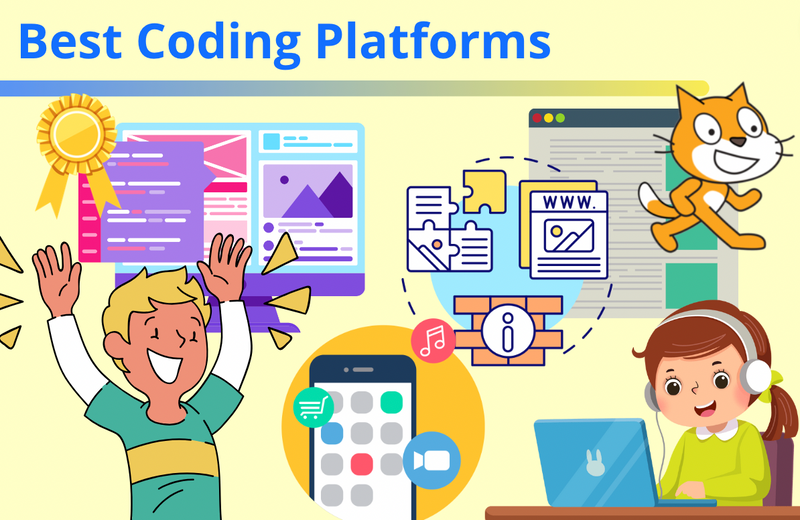
15 Remarkable Online Coding Platforms for Kids & Teens

25 Inspiring Computer Science Quotes

- Math for Kids
- Parenting Resources
- ELA for Kids
- Teaching Resources

How to Teach Number Formation in 5 Easy Steps
13 Best Resources for Math Videos for Kids: Math Made Fun
How to Teach Skip Counting to Kids in 9 Easy Steps
10 Best Math Intervention Strategies for Struggling Students
How to Teach Division to Kids in 11 Easy Steps
6 Best Alternatives to Public Schooling: A Guide for Parents
How to Cope With Test Anxiety in 12 Easy Ways
Developmental Milestones for 4 Year Olds: The Ultimate Guide
Simple & Stress-Free After School Schedule for Kids of All Ages
When Do Kids Start Preschool: Age & Readiness Skills
How to Teach Letter Sound in 6 Easy Steps
How to Teach Letter Formation to Kids in 9 Easy Steps
15 Best Literacy Activities for Preschoolers in 2024
12 Best Poems About Teachers Who Change Lives
6 Effective Ways to Improve Writing Skills
10 Best Game-Based Learning Platforms for Kids
60 Fun Animal Facts for Kids
12 Best Behavior Management Techniques for the Classroom
13 Best Online Teaching Tips for Teachers
How to Teach Kids to Write in 9 Easy Steps

15 Best Problem Solving Activities: Foster Critical Thinking
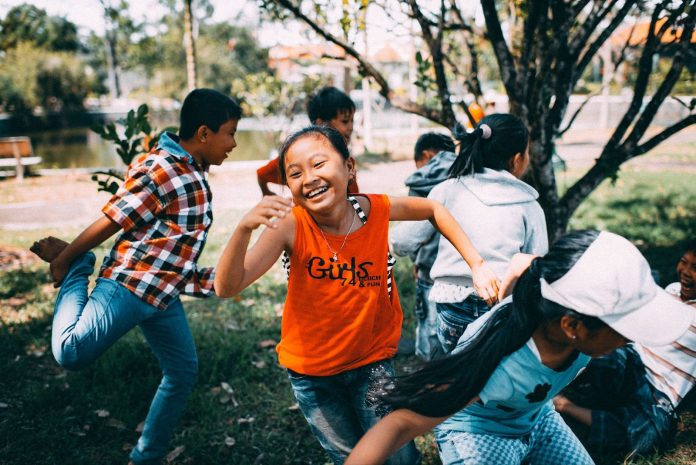
1. Rolling Dice
2. build a tower, 3. tic tac toe, 4. scavenger hunt, 6. activity books, 7. board games, 9. human knot, 10. open-ended questions.
Problem solving activities for kids are a great way to teach them how to think critically and creatively, and how to develop a growth mindset . We’re sure you must have also played many educational games as a kid that helped you develop critical thinking or problem-solving- skills you’re using even today. These activities can be tailored to be fun and engaging, and they help kids understand that challenges and difficulties are opportunities to learn and grow instead of things to be feared.
By providing kids with problem-solving activities, we can give them the tools to develop their problem-solving skills and build the confidence to tackle difficult challenges, which will be valuable to them throughout their life. It will also help them understand that their abilities can be developed with practice and hard work, encouraging them to persevere through difficult tasks and not give up easily when faced with obstacles. If you’re looking for some fun and engaging problem solving activities for children to develop a growth mindset, we have curated a list of activities for you.
SplashLearn: Most Comprehensive Learning Program for PreK-5

SplashLearn inspires lifelong curiosity with its game-based PreK-5 learning program loved by over 40 million children. With over 4,000 fun games and activities, it’s the perfect balance of learning and play for your little one.
15 Best Problem Solving Activities for Kids
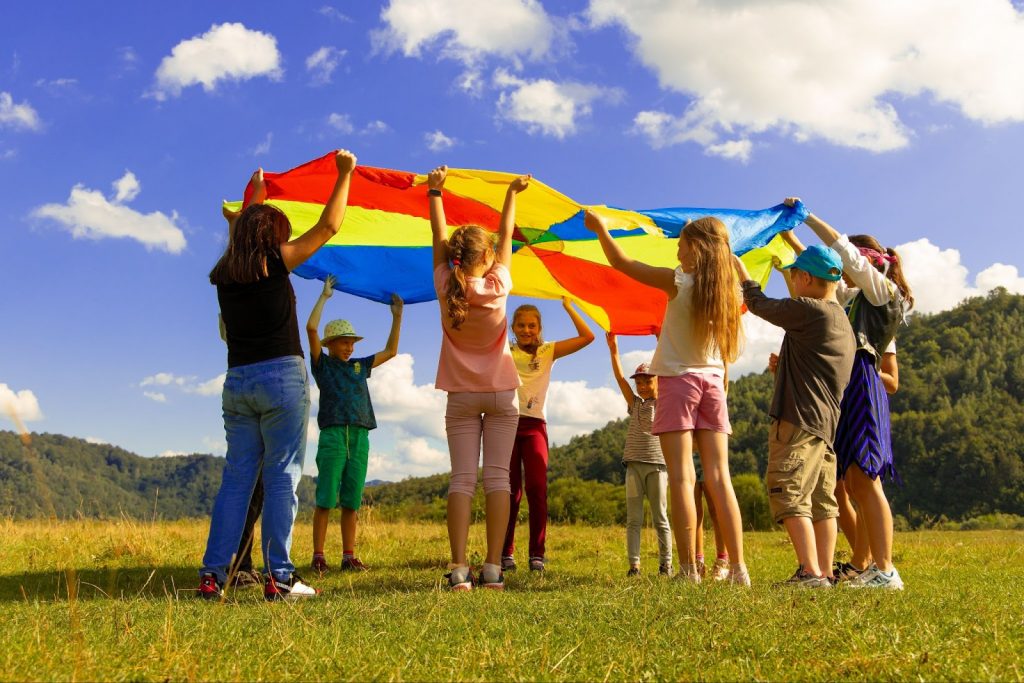
Things you’ll need: A die or dice, some flashcards and a pen
How to do: You can play tons of different games with dice. Playing with two dice encourages kids to quickly add up numbers and learn math in a fun way . One fun game you can play with a single die involves flashcards. For this game, you can assign a category to each number on the die and when the kid rolls the die, they have to name any 3 examples from the category assigned to the number rolled. For example, if number 4 is assigned to animals and it is rolled, they will have to name any 3 animals.
Things you’ll need: Building blocks, lego, toilet rolls or anything that can be stacked
How to do: If you’re looking for problem solving activities for 5 year olds, this is for you. To play this game, just give the kids anything that can be stacked on top of the other. This can be building blocks, lego, Jenga blocks, toilet rolls, etc. The challenge is to stack one on top of the other and see how high a tower they can build. This game can be played in teams or individually as well.
Things you’ll need: A tic tac tow board or pen and paper
How to do: This is one of the most exciting problem solving fun activities for students. You can either play this game on a tic tac toe board or on paper. If you’re playing it on paper, draw a table so that you have 9 boxes. Now each player must choose X or O and try to make a continuous row of their chosen symbol. Whoever succeeds wins.
Things you’ll need: Small toys, stationery items, or anything you want to include in a scavenger hunt
How to do: Assign the teams or individual players specific items they have to find in a defined area. This can be an indoor or outdoor activity for kids . Give them a list of the things they need to find, and you can also give them hints on where to find these things. Whoever or whichever team finds all the things first wins.
Things you’ll need: A puzzle game
How to do: Get a puzzle set. This can be a regular cardboard puzzle or a wooden puzzle and ask the players or teams to arrange it. You can make this a timed challenge or just let the kids solve the puzzle in their own time and have fun.
Things you’ll need: Activity books and pencils
How to do: This is one of the best problem solving activities for kids. Activity books are great for children’s problem-solving skills to develop. Buy them activity books containing games like find the element, what’s wrong with the pictures, or hidden picture books.
Things you’ll need: Board games like Ludo, Snakes and Ladders, Monopoly Junior, and Go Fish
How to do: Give them board games like Ludo, Snakes and Ladders, Monopoly Junior, Go Fish, etc. These board games help kids to develop logic, think deeper, plan ahead and solve problems.
Things you’ll need: A chalk
How to do: Build a maze with chalk on the sidewalk. Make sure you add a few dead-end ways to make it more challenging for the kids. Once the kid is able to walk through and come out of the maze, take the game to the next level by adding even more dead-end ways and see how they overcome the challenge.
Things you’ll need: Just a playground or garden
How to do: This is a great group activity for kids that’ll also teach them lots of skills. Ask the kids to form a circle and raise their right arm up. Now ask them to reach out to someone standing opposite to them in the circle and hold their left hand with their left hand. Now ask them to raise their left hands up and repeat the process with their right hands. The objective is to entangle them completely and then ask them to detangle themselves without letting go of anyone’s hands.
Things you’ll need: Pen and paper
How to do: Once you’re done with an activity, ask kids open-ended questions. These are questions that have no right or wrong answers. Some examples of such questions are- “Did you find this activity easy?”, “What did you enjoy the most about this activity?”, “How would you make this activity more fun?”, etc.
11. Wool Web
Things you’ll need: Balls of yarn
How to do: This is one of the most exciting group problem solving classroom activities for kids . Divide the players into equal teams and ask them to form a circle. Hand them over one ball of yarn each and ask them to make a web of it amongst the teams. Set a time limit for this step, and once it is done, switch the webs so that none of the teams has their own webs. Now the teams will decide on one player from each team to be blindfolded. This blindfolded player will have to untangle to web assigned to their team with the help of verbal instructions from their teams. The team that untangles the web first wins.
12. Fingertip Hula Hoop
Things you’ll need: Hula hoops
How to do: Divide the kids into teams of 6-8 for this game. Each team will stand in a circle and then be asked to raise their hands up. Now, place a hula hoop on top of their fingertips and ask them to bring it down slowly and make it touch the ground without it falling down or leaving the fingertips. The team to finish the task first wins.
13. Obstacle Course
Things you’ll need: Pillows, blankets, mattresses, cones, balls, chairs, etc.
How to do: Build an obstacle course indoors or outdoors with whatever you can find. This makes for one of the most engaging problem solving games for kids. Ask your kids to cross the obstacle course as fast as they can. To make it a bit more challenging, you can also ask them to race against each other to cross the obstacle course.
14. Memory Games
Things you’ll need: Playing cards
How to do: For this fun cards game, place all the cards face down and take turns to turn 2-4 cards. If you are able to open two similar cards (in number), you get to keep the pair. The player with the highest number of cards with them in the end wins.
15. Impromptu Plays
Things you’ll need: A stage
How to do: This is one of the best problem-solving exercises for kids to play in groups. If you have a large group, divide the kids into teams of 6-8. If the group is smaller, just make the kids stand individually. Now make a few chits on a theme that has questions that form a difficult situation or a challenge. For example, you can put in chits with questions like “You just found your friend cheating in an exam. What do you tell them?” or “Your younger sibling just broke your favorite toy. How do you react?”. Each team must enact a scene that includes the situation their chit has. If the group isn’t that big, each kid must speak about the same chit but have different perspectives.
Why Are Problem Solving Skills Important for Kids?
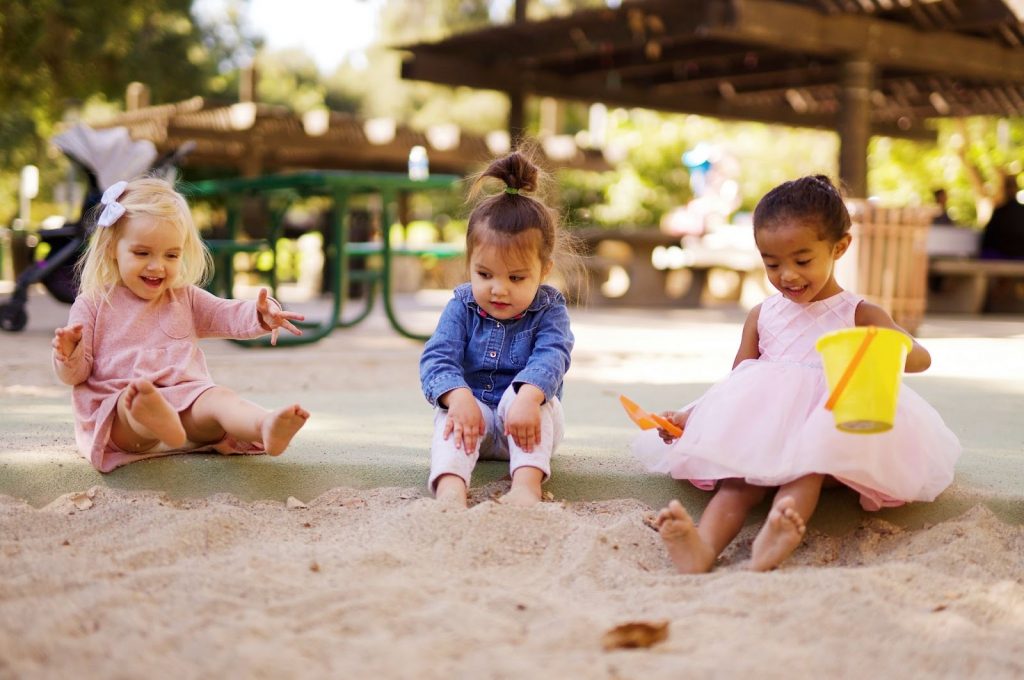
Developing problem solving skills is extremely important for kids as it helps them to navigate easily around difficulties later on in life. As adults, we’re faced with challenging situations every day, and without our basic problem-solving skills, we wouldn’t be able to survive.
Problem solving skills also help kids to make effective decisions. It helps them resolve problems all at once without reducing them to smaller problems. Once kids develop problem solving skills, it is easier for them to develop other skills as well like critical thinking, cooperation and collaboration with others.
Having problem solving skills helps kids to become more creative and think differently than others and enables them to become independent. These skills also help kids develop decision-making skills and build their confidence along the way as they take the right decisions.
Frequently Asked Questions (FAQs)
What are the 5 problem solving skills.
The five problem solving skills are identifying the problem, producing possible results that might work, picking one solution from these, applying the chosen solution and evaluating the results.
What are some examples of problem-solving skills in kids?
Some of the problem solving skills in kids are research, creativity, team-building, communication, active listening, decision-making, and analysis. If you find some of these skills in a kid, chances are they’re great at problem solving.
What is problem solving learning?
According to cornell.edu, Problem solving learning is an approach wherein students are asked open-ended questions about a certain topic, and they must resolve and answer the same in groups.
At what age do children begin problem-solving?
According to a study by Shaffer , kids can start developing basic problem solving skills from the age of three. This further continues to develop as they grow.
What are three problem-solving techniques
According to deakin.edu , the three most basic problem solving techniques are defining the problem, listing out all the possible solutions, and evaluating the options.
15 Best Movement Activities for Preschoolers in 2024
12 Best Activities for Kinesthetic Learners
15 Best Speech Therapy Activities for Toddlers
- Pre-Kindergarten
- Kindergarten
Most Popular

15 Best Report Card Comments Samples

117 Best Riddles for Kids (With Answers)
40 best good vibes quotes to brighten your day, recent posts.

75 Best Summer Quotes for Kids in 2024
Math & ela | prek to grade 5, kids see fun., you see real learning outcomes..
Watch your kids fall in love with math & reading through our scientifically designed curriculum.
Parents, try for free Teachers, use for free

- Games for Kids
- Worksheets for Kids
- Math Worksheets
- ELA Worksheets
- Math Vocabulary
- Number Games
- Addition Games
- Subtraction Games
- Multiplication Games
- Division Games
- Addition Worksheets
- Subtraction Worksheets
- Multiplication Worksheets
- Division Worksheets
- Times Tables Worksheets
- Reading Games
- Writing Games
- Phonics Games
- Sight Words Games
- Letter Tracing Games
- Reading Worksheets
- Writing Worksheets
- Phonics Worksheets
- Sight Words Worksheets
- Letter Tracing Worksheets
- Prime Number
- Order of Operations
- Long multiplication
- Place value
- Parallelogram
- SplashLearn Success Stories
- SplashLearn Apps
- [email protected]
© Copyright - SplashLearn

Make study-time fun with 14,000+ games & activities, 450+ lesson plans, and more—free forever.
Parents, Try for Free Teachers, Use for Free

1 (844) 773-3822
26 Powerful Problem Solving Activities for Kids
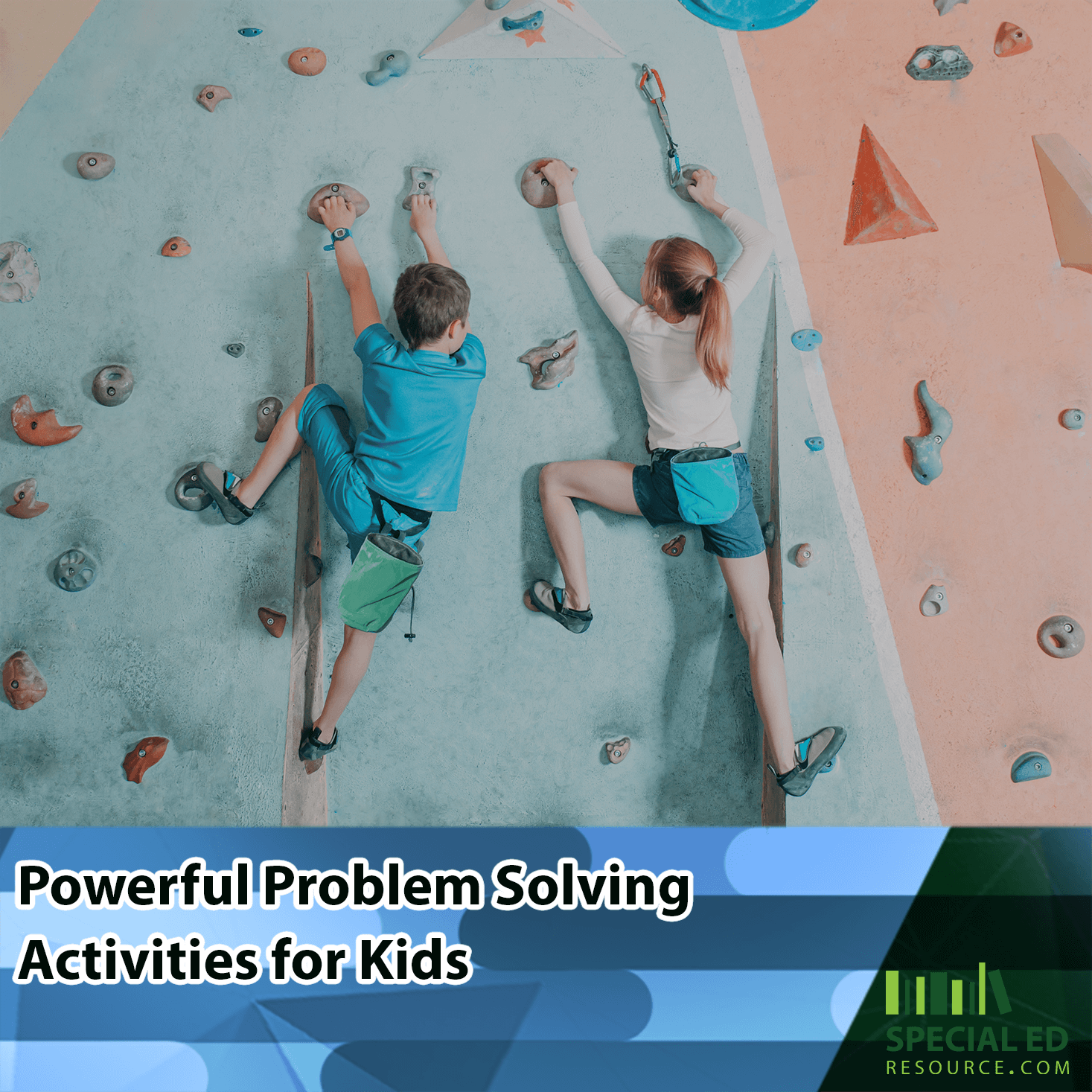
As you navigate the busy aisles of the grocery store, your child’s hand firmly in yours, you’re hit by a sudden realization. You’re not just shopping for groceries; you’re in the midst of an impromptu problem solving class.
Your child, curious and eager, starts asking you questions:
- “Why do we choose this cereal and not that one?”
- “How do we know how many apples to buy?”
In these moments, you’re more than a parent; you’re a guide, helping your child understand and navigate the world. It’s not always easy, especially when your child faces unique challenges.
You know their path is a little different, their learning style distinct. You want to equip them with skills beyond the basics and empower them to tackle the hurdles life throws their way.
Problem solving isn’t just about finding solutions; it’s about building resilience, confidence, and creativity.
You’ve seen it firsthand – the spark of understanding in your child’s eyes, the proud smile when they figure something out. These small victories remind you of the importance of nurturing these skills.
But where do you start? How do you turn everyday moments into enriching learning experiences?
One way is to challenge your children by regularly providing them with problem solving activities. Here is a list of ideas:
Want One-On-One Expert Help?!
Check this out.
#1 Puzzles and Brain Teasers
As you sit beside your child, engaging in a puzzle or brain teaser, you do more than spend quality time together. These activities are key in honing their problem solving skills, which are essential for their growth and development.
Why Puzzles and Brain Teasers Are Beneficial?
– enhances critical thinking: .
Your child learns to approach problems systematically, analyzing and forming strategies.
– Improves Concentration:
These activities require focus, helping your child develop a deeper concentration level.
– Builds Persistence:
Facing challenging puzzles teaches them not to give up easily, fostering resilience.
– Encourages Independent Problem Solving:
As they work through a puzzle, they learn to rely on their skills and intuition, boosting their confidence.
Examples for Different Age Groups
– younger elementary students (5-8 years): .
Start with jigsaw puzzles that have a moderate number of pieces. Simple word puzzles or riddles are also great to stimulate their thinking.
– Older Elementary Students (9-12 years):
Introduce more complex puzzles, like jigsaws with more pieces, logic puzzles, and basic Sudoku. These challenge their thinking and improve logical reasoning.
– Teenagers (13-18 years):
Engage them with advanced puzzles, such as 3D puzzles, crosswords, and challenging brain teasers that require abstract thinking.
When choosing these activities, consider your child’s interests and abilities to keep them motivated and engaged. It’s not about the complexity of the puzzle but the process of finding solutions and the learning that comes with it.
As they tackle these challenges, they’re not just solving puzzles. They’re building skills that will help them navigate the complexities of life.
Role-Playing Games
Envision your child diving into the world of a detective, a scientist, or a historical figure. Through role-playing games, they’re not just engaging in play.
They’re sharpening their problem solving skills imaginatively and dynamically.
Benefits of Role-Playing Scenarios
– fosters creative problem solving: .
Role-playing challenges your child to think on their feet, creating solutions in diverse scenarios.
– Develops Empathy and Social Awareness:
Taking on different roles helps them understand various perspectives, building empathy and social skills.
– Strengthens Communication Abilities:
These activities encourage clear and effective communication , vital for problem solving.
– Tailored to Individual Learning Styles:
Role-playing can be adapted to suit your child’s unique needs and interests, making it an inclusive learning tool.
Role-Playing Ideas
#2 mystery detective: .
Set up a mystery game where your child has to find clues and solve a case. This can be made more complex for older children, involving critical thinking and deductive reasoning.
#3 Historical Role-Play:
Have your child take on the role of a historical figure. They can navigate historical events, making decisions based on the context, which enhances their understanding of history and its challenges.
#4 Science Explorer:
Create scenarios where your child is a scientist or an explorer facing environmental or scientific problems. They can develop innovative solutions, fostering a love for science and exploration.
#5 Future World Builder:
Engage older children and teens in creating and managing a city or civilization in the future. This kind of role-play involves strategic planning, resource management, and ethical decision-making.
When engaging in these activities, the focus should be on learning through experience and fun. Encourage your child’s imagination, validate their ideas, and guide them through the problem solving process.
Remember, role-playing is a powerful tool that can make learning enjoyable and impactful for your child.
Building and Construction Projects
Whether it’s a simple craft project or a more complex construction task, these activities are not just about creating something tangible. They’re about building problem solving skills.
Why Building Activities Enhance Problem Solving?
– encourages practical thinking: .
As your child figures out how to assemble parts, they learn to think logically and sequentially.
– Develops Spatial Awareness:
Understanding how different pieces fit together improves their spatial intelligence.
– Fosters Creativity and Innovation:
They’ll learn to think creatively as they design and build, especially when improvising solutions.
– Teaches Planning and Organization:
Planning out a project helps develop organizational skills and forward-thinking.
Safe and Accessible Building Project Ideas
#6 cardboard creations: .
Use cardboard boxes to build anything from simple houses to intricate castles. This is safe, easy, and allows for endless creativity.
#7 DIY Birdhouse or Insect Hotel:
Older children can take on projects like building a birdhouse or an insect hotel, which involves more planning and precision.
#8 Recycled Material Sculptures:
Encourage your child to create sculptures using recycled materials. This not only sparks creativity but also teaches the value of recycling.
#9 Simple Woodworking Projects:
Consider basic woodworking projects for teenagers, like a small shelf or a picture frame. Ensure supervision and safety measures are in place.
Remember, the goal is to challenge yet not overwhelm. Start with simpler projects and gradually increase complexity based on your child’s interest and skill level.
Encourage their efforts, celebrate their successes, and most importantly, enjoy the process of building and learning together. This is where practical skills meet creativity, leading to effective problem solving.
Technology and Problem Solving Activities
In today’s digital age, apps and games can be much more than distractions; they can be tools for learning and development.
Why Technology Aids Problem Solving?
– interactive learning: .
Digital platforms offer interactive experiences that keep children engaged and actively learning.
– Adaptive Challenges:
Many apps and games adjust their difficulty based on your child’s progress, providing a continuous and appropriate challenge.
– Visual and Auditory Stimulation:
Graphics and sound in digital games enhance cognitive skills and problem solving abilities.
– Accessibility:
Technology can offer tailored learning experiences, especially beneficial for children with special needs.
Recommended Apps and Games
#10 puzzle games: .
Look for puzzle apps that challenge spatial reasoning and logical thinking. Examples include tangram-based games or block-fitting puzzles.
#11 Strategy Games:
Games that require planning and strategy, like turn-based strategy games or resource management simulations, are great for older children.
#12 Coding for Kids:
Introduce basic programming concepts through kid-friendly coding apps. These teach logical thinking and problem solving in a fun, interactive way.
#13 Educational Adventure Games:
Choose adventure games incorporating math, science, or language puzzles within an engaging storyline.
When selecting apps and games, focus on age-appropriate ones, considering your child’s interests and skill levels. The goal is to find digital tools that challenge and educate, not just entertain.
Encourage your child to reflect on what they learn and apply these skills beyond the screen. In this way, technology becomes a valuable ally in developing your child’s problem solving abilities.
#14 Escape Room Games
Visualize your child and their friends (or your family) immersed in the thrilling world of an escape room. This isn’t just an exciting game. It’s a dynamic learning experience where essential skills are developed as they work to solve puzzles and ‘escape.’
Benefits of Escape Room Activities
– teamwork: .
Escape rooms are a fantastic way for kids to learn the value of teamwork. They discover the importance of working together, communicating effectively, and sharing tasks to achieve a common goal.
– Critical Thinking:
These games push children to think outside the box. They must look beyond the obvious, develop creative solutions, and apply critical thinking to overcome challenges.
– Communication:
Effective communication is crucial in escape rooms. Your child learns to express their ideas clearly, listen to others, and collaborate to solve puzzles.
– Problem Solving:
Escape rooms are all about solving a series of puzzles. Kids learn to identify problems, analyze them, and develop creative solutions under pressure.
Creating an Escape Room Experience at Home
– diy home escape room: .
Set up a simple escape room at home. Use clues related to your child’s interests, and create challenging yet solvable puzzles. It can be a simple treasure hunt with clues leading to the next step.
– Escape Room Board Games:
There are board games available that mimic the escape room experience. These are great for rainy days or quiet evenings at home.
– Digital Escape Rooms:
There are also digital escape room experiences, perfect for children who enjoy online gaming. Choose ones that focus on teamwork and problem-solving that are age-appropriate.
Remember, the goal is to challenge and engage your child in a fun, collaborative way.
Through escape room activities, they enjoy an exciting adventure and develop essential life skills that will serve them well academically and personally.
#15 Indoor Rock Climbing
This activity is often overlooked, but it’s an incredible way for children of all ages and abilities to develop many skills beyond physical strength.
Multifaceted Benefits of Indoor Rock Climbing
– problem solving skills: .
As your child figures out the best climbing route, they use critical problem solving skills. Deciding which hold to grab next requires quick thinking and strategy, skills transferable to everyday challenges.
– Coordination:
Rock climbing demands a harmony of movements between hands and feet. This enhances your child’s coordination, a valuable skill in many other aspects of their life.
– Strength Building:
Climbing strengthens not just the arms and legs but the entire body. It’s a full-body workout that improves physical strength and endurance.
– Stamina Development:
Maintaining their position on the wall for an extended period builds stamina. This persistence is mirrored in their ability to stay focused on other activities.
– Focus and Concentration:
Successfully climbing requires complete concentration. Your child learns to focus their mind on the task at hand, a skill that’s invaluable in school and other settings.
– Self-discipline:
Rock climbing teaches self-control and emotional regulation . Staying calm and composed on the wall is essential for safety and success.
– Boosting Confidence:
Each climb is a boost to your child’s self-esteem . Believing in their abilities to reach the top instills a sense of accomplishment and confidence.
Getting Started with Indoor Rock Climbing
– find a kid-friendly facility: .
Look for indoor climbing centers that offer sessions for children. They provide the necessary equipment and guidance in a safe environment.
– Start with Basic Walls:
Begin with walls designed for beginners, gradually moving to more challenging climbs as your child gains confidence and skill.
– Encourage Regular Practice:
Consistency is key. Regular climbing sessions will help your child improve their skills steadily.
Remember, rock climbing is not just about reaching the top; it’s about the journey. Each step your child takes up that wall is a step towards building essential life skills in a fun, engaging, and challenging environment.
#16 Obstacle Courses
Imagine setting up a fun, engaging obstacle course in your backyard or living room. This isn’t just an entertaining activity for your child. It’s a comprehensive learning experience that builds many life skills.
Valuable Life Skills Gained from Obstacle Courses
– teamwork and cooperation: .
Obstacle courses often require collaboration. Your child learns the importance of working together, sharing strategies, and helping peers to achieve common objectives.
Each obstacle presents a unique challenge. Your child learns to think quickly, devise strategies, and find creative solutions to navigate through them.
– Perseverance and Determination:
Obstacle courses can be challenging, teaching your child the value of persistence and grit. They learn to keep trying, even when faced with challenging tasks.
– Large Motor Fitness:
These courses are excellent for enhancing physical fitness, improving strength, balance, and coordination.
– Mental Fitness:
Besides physical agility, obstacle courses sharpen mental skills like focus, concentration, and stamina.
Setting Up a Simple Obstacle Course
– indoor course: .
Use household items like chairs, cushions, and tables to create a safe indoor course. This can include crawling under tables, hopping between cushions, or balancing along a taped line on the floor.
– Outdoor Course:
Use natural elements like trees, hills, or simple items like ropes and hula hoops for outdoor space. Set up tasks like weaving between trees, climbing small hills, or jumping through hoops.
– Incorporate Diverse Activities:
Add variety to your course with activities like throwing a ball into a bucket, balancing a book on the head, or hopping on one foot. This keeps the course dynamic and engaging.
Remember, the primary goal is to have fun while learning. Encourage your child, celebrate their successes, and perhaps even join to model teamwork and sportsmanship.
Through obstacle courses, your child enjoys physical activity and develops crucial life skills in an exciting and hands-on way.
Cooking and Baking Projects
Cooking and baking are not just about creating delicious treats; they’re an excellent way for your child to learn and practice many skills.
Skills Developed Through Cooking and Baking
– math and measurement skills: .
Recipes require measuring ingredients, which is a practical way for your child to learn about fractions, volumes, and weights.
– Reading and Comprehension:
Following a recipe improves reading skills and comprehension. Your child learns to follow instructions and understand the sequence of steps.
– Science and Chemistry:
Cooking is a fun way to introduce basic science concepts. They’ll learn about chemical reactions, like how yeast makes dough rise or how heat changes food.
– Creativity and Experimentation:
Encourage your child to be creative, whether decorating cookies or experimenting with flavors. This fosters their artistic side and teaches them about trial and error.
– Life Skills and Independence:
Cooking and baking are essential life skills. By learning these, your child gains a sense of independence and accomplishment.
Ideas for Cooking and Baking Projects
#17 simple recipes: .
Start with easy recipes like no-bake cookies, fruit salads, or sandwiches. These are perfect for younger children.
#18 Theme Cooking:
Make cooking more engaging by tying it to a theme or a subject they’re learning in school, like baking pies when learning about circles in math.
#19 International Cuisine:
Explore recipes from around the world. This not only introduces new flavors but also teaches about different cultures.
#20 Weekly Cooking Day:
Dedicate one day a week to cook or bake something special with your child. It could be a time to try new recipes or perfect old favorites.
Remember, the kitchen is a fantastic classroom. It’s a place where your child can learn, make mistakes, and enjoy the fruits of their labor! Encourage them, guide them, and most importantly, have fun together in this delicious learning journey.
Incorporating Everyday Situations
As you go about your daily routine with your child, consider the myriad learning opportunities in these simple moments. Everyday tasks, often overlooked, are fertile ground for developing problem solving skills.
Turning Routine Activities into Problem Solving Exercises
#21 grocery shopping: .
Turn a regular shopping trip into a math lesson. Have your child help with making a budget, calculating discounts, or comparing prices. They learn about money management, estimation, and decision-making.
#22 Planning a Route:
If you’re heading out to multiple places, involve your child in planning the route. Discuss factors like distance, time, and traffic. This teaches them about logistics, time management, and geographical orientation.
#23 Organizing Spaces:
Ask your child to think of the best way to organize it, whether it’s their room, a bookshelf, or the living room. This encourages them to think about space utilization, categorization, and orderliness.
#24 Meal Planning:
Involve them in meal planning for the week. They can help decide the menu, ensuring a balance of nutrition. This teaches them about health, planning, and the importance of variety.
#25 DIY Home Projects:
Simple home projects, like planting a garden or painting a fence, can be excellent problem solving exercises. They learn about the process, the necessary materials, and the steps to complete a project.
#26 Time Management:
Encourage your child to plan their day or week, balancing schoolwork, chores, and leisure. This helps them develop critical time management and prioritization skills.
Each of these activities, while mundane, is an opportunity for your child to think critically, make decisions, and solve problems.
The key is actively involving them, asking open-ended questions, and encouraging them to think through their choices.
This way, everyday tasks become more than just chores. They become stepping stones in your child’s developmental journey.
Tips for Success
As you embark on these activities with your child, keeping them engaged and motivated is crucial. Here are some practical tips:
Keeping Children Engaged and Motivated
– set achievable goals: .
Start with simple tasks and gradually increase the difficulty. Achieving these smaller goals will boost your child’s confidence and motivation.
– Incorporate Their Interests:
Tailor activities to include your child’s hobbies or favorite subjects. This personal connection makes learning more exciting and relatable.
– Offer Positive Reinforcement:
Praise their efforts, not just the outcomes. Celebrate their progress and perseverance, which encourages a growth mindset .
– Create a Routine:
Establishing a consistent activity schedule helps build discipline and a sense of anticipation.
– Provide Choices:
Give your child options in activities or ways to complete them. This sense of control can be very motivating.
– Break Down Tasks:
For complex activities, break them into smaller, manageable steps. This makes the task more manageable and more approachable.
Adapting Activities for Children with Special Needs
– simplify instructions: .
Use clear, concise language and visual aids if necessary. Breaking instructions into smaller steps can be very helpful.
– Flexible Approach:
Be open to adapting activities based on your child’s needs. This could mean altering the pace, reducing sensory inputs , or providing additional support.
– Incorporate Sensory Activities:
For children who benefit from sensory input, include activities that engage different senses .
– Use Assistive Technology:
For children with physical or learning disabilities, utilize available technology to facilitate their participation and learning.
– Foster a Safe Environment:
Ensure the learning environment is safe, supportive, and free from unnecessary pressures or distractions.
– Collaborate with Educators and Therapists:
Work with your child’s teachers or therapists to align activities with their educational and therapeutic goals.
Remember, being patient, adaptable, and responsive to your child’s needs and responses is vital. Your support and encouragement can make a significant difference in their learning journey.
As you step into this journey of enriching your child’s learning through these diverse activities, remember that each moment spent together is about achieving a goal and creating lasting memories and invaluable learning experiences.
Your role in guiding and supporting your child through these activities is a powerful force in their development.
We would love to hear about your adventures and discoveries. Share your stories with us in the comments below!
Whether it’s the proud smile of your child solving a puzzle, the excitement of completing a DIY project, or the laughter that fills your kitchen during a cooking session, your experiences can inspire and encourage other parents embarking on similar journeys.
Additional Resources for Learning
- 29 Fun Activities to Help Kids Focus (With Proven Results)
- Fun Winter Break Activities for Kids Guaranteed to Bust Boredom
- 21 Simple & Fun Gratitude Activities for Kids
- The Ultimate Guide to Summer Learning Activities (Your Child Will Love)
If you enjoyed this article, please consider sharing it on Pinterest and Facebook. Join our Special Ed Parenting Facebook Community to connect with other parents of special needs children.
Do you have a child that needs one on one assistance?
We offer one-on-one special education tutoring that can be done from anywhere the student is! Why? Because our special education experts conduct their sessions online!
Get started with a free consultation today!
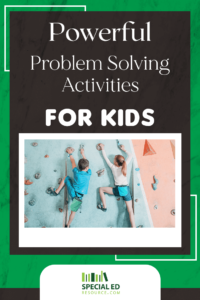
Shannah Holt
Leave a reply cancel reply.
Your email address will not be published. Required fields are marked *
Name *
Email *
Add Comment *
Save my name, email, and website in this browser for the next time I comment.
Post Comment
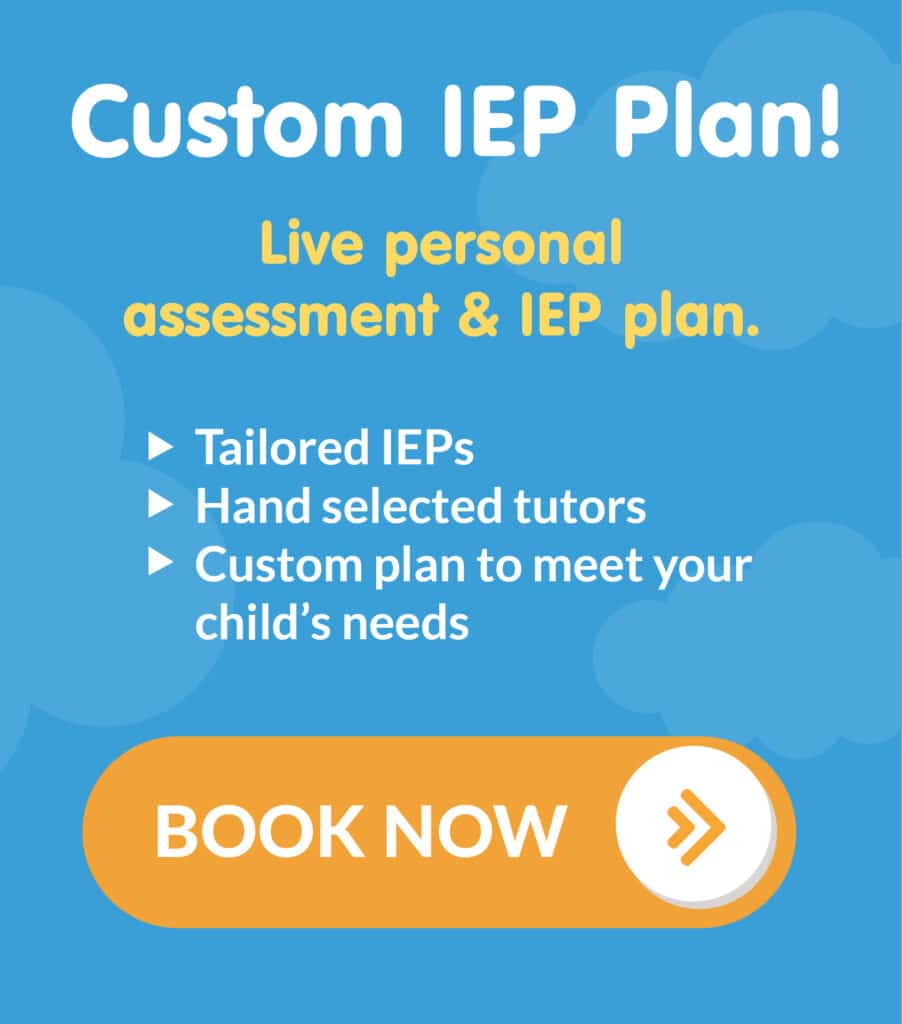
Our Services
- Special Education Tutoring
- IEP Consulting
- Special Needs Advocacy
- Home Schooling

Popular Articles
7 step iep process.
- Creative Writing Activities
- Activities to Help Kids Focus
- Self-Contained Classroom Defined
- 10 Benefits of Special Needs Tutoring
- Classroom Accommodations for Executive Function Disorder
- 45 Executive Functioning Activities for Kids 5-12
- What is Nonverbal Learning Disorder (Signs of NVLD)
- What is Executive Function Disorder in Children?
- 105 Creative Spring Writing Prompts for Kids and Teens
- Student Accommodations for Auditory Processing Disorder
Think Differently About Education. We Believe…

We assess your child’s learning style, personality, and interests to pair them with the ideal special ed tutor based on their individual needs.

Through technology and one on one learning, their future path to success can be made clear again.
Are you ready to see confident progress in your child?
Get started with a no-obligation consultation today!

There are hundreds of resources found on our website, SpecialEdResource.com, and on our YouTube channel that were created to help parents JUST LIKE YOU understand the cryptic language of special education.
Important Links
Copyright © 2024 SpecialEd Resource – Design by DeskTeam36 0
- Terms & Conditions
- Privacy Policy
- Join Your Trial Class
- Book FREE Trial Now

Top 15 Problem Solving Activities for Kids [2022 List]
As they get older, children have countless opportunities to learn about the world. They do, however, face issues daily, whether it be peer pressure, complex mathematical computations, or arguments with their peers.
The advantages of problem-solving abilities for children are vast, and they may help them deal with such circumstances efficiently.
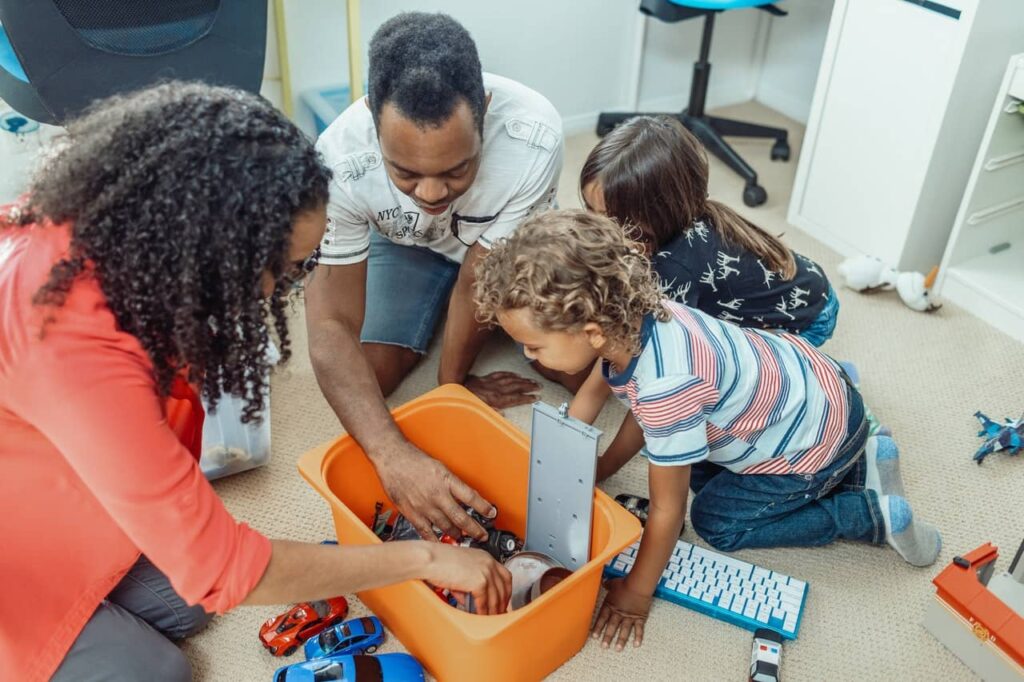
They will learn to develop practical answers on their own, without the assistance of an adult. Furthermore, when faced with challenges, students will be more confident in their abilities to use problem-solving skills and generate unique solutions on their own.
Read on to learn about the importance of problem-solving abilities in children, how to install this talent in them, and some activities to help them develop this important skill.
Table of contents
- The Importance of Problem Solving Skills in Children
- How to Teach Children Problem-Solving Skills?
- 15 Problem Solving Activities for Kids
The Importance of Problem Solving Skills in Children
Children gain from problem-solving in a variety of ways. It is beneficial to them.
- Deal with problems in regular life.
- Make sound judgments.
- Along the way, learn additional skills including teamwork, critical thinking, and collaboration.
- Problems should be solved without being broken down.
- Consider thinking beyond the box.
- Develop your independence.
How to Teach Children Problem-Solving Skills?
Here are a few ideas for encouraging your child to use their problem-solving abilities.
- Put it to the Test!
Encourage your youngster to accept the challenge when they are confronted with a problem. If the outcomes are unsuccessful, they might try different strategies.
Your child will be able to think about a subject from several angles as a result.
- Seek Counsel
Decision-making is a tough task. For example, you could have difficulty deciding what to prepare for supper or what to wear to the movies. Asking your children for assistance in decisions is an excellent choice.
When you approach them for guidance, they believe that they are not alone in their struggles. When you appreciate their ideas, they will gain the confidence to tackle challenges on their own.
- Take a Long, Deep Breath.
Maintaining your calm in difficult situations is one of the first steps toward effective problem-solving. Even among children, when their emotions run wild, it is difficult to think sensibly, and the temptation to make rash judgments increases.
It is critical to encourage your youngster to take deep breaths whenever they feel out of control of their emotions. They can better appraise the problem once they are calm.
- State the Issue Verbally.
Your child should openly express how they feel and what they are going through when they have calmed down. It provides them with a distinct perspective and facilitates the generation of alternate solutions.
- Do not give “The Solution”
It is not a good idea to provide immediate solutions to children’s problems. Instead, provide them with advice to assist them in solving the problem on their own. This will help them to think about solutions that are beneficial to them.
- Set a Good Example
Children quickly absorb knowledge like sponges. Therefore, when you approach an issue and find a workable solution, children will be inspired by your strategy and want to follow you.
- Allow the Natural Consequences to Play out.
Allowing a situation to take its course is sometimes the best approach to dealing with it. So, if your child encounters a challenge, let them be.
Assume your child spent their entire weekly allowance in a day or two; allow them to go the entire week without receiving any money. This will position them to make better decisions in the future.
15 Problem Solving Activities for Kids
There is no better way to learn than by playing. The following exercises are enjoyable and challenge youngsters to demonstrate their problem-solving abilities.
- Riddles
Riddles for kids are fantastic games for problem-solving. They come at various levels of difficulty. The appropriate one may be chosen based on your child’s age.
If you give children a puzzle, they will learn to consider the issue or question, generate potential answers, and select one.
Additionally, the practice will help students improve their hand-eye coordination, gross motor skills, and critical thinking. Also, if your kids have a way with words then what better than to engage them in wordle for kids !
- Scavenger Quest
Scavenger hunts are an instructive activity that every parent should offer to their children. It is a low-cost, easy, and entertaining activity that can be practiced both inside and outside and just requires materials you already have at home.
The activity encourages youngsters to think beyond the box. They are pleasantly acquiring problem-solving skills without even realizing it.
- Storybooks
The advantages of reading are countless. Problem-solving is one of them. While reading, children are introduced to several characters and their roles. They frequently connect with these figures. Undoubtedly, stories for kids are great resources to stimulate their minds!
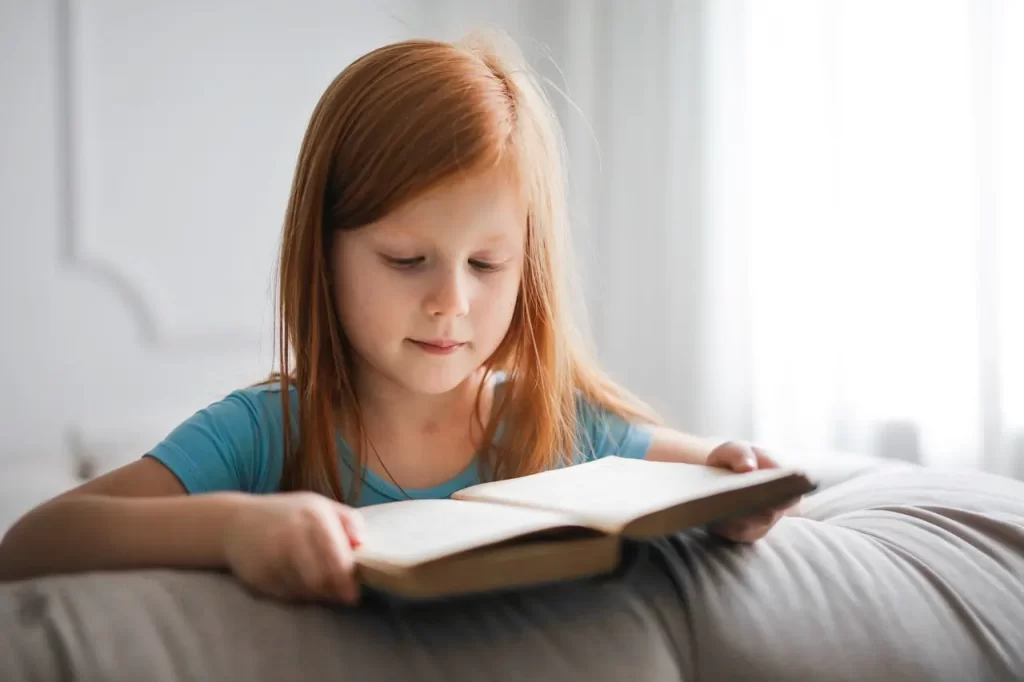
So, if kids encounter an issue, ask them how their favourite character would solve it. Encourage them to produce as many options as they can and discuss the results of each.
- Arts and Crafts
Another fantastic technique to educate youngsters about problem-solving abilities is via arts and crafts. Give your child a variety of things from around the house. Allow them to create fantastic creations or repair damaged devices or toys. Also checkout art hub for kids that can provide an immersive experience to your little ones!
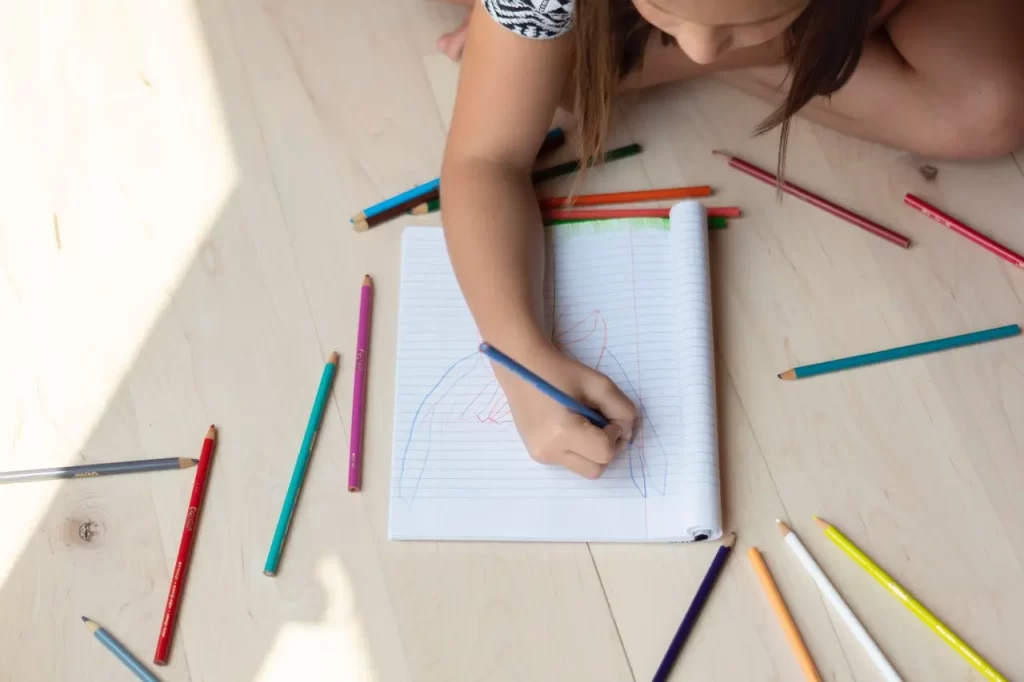
Give them complete freedom to do their task and only offer guidance when they are running out of ideas. And if your kids like to be more hands-on then check out crafts for kids !
- Free-Form Questions
Asking open-ended questions is an excellent method to help your child think creatively and critically and develop their problem-solving abilities.
As there are no right or wrong answers to these questions, and the answer extends beyond a simple “no” or “yes,” they must give some consideration to their responses.
The questions mentioned in the image above are some examples of open-ended questions.
- Maze
Mazes are enjoyable and safe for people of all ages. Working on mazes forces them to think. The practice also helps them strengthen their motor skills, observation skills, sense of direction, and problem-solving abilities.
Think beyond book mazes. There are other maze games available on the internet. They will get better at finding their way out with practice. You may eventually give them increasingly difficult mazes to solve.
- A Little Treasure Quest
The whole family can enjoy a treasure hunt. If they believe they will succeed, you can maintain their concentration on the task at hand.
Give them tips that encourage them to use their imaginations and resolve issues to win the prize.
- Toy Construction
Give your kids building materials like LEGO, wood blocks, engineering blocks, etc., and let them construct anything they want.
Toy construction requires your child to consider what to make, how to assemble the parts, and produce creative solutions to make sure the design is functional.

You can occasionally ask them to build something challenging, like a monster with three arms or two buildings joined by a bridge. Watch as they struggle to come up with a structure.
- Woollen Web
Each child should be given a piece of colorful yarn, and they should be told to construct a circle. The yarn ball is passed from one person to the next by wrapping their finger around it.
Once everyone got an opportunity to hold the ball and wrap the yarn around their finger, a web would begin to grow. Now, blindfold one person and instruct them to unwind the web by following the vocal directions of the others.
To figure out a way out, this group exercise requires collaboration, attention, patience, coordination, concentration, and problem-solving abilities.
- The Human Knot
It is a simple game, but very entertaining. A group of youngsters is required for this game. Form a circle with the youngsters and have them raise their hands.
Begin with one player, who must use their right hand to grasp a player’s hand from across the circle and their left hand to grasp someone else’s hand. Examine whether everyone has held both hands with various players.
They must now detangle themselves without breaking the circle. When everyone’s hands are free and they are back in the circle, the challenge is over.
- Improvised Skits
Form teams out of the players. On pieces of paper, write out several scenarios, such as coping with bullying at school or resolving a quarrel between siblings, folding them, and arranging them in a bowl.
Each team or participant chooses a chit and executes the scenario. You may give them a deadline to get ready. These impromptu activities help kids see a problem, come up with a solution, and implement it.
- Group Drawing
Another excellent team-building activity for developing children’s problem-solving skills is group sketching. Form groups of three youngsters.
Each of the team’s three members has a certain function to play. The teacher comes next. The instructor is the one who offers the drawer verbal directions on how to draw a certain design.
The spectator examines the design. However, they are not permitted to speak and must interact with the instructor by using gestures. When the viewer is happy with the drawer’s image, you have a winner. Allow the kids to take turns playing various parts.
- Give me a Hint!
Clue Me In is an entertaining detective game that promotes cognitive growth, critical thinking, and problem-solving skills.
Begin by choosing five to six target responses, such as a prominent figure, an animal, a historical event, a societal trend, or a career. Collect five to ten objects related to each goal answer. They might also be images from the Internet.
Sort them into various bags. Determine how many hints a child can select before making a guess. If there are two, let the youngster choose two clues from a bag and make their first guess. See who can respond the fastest.
- Survivor Case Studies
Here is another game where no items are required. In this game, you must construct pretend-play scenarios for youngsters to solve, and they must analyze and think creatively to do so.
For example, tell them, “You’re stranded on an island, and you know aid won’t arrive for two days” or “How will you build a shelter for yourself out of the materials around you?”
Kids are encouraged by this to think of many scenarios and come up with solutions to the problem. There are many programs for kids .
- Ethical Quandary
Children are frequently put in challenging circumstances. This simple game will help children deal with these situations without them even being aware of them.
Write down several difficulties on pieces of paper, such as “The cashier handed me $1 more in change; what should I do?” or “I watched my friend harassing someone at school.” Should I intervene or let them go? Fold it up and put it in a bowl.
Give each child the opportunity to select one piece of paper, read it aloud, and provide creative solutions to the problem at hand.
Are you interested to know more about kids coding languages ? Checkout here!
Problem-solving is a crucial skill to have. Guiding kids in this decision-making skill not only enhances their thinking and creative ability but also trains them to face problems in the future and figure out good decisions.
The above-mentioned activities for kids are some of those, that will help them develop decision-making skills.
To learn more about problem-solving activities for kids, check out the fun yet amazing articles on the BrightCHAMPS blog.
Frequently Asked Questions (FAQs)
Children are believed to have learned the basics of problem-solving by the age of three. However, it is not perfected since it is hampered by a short attention span and trouble grasping problems on its own. Children grow better at solving problems as they get older.
The three most prevalent problem-solving techniques are: ● Trial and error: trying several solutions to an issue until it is solved. ● Algorithm: The process of solving a problem by following a step-by-step formula. ● Following a problem-solving framework, such as breaking it down into steps, is a heuristic.
These games can help you improve your problem-solving, planning, multitasking, and pattern-identification skills. ● Crossword puzzles. ● Sudoku puzzles. ● Jigsaw puzzles. ● Chess. Board games. ● Computer games. ● List games.
Creative problem-solving is a technique that employs imagination and invention. This technique encourages the creative aspect of issue resolution and allows for the generation of fresh ideas in novel ways. It also makes the process more enjoyable and fosters teamwork. To get your hands on more educational and free resources on coding for kids , robotics for kids, financial education for kids , etc., do check out the BrightCHAMPS Page now!
Team BrightChamps

Email Address

Free Kids Coding Resources 📕
Receive a copy of our Top 10 FREE Resources for your Kids
Success🎉 Check your email for more info!
Get a talent discovery certificate after trial class.
100% Risk-Free. No Credit Card Required

Related Articles

Navigating Parenthood: Simple Tips for Dealing with Behavioral Challenges in Kids
by admin | Apr 9, 2024
Parenting is a journey filled with joys, but it also comes with its fair share of challenges. One of the most common challenges parents face is...

Easing the Burden of Anxiety: Practical Tips for Parenting Anxious Teens
by Team BrightChamps | Feb 15, 2024
The adolescent years are a time of profound growth and change, marked by the pursuit of identity, independence, and the navigation of social...

Ready, Set, School! Simple Advice for Parents on School Readiness
by Team BrightChamps | Feb 13, 2024
Preparing children for school is like laying the foundation for a sturdy building. Just as a solid foundation ensures a structure's stability,...

Trending Articles

Financial Literacy Activities for High School Students: Engaging and Practical Learning
by Team BrightChamps | Apr 10, 2024
As young adults step into the world of independence and responsibility, the importance of financial literacy cannot be overstated. Equipped with the...

Online Learning Platforms for Kids: A Comprehensive Guide
Over the past few years, online learning platforms for kids has seen a significant rise in popularity. This trend has been fueled by various...

20 Awesome Problem-Solving Activities for Kids
Kids are natural problem solvers. But if you don’t help them to cultivate this skill, it will become harder for them to solve problems as they grow older. According to Marlborough , problem-solving is undoubtedly one of the most critical skills that children need to develop. And they learn best by trying things out and exploring their environment. As parents, it is our job to foster this natural curiosity and help our children develop the skills they need to solve problems effectively. This blog post will share 20 fun problem-solving activities for kids ! These activities will help your child develop critical thinking skills, creativity, and perseverance.

20. Scavenger Hunt
One of the best ways to encourage problem-solving is to set up a scavenger hunt. According to Scholastic , scavenger hunts have a myriad of benefits. It is an activity that can be done indoors or outdoors, depending on your preference. You can hide clues around the house or backyard and have your child solve them to find the next clue. Your kids will have to think outside the box to solve the clues, and they will have a blast doing it. If you want to make the scavenger hunt more challenging, you can give your child a list of items to find instead of clues.
19. Jigsaw Puzzles
Sometimes the simplest ideas help sharpen your child’s problem-solving skills the most. Jigsaw puzzles are a great way to do just that. These puzzles are available for children of all ages. However, their complexity varies. You can start with a simple puzzle with just a few pieces for younger children. And as they get better at it, you can gradually increase the number of pieces. The key is finding a challenging but not too difficult puzzle for your child. As your kids learn to solve them, they’ll also develop incredible problem-solving skills.
18. Treasure Map
Another fun problem-solving activity for kids is to create a treasure map. This great activity is ideal for kids who love to explore. You can create a simple map with clues leading to a treasure. The ultimate goal is to encourage your kids to use problem-solving skills to navigate the map and find the treasure. While at their critical thinking skills will undoubtedly improve.
17. Obstacle Course
An obstacle course is a great way to encourage problem-solving and physical activity. You can create an obstacle course using everyday objects. For example, you can use chairs, cushions, and blankets to create a course in your living room. Or you can use cones and balls to create an outdoor course. The key is to be creative and have fun with it. As your child navigates the course, they must consider the best approach to overcome each obstacle. And this will help them develop critical thinking and problem-solving skills. It is also great to get your child moving and burn off some energy.
16. Building Towers
Most kids love to build something using different items. According to Raisingchildren , building blocks impart critical skills in kids. For this reason, building towers is an excellent problem-solving activity for kids. It helps them use their imagination and be creative. You can give your child different materials to build a tower, such as blocks, Lego, or even toilet paper rolls. The taller the tower, the better. This activity will help your child develop problem-solving skills as they learn how to balance the materials to create a stable structure.
15. Card Mix Up Games
Cards are versatile playthings that offer many opportunities for problem-solving fun. For example, you can play the classic card game Solitaire. Such a game demands patience, strategic thinking, and problem-solving skills. You can also try a memory game using cards. It is an effective way to improve your child’s memory, as well as their problem-solving skills. Many other card games offer a challenge and help kids sharpen their problem-solving skills. So, next time you are looking for a fun activity for your kids, consider playing a card game.
14. Board Games
Board games are quite challenging and stimulating for the brain. They help develop decision-making, strategizing, and critical thinking skills in children. But most importantly, board games are available in a wide range of difficulty levels. So, you can find the perfect game to match your child’s skills and abilities. Checkers, chess, and backgammon are excellent board games that help kids develop problem-solving skills.
13. Science Experiments
Science experiments are another option for problem-solving activities for kids. It helps them learn about cause and effect. And it also allows them to be creative as they try to figure out how to make the experiment work. There are a variety of simple science experiments that you can do at home with your kids. For example, you can try the classic baking soda and vinegar experiment. Or you can try the popular Mentos and Diet Coke experiment. These are just two of many possibilities. However, these activities may not be the best for younger children, as they might not understand what is happening.
I spy is an exciting and challenging activity. And for this reason, it is a perfect problem-solving activity for kids. It helps them improve their observation skills and learn to pay attention to detail. I spy also great for developing memory skills. To play, you will need to choose an object in the room. Then, give your child clues about the object until they can identify it. For example, you might say, I spy with my little eye something red and round. The clues should get progressively harder as the game goes on. This will help to keep your child engaged and challenged. The best part is that kids can play this game anywhere. All you need is your eyes and some objects. The game’s objective is to find an item the other person is thinking of.
11. What’s Missing?
What’s missing is a fun and simple game that most kids enjoy. To play it, you can start by putting a bunch of objects on a tray or in a box. Then, please have your child close their eyes while you remove one of the objects. When they open their eyes, they must use their problem-solving skills to determine which object is missing. As you can see, this activity keeps kids on their toes. And it helps them refine their problem-solving skills as they learn to pay attention to detail.
10. Simon Says
Simon Says is a classic game that most people know. But if you have never played it before, it is simple. One person is Simon, and the other players must do what Simon says. For example, Simon might say, Touch your nose. The other players would then have to touch their noses. However, if Simon does not say the word Simon before the command, the players do not have to do it. According to Emergepediatrictherapy , other Simon’s benefits include motor and sequences skills.
9. Memory Games
Memory games are excellent activities to nurture your kid’s problem-solving skills. A memory game requires players to remember where certain items are and then retrieve them. Depending on your child’s ability, these types of games can be simple or complex. You want to consider your child’s age as you decide their best difficulty level. Once you identify the level of difficulty, you can start the game. The game’s objective is to remember where the objects are and then find them. You can offer a reward for the child who can find the most items.
8. Move an Object
Moving an Object may sound like the most straightforward activity for kids. However, it is an invaluable problem-solving training tool. You ask your kids to move something. It could be a toy, a chair, or even themselves. But there’s a catch. Give them restrictions on how to move the object. For example, you might say, You can only use your left hand, or You have to move it without touching it. These restrictions force kids to think outside the box and create creative solutions.
7. The Alphabet Game
The Alphabet Game is an incredible tool to help kids learn and refine their problem-solving skills. To play, you will need a list of items that start with each letter of the alphabet. So, how does it work? Well, you can either give your child a list of things, or they can make their own. Once they have the list, they have to find an object that starts with each letter of the alphabet. For example, if their list includes A for apple, they would need to find an apple. This game can be played alone or with a group of people. And it can be as easy or difficult as you make it. If you want to make it more challenging, you can give your child a time limit to find the objects.
6. Role Play with Prompt
Role play with a prompt is a challenging activity that requires kids to use their problem-solving skills. To play, you will need a list of prompts. These can be anything from What would you do if you were stuck in a room with a lion? To What would you do if your best friend was moving away? The key is to choose open-ended prompts that allow for multiple solutions. Once you have your list of prompts, give each child a turn to choose one. Then, they will have to role-play the situation. This activity is superb for shy or introverted kids because it allows them to solve their problems safely and in a controlled environment.
Whether on paper or in a digital format, mazes are excellent problem-solving activities for kids. Mazes require players to find their way from start to finish without getting lost. To make it more challenging, you can add obstacles or time limits. Although mazes can be played alone, they are also ideal for groups. When played in a group, mazes require kids to communicate and work together to find a solution. They provide a superb opportunity to problem solve.
4. Free Play
Free play is an important problem-solving activity for kids. It allows them to explore their environment and find creative solutions to problems. Free play can be anything from playing with blocks to exploring the backyard. The key is to let kids direct their play. They will attempt to do many different things in the process, and some will fail. But that is okay. Failure is an important part of the learning process. Free play allows kids to try new things, make mistakes, and learn from them. According to Unicef , free play promotes imagination and creativity among kids.
Crafts are wonderful for problem-solving. And kids love them. They want to try different types of crafts and all times. So, how can crafts help kids with problem-solving? Well, first of all, they require kids to think about what they are doing. They have to plan and execute their craft project. As different challenges arise, they must figure them out and achieve their objectives. Secondly, crafts often involve following instructions. This is another excellent opportunity for kids to practice their problem-solving skills.
2. Reading Story Books
Most storybooks are thoughtfully written for entertainment and fun. They are also known to subtly impart moral and social values to children through the various characters in the story. However, storybooks can also be used as problem-solving activities for kids. They often present the main characters with a problem they must solve. As children read along, they will have to think about it. Look for stories with characters who face challenges and have to figure out solutions. As you read, discuss the characters’ different options and what might happen if they choose each. It will help kids understand that there are often multiple ways to solve a problem.
1 . Penny Drop Challenge
The Penny Drop Challenge is one of the kids’ most challenging and fun problem-solving activities. It requires them to use their logic and reasoning skills to figure out how to drop a penny into a glass without touching the sides of the glass. The game is also quite competitive, which makes it even more exciting. You will need a clear glass, a piece of paper, and a penny to play. Fold the paper into a funnel and place it over the top of the glass. Then, drop the penny into the funnel. The game’s objective is to get the penny into the glass without touching the sides. And children have to be skillful and quick to figure it out.
We must foster problem-solving skills in our children. These 20 awesome problem-solving activities for kids are the perfect way to do it. They will feel a sense of accomplishment and build confidence in their abilities. Choose one or two activities to implement today and watch your child’s problem-solving skills soar.

Janine is passionate about parenting. As a mother of 5 she knows a thing or two about how to raise children. She has a love for food, travel, and making sure her children stay on the right path.
Similar Posts

Sea Themed Activities for the Kids Who Already Miss Summer
Fun sea themed activities for kids who already miss summer! Summer is almost officially over and the kids are mostly back in school. For most of us, they’re probably still at home and attending classes…

20 Awesome Growth Mindset Activities for Kids
As a parent, you want your child to be successful in life. And you are willing to do whatever it takes to help them achieve their dreams. But what if there was a way to…

50 Writing Prompts for 2nd Graders that Aren’t Boring
Writing is an excellent way for students to learn grammar, familiarize themselves with new vocabulary, and improve their spelling. As a parent or teacher, you can make this learning process fun and rewarding by finding…

20 Awesome Team Building Activities for Kids
Getting the young ones to appreciate the importance of working, playing, learning, and doing anything as teamwork can be an uphill task. Whether in school or at home, kids should feel a sense of belonging…

20 Amazing Disney Activities for Kids
There are very few children who do not enjoy watching Disney television series, cartoons, and films. Most have a favorite Disney film, series, or character, and many also love the accessories and toys associated with…

10 Awesome Sequencing Activities for Kids
What is sequencing? Sequencing is the term used when engaging in activities to identify and document the relationships of a specific action. According to Empowered Parents, sequencing activities are also known as temporal ordering. This…
15 Problem Solving Activities for Kids that Promote Critical Thinking
Problem Solving Activities for Kids : As your little one grows, every day becomes a new adventure. They have so much to learn and see. Critical thinking and problem-solving skills are not inherited or natural to children, but luckily, they can be taught inside and outside the classroom.
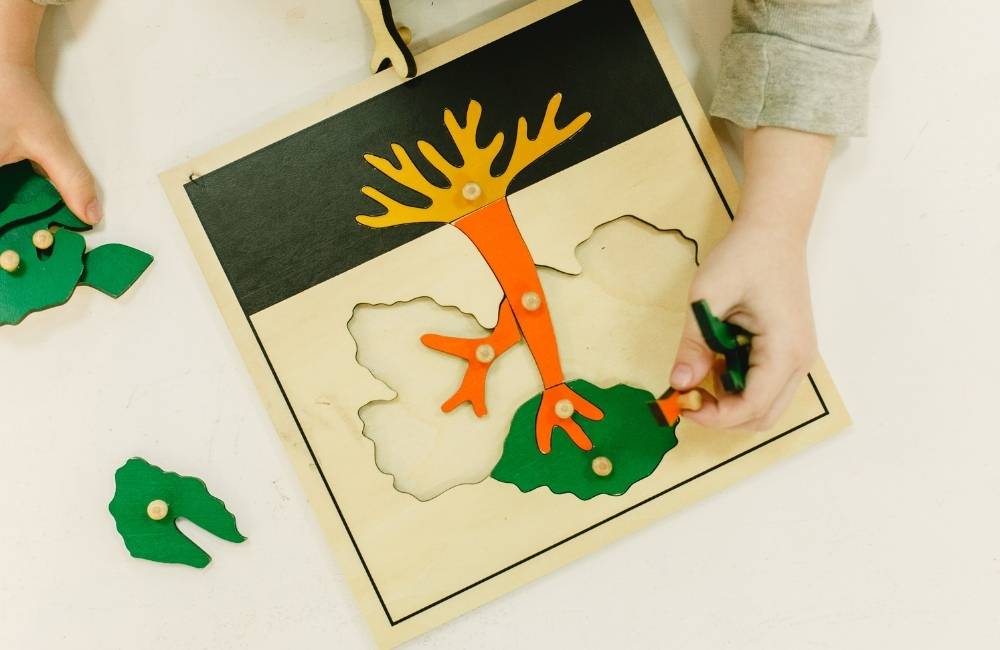
Critical thinking refers to registering the information, understanding and analyze it to make a reasonable judgment. As children tend to ask many questions, critical thinking will filter useful and relevant information. Also, it requires self-control and focuses on solving problems. This will prepare the child to deal with the real world.
Table of Contents
Importance of Problem-Solving Skills in Children
- Learn to handle bigger challenges as they grow up to develop these skills in early childhood .
- Learn to identify the problem, find different solutions and apply the solution and analyze the results.
- The building of resilience to cope up with challenges as they come.
- Boosts confidence.
- Develops grit that helps children academically.
Problem Solving Activities for Kids that Promote Critical Thinking
Thinking critically enhances knowledge, helps one make independent decisions, and improve creativity. To develop this core skill, you can inculcate some problem-solving activities in their daily routine that they will enjoy doing.
1. Memory game
The simplest game yet an effective game in developing your child’s problem-solving ability as well as focus. You can start by lining objects that are similar to your child, let your child see the objects, and make them close their eyes and count till 10. Hide one of the objects from the line and let your child guess which one of them is missing. They will try to look here and there for the object, and that is completely fine. Allow them to do so as this will build their confidence.
2. Include creativity
Critical thinking also includes giving life to your kid’s thoughts. Let them draw a picture explaining their thoughts. Make use of words like “imagine” and “suppose.” Ask them to come up with their own ideas and solutions. Tell them to be creative. You can make use of different colorful pictures, objects, and images. They will observe, ask questions, enhance their imagination and will be a part of the discussion.
Completing a puzzle is essential in achieving a set goal. For achieving this goal, children use their imagination and strategies. By assembling all the mixed and jumbled pieces independently, kids will have a chance to learn problem-solving skills. You can guide your children in completing the puzzles by helping them in creating strategies. Teach your kid to identify the edge pieces and the middle pieces. Also, teach your kid to categorize the pieces based on color and shape. It will enhance their critical thinking and facilitate their decision-making ability. Children will make strategies to complete a big task by dividing it into smaller ones.
4. Pretend play
Pretend games are fun, imaginative, and an important part of a child’s development. Pretend play is important in enhancing the child’s creativity. By being a part of an imaginary scenario, the children get an opportunity to use their imagination. It also puts many problems in front of the child to solve and many questions for the child to answer like choosing the game, assigning the roles, deciding and playing by the rules, and making strategies for any forthcoming problems. According to some researchers, pretend play helps in brain development that regulates behavior.
5. Block play
Block play offers a creative and valuable learning experience. It will increase their attention and concentration, and the kids will spend long hours on this activity. Block play enhances the ability of problem-solving as your child will think of a solution while constructing anything. They will think of a plan they need to have before starting. They will face many problems during this process, which will allow them to use their brain for solutions. Kids will find the best possible ways to construct new designs and modify their plans if something goes wrong.
6. Reading books
Reading books to kids will encourage them to think and understand. They try to understand what is being read to them, remember parts from the story, and create imaginary scenarios in their heads. When you read books to children, try to provide them with information about their world and fill their brains with information and background knowledge. This helps them to make sense of what is being read to them. Reading books enhance their imagination and creativity. It even ignites curiosity in kids and predicts what will happen at the end of the story.
7. Scavenger hunt
A scavenger hunt is a fun and easy way to interact with your child. When you set up a scavenger hunt, you prepare your child to identify different colors and shapes and make them count. It boosts memory and problem-solving abilities.
8. Playing charades
Charades is also one of the most creative and fun games. It is an acting and guessing game that involves playing in two teams: one team acts and the other guesses. As there is no verbal communication involved in this game, kids will have to use their creativity to act. You can give them movies, books, objects, words, animals, or anything to act. They will try to find creative ways by using their brain to enact the words. They will also learn to think out of the box.
9. I spy books
I spy is yet another fun and creative way. Using I spy books will improve your child’s memory. They will search for different objects and images. It will also help the kid to differentiate between different shapes and letters. You can even play I spy with objects available in your household that your kid is familiar with. You can hide an object and ask your kid to find it. Alternatively, check out this Valentine’s Day I spy printable.
10. Ask ‘How’ and ‘Why’ more
After adding the word ‘what’ in the question, you can add the word HOW and WHY. This will allow the kids to think out of the box. They will try to find creative answers to the question and also will come up with different ideas. For example, if your child likes mangoes, instead of asking, “what is your favorite fruit?” You can ask, “why do you like mangoes?” Or “why do you prefer mangoes over bananas?”
11. Ask them to solve a problem
How would they solve a problem? Giving them a situation and asking them to come up with solutions will encourage them to think. It will even boost up their confidence. They will try to analyze the problem, understand it, and come up with a solution. This will improve their problem-solving abilities.
12. Obstacle course
An obstacle course for kids can be an excellent activity for problem-solving. This also helps them enhance their strength and balance. They need focus and strategies to overcome the obstacles, which will involve critical thinking. This will teach them how to move over, under and through the obstacle. It will also help them to find the fastest way to get through the obstacle course.
Solving a maze can be an amazing problem-solving game for kids. Solving a maze requires patience and focus that can help your kid to plan and brainstorm different strategies. It helps them stay in the line while receiving the creative stimulation they need.
14. Shape sudoku
Instead of playing sudoku with numbers, you can make your kids play it with basic shapes. Sudoku requires focus and patience and will improve your child’s memory. It will enhance their critical thinking abilities as it requires an understanding to recognize specific patterns and make decisions according to them. If they fail to solve it, you can assist your kids and encourage them. It will also improve their decision-making ability as they can make changes whenever required.
15. Teach them different points of view
Last but not least, it is one of the most important problem-solving activities for kids. Sometimes children think that there is only one right answer to a question, but you need to teach them that there can be different answers to one question. Helping them understand others’ points of view will help them think critically and teach them to accept other kids’ opinions.
How to teach problem-solving skills to children?
Problem-solving skills are key for kids to manage their lives. Also, researchers have found that teaching problem-solving skills can improve mental health . As parents, you cannot always be there to solve your child’s problems, but you can teach them how to solve them.
- Let your kid identify the problem and state it out loud : Teach your child that it’s okay to face challenges and, at the same time, allow them to make mistakes. Tell them if one solution does not work, the other will!
- Let them come up with their solutions : Ask your kid to come up with various solutions to a single problem. This will encourage them to think of various creative solutions. Let them come up with all the right and wrong ideas.
- Involve them in your decisions : ask for advice from your kids in case of a problem. This will encourage them to face a challenge and boost their self-esteem.
- Don’t provide the correct answers: as parents, don’t provide your kid with the correct solution to the problem immediately. Failing is a part of learning. Teach them it’s okay to be wrong and they can learn from their experience. Help them with identifying the pros and cons of their solutions that they have come up with.
- Allow them to make decisions : by allowing them to make decisions, kids will feel confident, which will improve their decision-making skills. Once you have taught your children the rights and the wrongs, your child will be in the position of picking one solution.
- Let them analyze the results : allow your child to judge and analyze their results because of their own decisions. If the first solution doesn’t work out for the problem, teach them to use the other solutions. They will feel positive and this will allow them to learn from their mistakes.
Over to you…
As parents, you need to make sure you do not force your thinking pattern on them. Children are natural thinkers and curious. They have creative and out of the box ideas and solutions. You need to develop problem solving skills and critical thinking by listening to their thoughts and ideas. These interactive activities for kids can help nurture this skill in them a little better.
About The Author
Shakir Malik
Privacy overview.

Problem-Solving, Exploring, and More: Engaging Activities for Kids

A child’s ability to solve problems is valuable in helping them cope with challenges. As they grow up, kids are presented with a wealth of educational possibilities. They also regularly face challenges, such as conflicts, peer pressure, and challenging mathematical calculations. The benefits of problem-solving skills for children are vast and can help them properly deal with such situations.
This way they learn to identify practical solutions alone without relying on an adult. They will also have more faith in their capacity to apply their problem-solving talents and develop original solutions on their own when facing challenges.
Read this blog, to know the importance of problem-solving abilities for children, how to infuse this skill in them, and for some exercises like storytelling, coding for kids , puzzles, crafts, and many more to assist them to develop this crucial skill.
What do problem-solving, exploring, and thinking mean?
Problem-solving is the process of finding a solution to a problem. It may involve finding alternatives, generating ideas and solutions, evaluating them, and then choosing one. Problem-solving also includes being able to recognize when you should solve a problem. For example, taking a math test without understanding the material is a problem that needs to be solved. So is being hungry and having no money to buy food.
Exploring means looking at things from different perspectives, trying new things, and asking questions to understand. This can help us learn new things, solve problems, and make new connections. It is a skill that children can learn and use in their everyday lives.
Thinking involves using our imagination, understanding our emotions, and using language and symbols to express our ideas or solve problems.
So, let’s start at the beginning:
Contrary to popular belief, problem-solving skills are not limited to a specific set of techniques. The sum of these abilities determines how rapidly and accurately a person can work through the steps of problem-solving to arrive at a workable solution.
Some problem-solving abilities are listed below.
- Critical Thinking
- The Use of Logic
- Competence in Making Choices
- Knowledgeable in the Art of Conversation
- Strategic Plan for Creative Problem-Solving
There will be times when you will only need to rely on one or two of your abilities to solve the challenge at hand. Other times, especially when dealing with more complicated issues, may call for three or more. It’s hard to say without more information.
Why Is Problem Solving an Important Skill to Develop?
This may sound strange, but problem-solving skills are actually being taught way before you start solving actual problems. Infants and toddlers who are just learning to crawl or walk may tire themselves out attempting in vain to overcome obstacles such as walls. The parent is the one to first recognize the issue and then devise a strategy for dealing with it, such as eliminating the barrier or helping the child to climb it. Again, it is the parent who will recognize the child’s frustration at a challenge, such as opening a door, as the kid begins to walk. The child learns that there are ways out of difficult situations if they put in the effort to find them. Parents should not solve their children’s problems for them but rather help them work through the issues and arrive at their own conclusions.
How to Inculcate Problem-Solving Skills in Children ?
Problem-solving skills are best learned when a child is actively engaged in exploring. To promote problem-solving skills, parents can do a few things:
Method 1: Explore and Discover New Things
Exploring and discovering new things is a great way to encourage problem-solving in your child. Let your child explore one new thing a day. This can be something as simple as a new food or flavor, or finding a new toy that they’ve never played with before. Let your child explore and take note of how they feel about it. This can help them discover more about themselves and the world around them.

You can also encourage exploring through the following:
- Taking an Adventure : Going on an adventure with your child can help them explore and discover new things. You can do this inside or outside and make it as simple or as complex as your child is interested in.
- Exploring Your Environment : Get to know your neighbourhood. Explore your local parks, forests, and other areas. This will help your child get to know their environment and discover things they might not have otherwise noticed.
- Following a DIY Project : This can be as simple as building something with Lincoln logs or other building toys. Let your child explore their creative side and see what they discover about themselves through this project.
Method 2: Help Your Child Think Through Problems
If your child has a specific problem that needs to be solved, you can help them think through it by giving them some guidance. Once your child has shared their problem with you, use these steps to help them come to a solution:
- List all the facts: This means the things that are true or relevant to the problem. For example, if your child’s friend is mad at them, you might want to help them solve this problem. You can start by helping your child list all the facts.
- List all the assumptions: This means the things that your child is assuming are true but might not actually be. This is where your child might be jumping to conclusions that aren’t entirely accurate.
- List all the options: This means the different ways your child can deal with their problem. After listing all the facts and assumptions, your child should be able to come up with some options to solve their problem.
Method 3: Encouraging Exploration and Discovery in Children
As a parent, you also need to engage in this. You don’t want to be the parent who has everything planned out for their child, never allowing them to explore or discover new things for themselves. This not only helps your child, but it also helps you come to terms with the fact that you’re not a perfect parent.

You can encourage exploration in your child by doing the following:
- Let your child explore their environment: This can be as simple as exploring a park or forest or getting to know your neighbourhood. Not only does this help your child discover new things, but it also helps you come to terms with the fact that you’re not a perfect parent.
- Let your child explore their interests: Whether it’s exploring a new hobby, game, or sport, let your child dive into something they’re interested in so they can explore and discover new things.
- Be open to new experiences: When you and your child are out and about, be open to new experiences. Let your child explore and discover as much as possible while out and about with you.
Children learn best when they are actively involved in the process. With the right activities, we can help our children to develop these skills and have happier; more successful lives.
Here is a list of activities, which will test their problem-solving skills
Computer coding/programming.
Coding is a great way to help kids develop their problem-solving skills. Children can start to understand the basics of coding from a young age and gradually build their knowledge as they age. With the right curriculum and resources, kids can become creative problem solvers and develop the skills they need to succeed. And luckily, there are plenty of ways to get kids coding .

SkoolOfCode is a great place to start, as it offers a range of online coding classes for kids , from beginner to advance. With their fun and interactive coding for kids courses, kids can learn the fundamentals of coding, while also gaining an understanding of how to think logically and develop problem solving skills. Parents can also help their kids by finding coding activities and resources that the entire family can work on together.
To help your child develop skills relevant to today’s world, consider signing him or her up for one of the many holiday workshops that focus on creating a game or project in just two hours. A coding workshop is an intensive, hands-on introduction to a specific programming language or code library. So don’t hesitate to jump on the coding bandwagon – your kids will thank you for it.
Interactive storytelling
Interactive storytelling is a creative and engaging way to develop problem-solving skills. It can apply to any interest or passion your child has: a hobby, sport, favorite TV show or book series, or even something totally new and different.

With interactive storytelling, your child can experiment, explore and create their own solutions to problems. They can apply problem-solving skills as it helps in imagining new scenarios, characters and outcomes. A child’s attachment to a fictional figure is typically at its highest during this time. So, when they’re stumped, have them imagine how their fictional hero would handle the situation. Have them consider several different options and the results they could bring about.
This can be done through a variety of different tools, from creating a story with friends using a collaborative online tool (such as Scratch, ROOM or SMAUG) to writing stories using software such as Twine or using computer programming to create an interactive story.
Puzzles can provide an engaging way for kids to practice problem-solving skills. Your child can try out different types of puzzles, including word or number puzzles, crossword puzzles, or jigsaw puzzles. Puzzles are a fun way to challenge your child’s problem-solving skills. They can also provide a great opportunity for you to engage your child in conversation and listen actively while he shares his ideas and solutions to puzzles.

Furthermore, the exercise will aid in the development of their analytical and logical reasoning abilities, as well as their motor abilities and hand-eye coordination.
Building Blocks
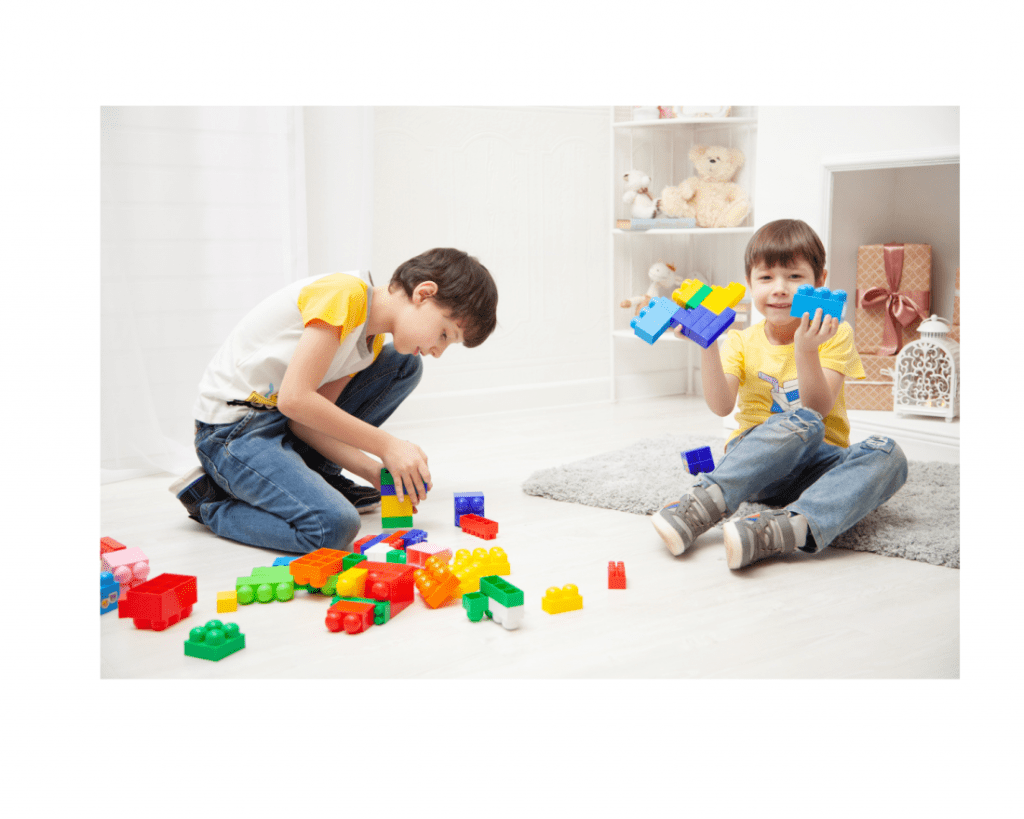
Building with LEGO or other building blocks engages your child’s creativity and imagination while also providing opportunities for problem-solving. Your child can create anything they can imagine with these materials, which allows them to experiment, explore and create their own solutions to problems. They can apply their problem-solving skills as they imagine new scenarios, characters and outcomes.
The Human Knot
The human knot is a great activity for kids who enjoy being creative and working together as a team. It can help improve problem-solving skills by working through a series of challenges with your child’s friends.
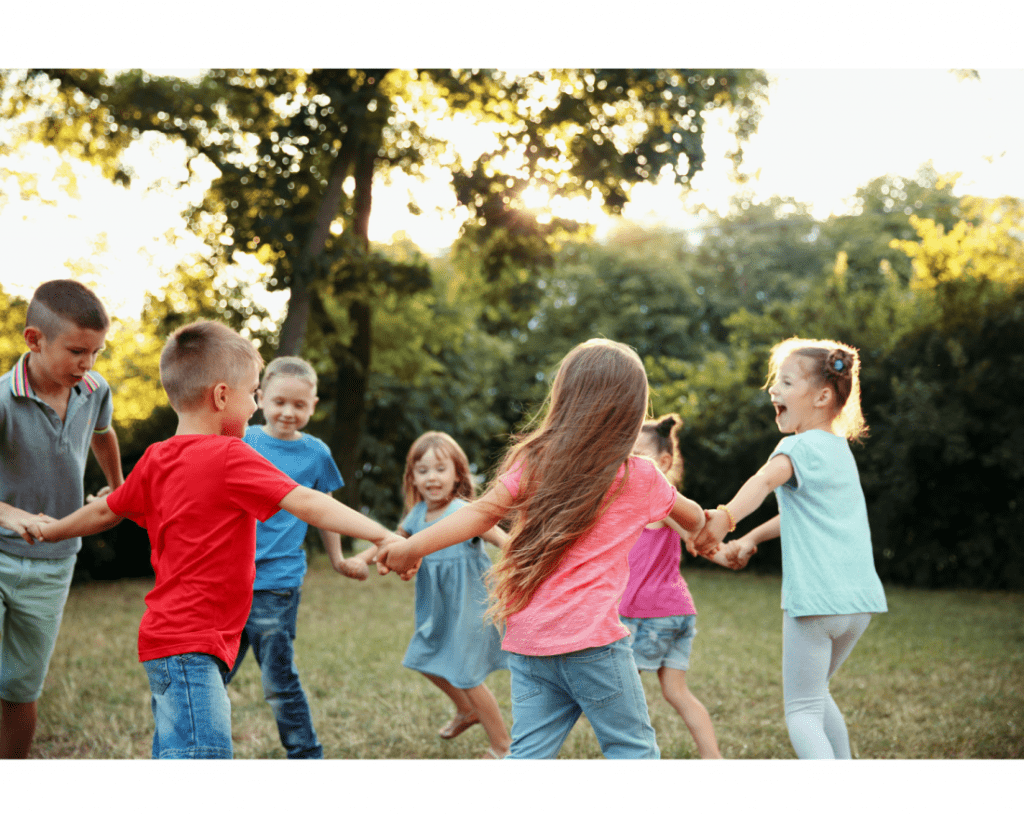
To start the activity, kids should gather in a large circle. They should then clasp hands with their neighbors to create a knot. This can be a bit tricky, so it might be best for older kids to do this activity. Once the knot is formed, the team has to work together to unknot the circle and find a solution to getting untangled. While this is a fun way to engage in problem-solving skills, it can also be a good exercise in communication.
Board games and Craft
Board games and crafts are a great way for kids to have fun and learn at the same time. For parents, it’s a great way to get their children thinking critically and creatively while improving their problem-solving skills.

Board games in particular can help develop a child’s social skills, as they’ll be spending time with family or friends playing the game. And because the games are interactive, they need to think quickly and come up with strategies to win.
Crafts can also help children develop creative thinking and problem-solving skills. By allowing them to express themselves through art and design, they’re encouraged to be creative and come up with unique solutions to their problems. Plus, it’s a great way to boost their confidence, as they’ll be proud of the things they create.

So, if you’re looking for a way to improve your child’s ability to think creatively and critically and improve their problem-solving skills, board games and crafts are an excellent option.
Interactive Websites/Online Games
Playing online interactive games is an exciting way for kids to develop problem-solving skills. These games help children think outside the box, encouraging them to come up with creative solutions for the tricky puzzles they encounter. By playing these interactive games, kids are also improving their logical reasoning skills, gaining a better understanding of the world around them, and learning how to approach problems more effectively.
Parents can also use these games to teach their children about the importance of perseverance, how to set and achieve goals, and how to work through challenges. With a variety of puzzles and games to choose from, kids can have a blast while exercising their problem-solving muscles. These skills can be applied in real-life situations where your child needs to solve problems: like unearthing a math problem, finding the best route to walk to school, or working through a disagreement with a friend.
Open- Ended Questions

Asking open-ended questions is an excellent way to help your kids think creatively and critically and improve their problem-solving skills. This type of questioning encourages kids to think outside the box and come up with solutions to complex problems. Parents can use open-ended questions to help their children explore topics, understand different perspectives, and think about the consequences of their actions. And the best part is, these questions don’t require any additional materials or tools – just you and your kids. By asking questions like “What would happen if…?”, “What do you think would work in this situation?”, or “How would you solve this problem?”, you can help your kids develop their problem-solving skills and explore their creative thinking. You’ll be amazed by the answers they come up with.
A better understanding of the problem-solving process and how it works can help you become a better problem-solver. Often, when we find ourselves stuck in a problem, we’re too focused on the issue at hand to think clearly and find creative solutions.
There’s no denying the benefits of engaging in activities for kids. Whether your kid is exploring the world around them or challenging their mind, these activities are beneficial for kids of all ages. However, it’s important to keep in mind that kids of different ages require different types of activities. For example, an activity that’s beneficial for an older child might not be beneficial for a younger child. That’s why it’s important to familiarize yourself with the different types of activities for kids and how they can help your child.
By – Ms. Manpreet Virk , Head of E-learning and an educator at SkoolofCode with degree in M.Phil. and Master in Computer Science. She is passionate about learning and teaching young minds.
Start Your Child’s Coding Journey
Create your free account to start your child on the path to success
LATEST POSTS
Code, create, conquer: summer coding camp for kids, the role of ai in visualizing dreams: bridging the gap between mind and matter, dream. code. achieve: discover skoolofcode’s coding classes for kids, unleashing creativity with variables and lists in scratch programming: a guide for young innovators, building your own translator app with mit app inventor.
- Grades 6-12
- School Leaders
Free end-of-year letter templates to your students 📝!
50 STEM Activities for Kids of All Ages and Interests
Inspire the innovators of tomorrow.
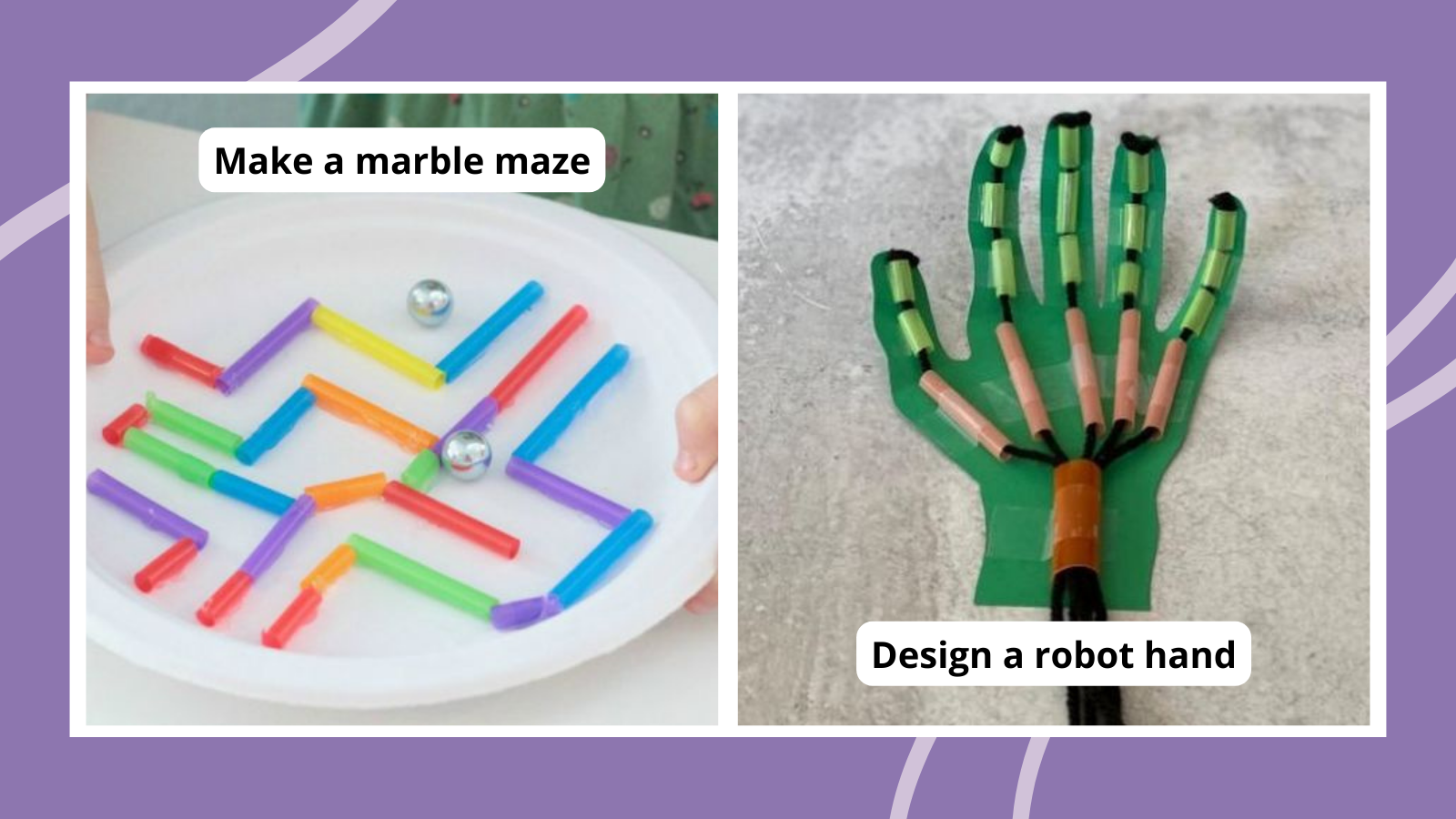
These days, STEM learning is more important than ever. Science, technology, engineering, and math are the keys to many modern careers, so a good grounding in them from an early age is a must. The best STEM activities for kids are hands-on, leading students to cool innovations and real-world applications . Here are some of our favorites, with challenges and experiments that will really get kids thinking about how STEM plays a part in their everyday lives.
Want some quick challenges to try with elementary students? Get free printable stem challenge cards for grades K-5:
- Kindergarten STEM Challenges
- First Grade STEM Challenges
- Second Grade STEM Challenges
- Third Grade STEM Challenges
- Fourth Grade STEM Challenges
- Fifth Grade STEM Challenges
For more STEM activities for kids across a range of subjects, take a look at these ideas.
1. Add STEM bins to your classroom
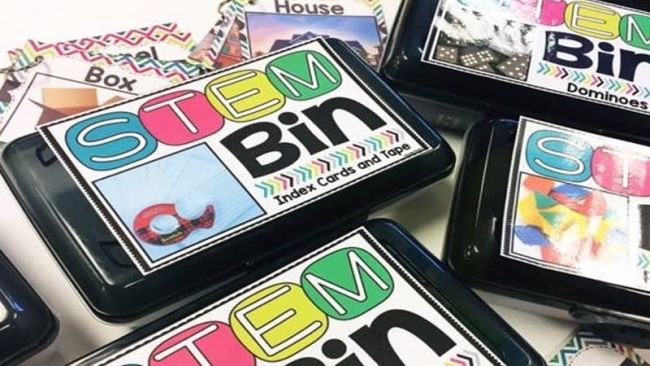
STEM Focus: Science, Technology, Engineering, Math
Prepare for a wide variety of STEM activities for kids with these cool bins. Incorporate them into literacy centers, create a makerspace, and offer early finishers fun enrichment ideas. Learn how to create and use STEM bins.
2. Conduct an egg drop
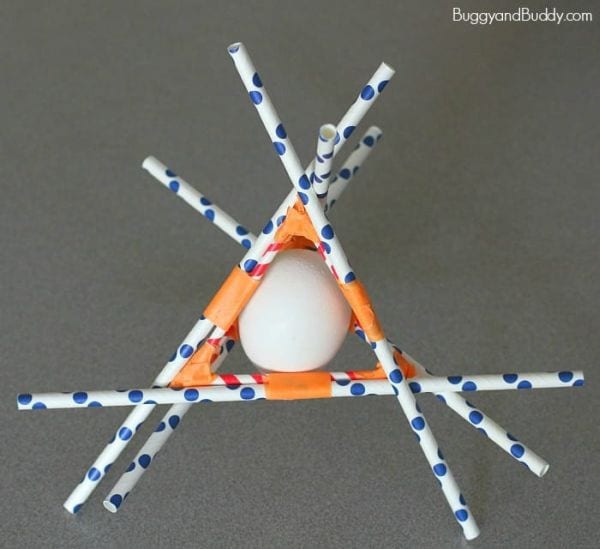
STEM Focus: Engineering
This is one of those classic STEM activities every kid should try at least once. Kids can do it at any age, with different materials and heights to mix it up.
Learn more: Egg Drop at Buggy and Buddy
3. Engineer a drinking straw roller coaster
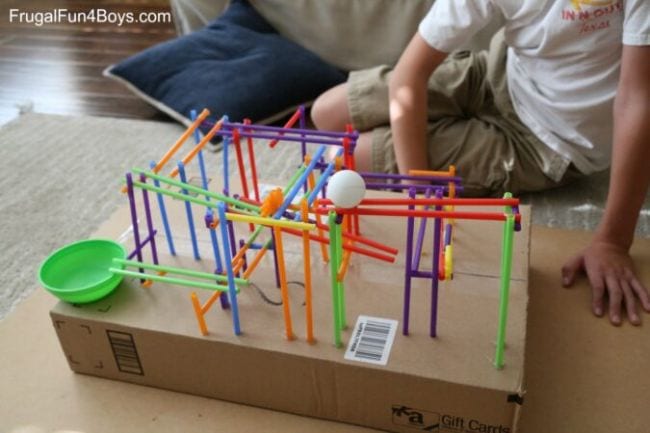
This is such a fun way to encourage engineering skills! All you need are basic supplies like drinking straws, tape, and scissors.
Learn more: Straw Roller Coaster at Frugal Fun for Boys and Girls
4. Find ways to slow soil erosion
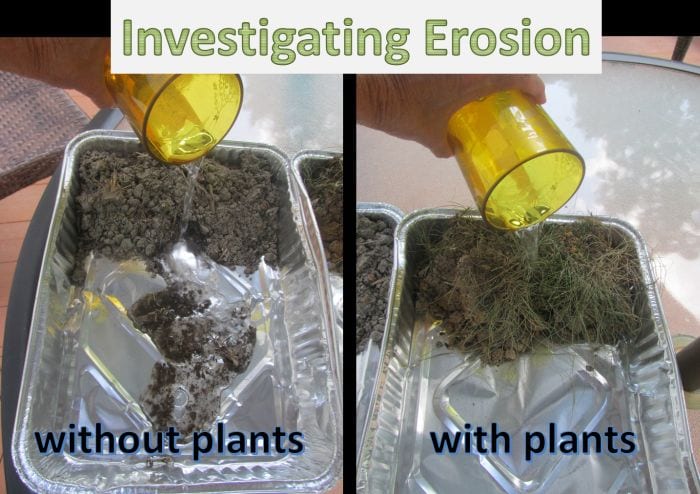
STEM Focus: Science (Ecology), Engineering
Compare the effects of “rain” on hills of bare soil vs. those covered with grass. Have your 3rd grade science students predict which they think will stand up to erosion better and then test their hypotheses.
Learn more: Erosion Experiment at Third Grade Thinkers
5. Simulate an earthquake
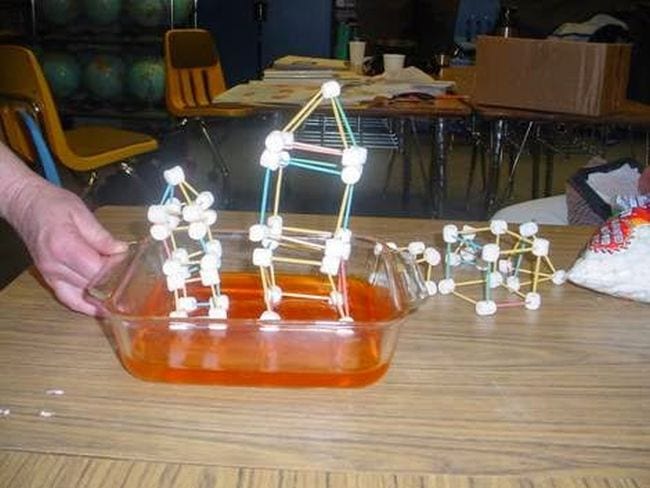
The ground under our feet may feel solid, but an earthquake changes that pretty quickly. Use Jell-O to simulate the earth’s crust, then see if you can build an earthquake-proof structure.
Learn more: Earthquake Science at Teaching Science
6. Stand up to a hurricane

In a hurricane zone, houses must be able to stand up to strong winds and possible flooding. Can your students design houses that make it safer to live in these dangerous areas?
Learn more: Hurricane Houses at Carly and Adam
7. Create a new plant or animal
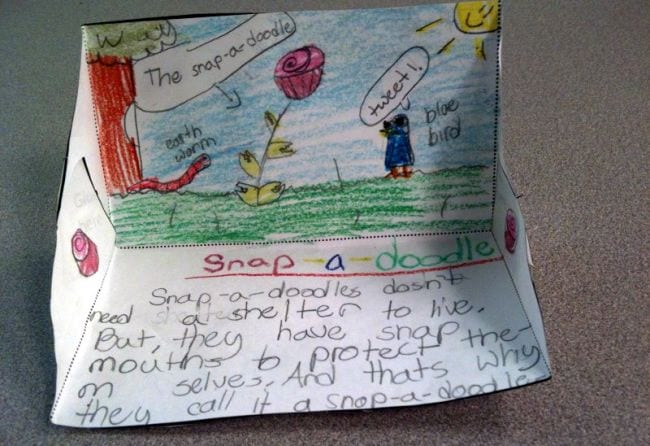
STEM Focus: Science (Biology)
Kids will really get into this project, indulging their creativity as they invent a plant or animal that’s never been seen before. They’ll need to be able to explain the biology behind it all, though, making this an in-depth project you can tailor to any class.
Learn more: Create a Creature at I Love 2 Teach
8. Design a helping hand
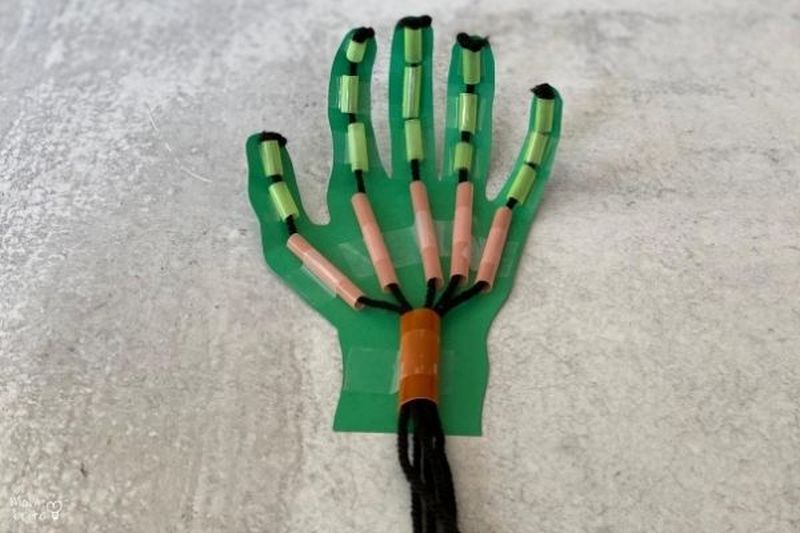
STEM Focus: Technology, Engineering
This is a great group science project. Students hone their design and engineering skills to make a working model of a hand. For a more advanced activity, challenge students to build a robotic hand that can be controlled remotely.
Learn more : Model Hand at Mombrite
9. Understand the impact of non-renewable resources
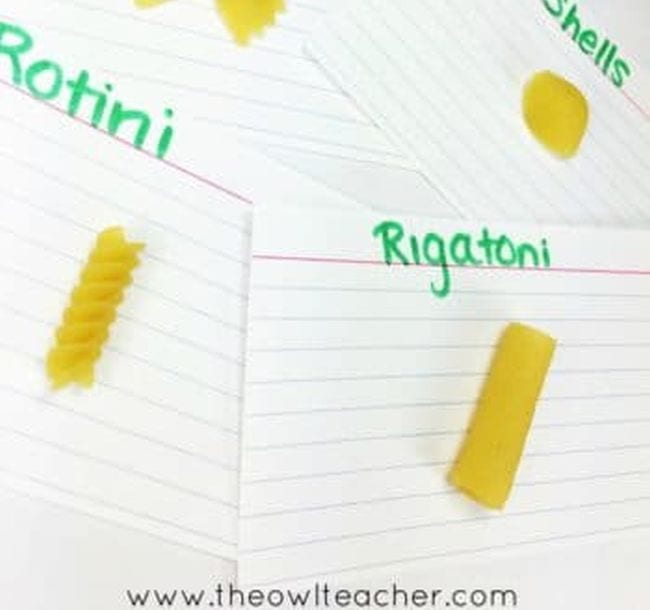
STEM Focus: Science (Environmental Science)
Discuss the differences between renewable and non-renewable resources, then have your class form “companies” to “mine” non-renewable resources. As they compete, they’ll see how quickly the resources are used. It’s a great tie-in to energy conservation discussions.
Learn more: Energy Resources at The Owl Teacher
10. Devise an amazing marble maze
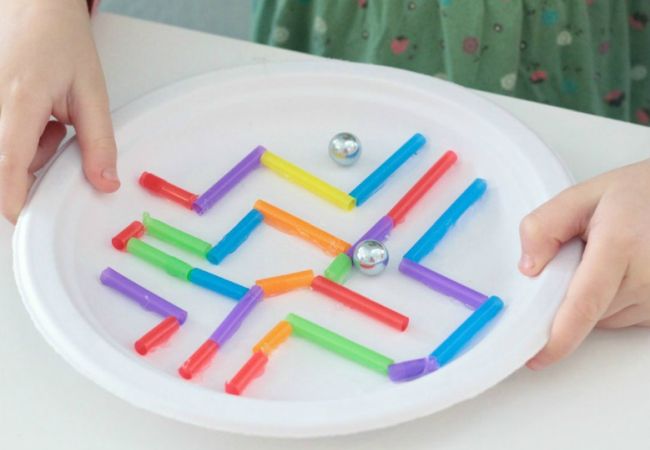
Marble mazes are one of students’ favorite STEM activities! You can provide supplies like straws and paper plates for their project. Or let them use their imaginations and create marble mazes from any materials they can think of.
Learn more: Marble Maze on Raising Lifelong Learners
11. Fly clothespin airplanes
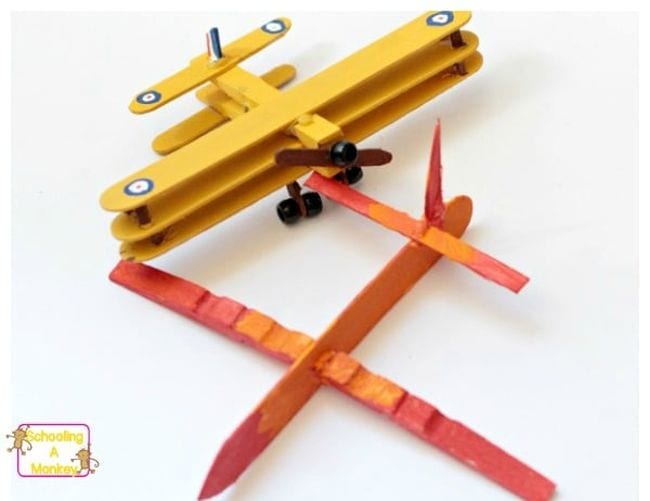
STEM: Engineering
Ask students what they think the airplane of the future might look like. Then, provide them with clothespins and wood craft sticks, and challenge them to build a new kind of airplane. Bonus points if it can actually fly!
Learn more: Clothespin Airplane at STEAMsational
12. Launch a catapult cannon
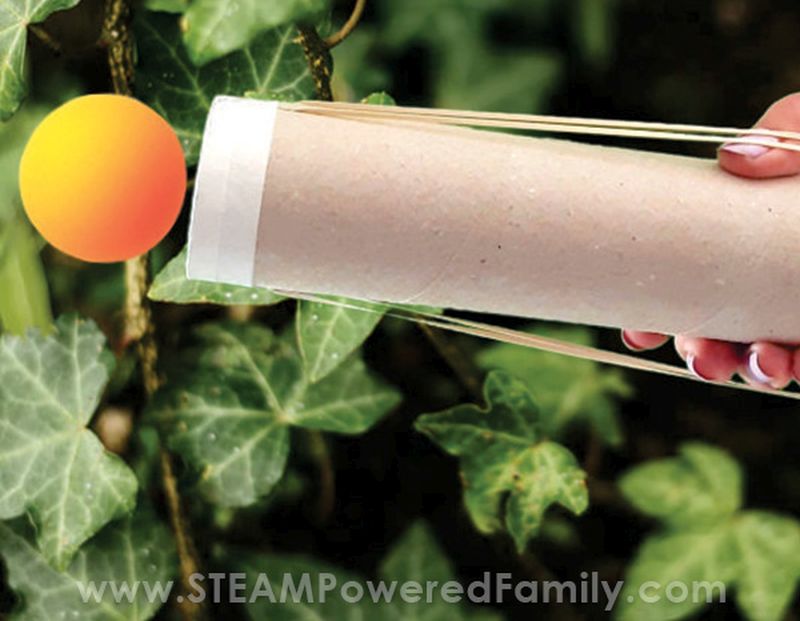
Catapult STEM challenges are always fun, but this one adds a new twist that allows kids to launch objects much farther than the usual wood craft stick version!
Learn more: Catapult Cannon and STEAM Powered Family
13. Bounce on a trampoline
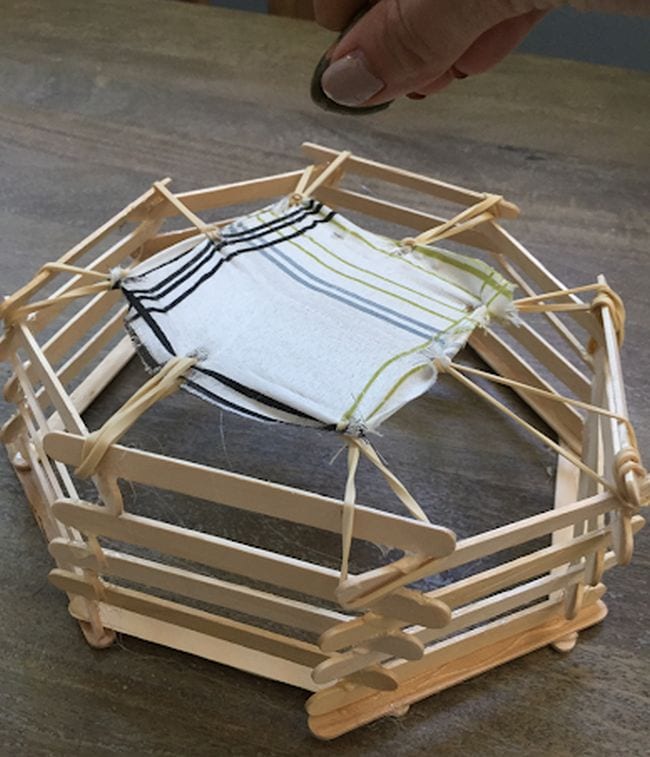
Kids love bouncing on trampolines, but can they build one themselves? Find out with this totally fun STEM challenge.
Learn more: Trampoline Challenge at Student Savvy
14. Build a solar oven
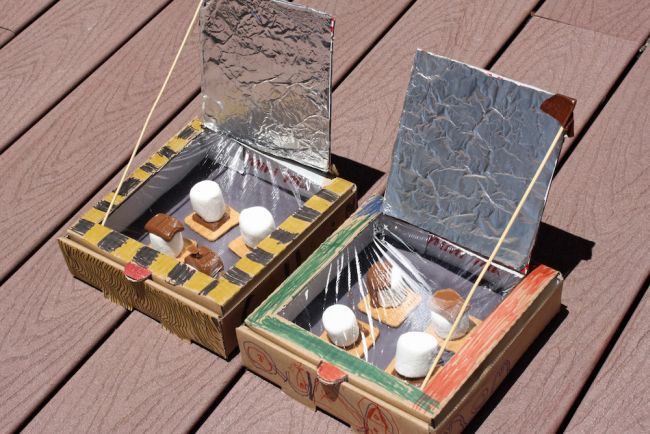
STEM Focus: Science, Engineering
Learn about the value of solar energy by building an oven that cooks food without electricity. Enjoy your tasty treats while discussing ways we can harness the energy of the sun and why alternative energy sources are important.
Learn more: Solar Oven at Desert Chica
15. Build a snack machine
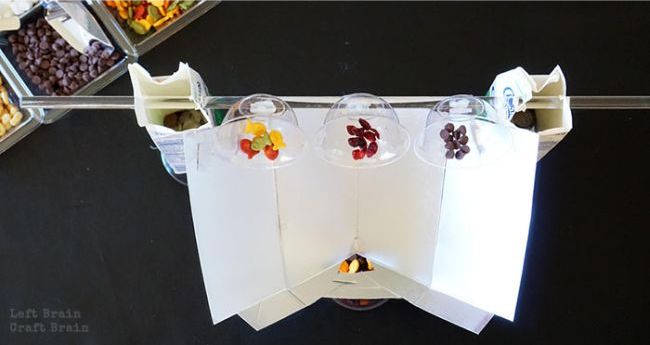
Incorporate everything students learn about simple machines into one project when you challenge them to build a snack machine. Using basic supplies, they’ll need to design and construct a machine that delivers snacks from one location to another.
Learn more: Snack Machine at Left Brain Craft Brain
16. Recycle newspaper into an engineering challenge

It’s amazing how a stack of newspapers can spark such creative engineering. Challenge students to build the tallest tower, support a book, or even build a chair using only newspaper and tape.
Learn more: Newspaper STEM Challenges at STEM Activities for Kids
17. Design a biosphere
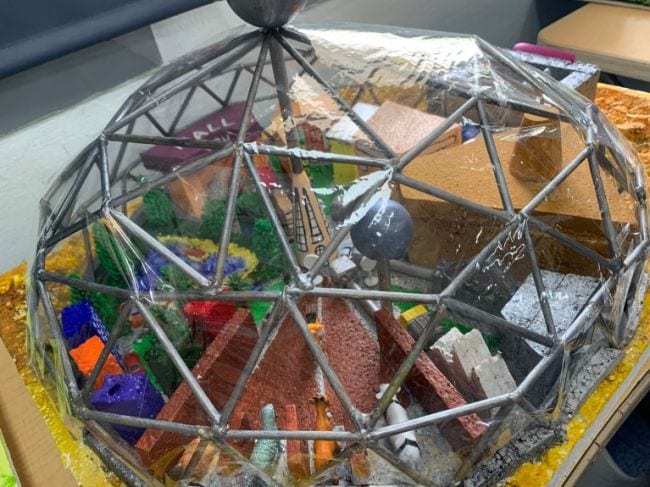
This project really brings out kids’ creativity and helps them understand that everything in a biosphere is really part of one big whole. You’ll be overwhelmed by what they come up with!
Learn more: Biosphere Project at Laney Lee
18. See the effects of an oil spill
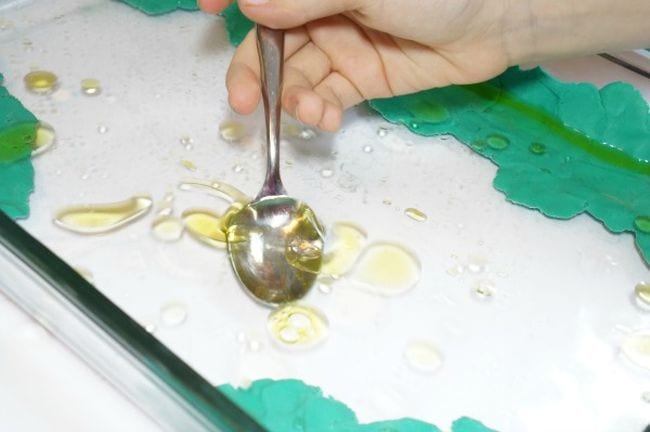
Learn why an oil spill is so devastating for wildlife and the ecosystem with this hands-on activity. Kids experiment to find the best way to clean up oil floating on water and rescue the animals affected by the spill.
Learn more: Oil Spill Cleanup at Kitchen Counter Chronicle
19. Assemble a steady-hand game

STEM Focus: Engineering, Technology
This is such a fun way to learn about circuits. It also brings in a bit of creativity, adding the “A” for STEAM.
Learn more: Steady Hand Game at Left Brain Craft Brain
20. Use cabbage to test pH

STEM Focus: Science (Chemistry)
Teach kids about acids and bases without needing pH test strips! Simply boil some red cabbage and use the resulting water to test various substances—acids turn red and bases turn green.
Learn more: Cabbage pH at Education Possible
21. Engineer a craft stick bridge
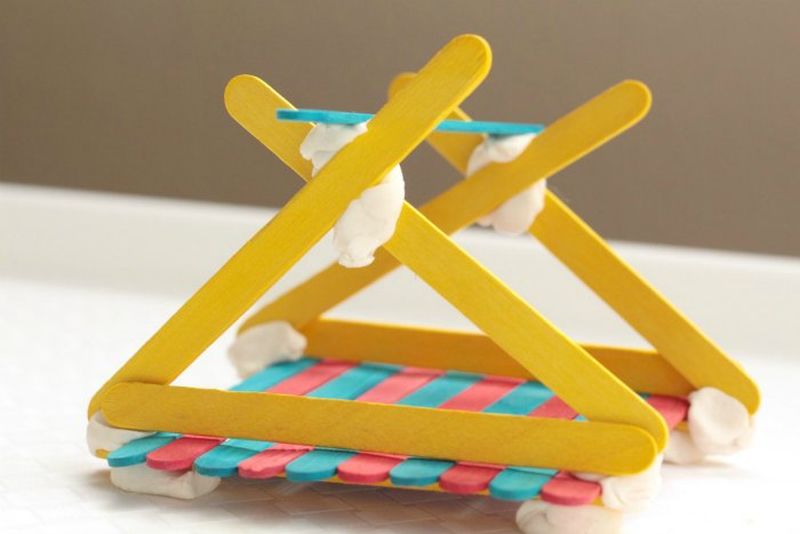
Here’s another one of those classic STEM activities that really challenge kids to use their skills. Build a bridge with Popsicle sticks and other materials, then compete to see which can bear the most weight.
Learn more: Bridge Challenge at Mommy Evolution
22. Forage and build a bird nest

STEM Focus: Science (Biology), Engineering
Birds build incredibly intricate nests from materials they find in the wild. Take a nature walk to gather materials, then see if you can build a sturdy, comfy nest of your own!
Learn more: Build a Bird Nest at Kids Craft Room
23. Drop parachutes to test air resistance
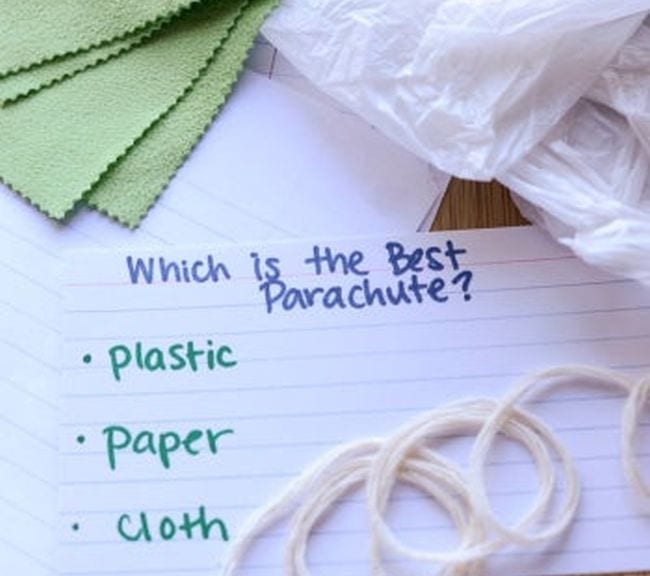
Use the scientific method to test different types of material and see which makes the most effective parachute. Your students also learn more about the physics behind air resistance.
Learn more: Parachute Challenge at Education.com
24. Find the most waterproof roof
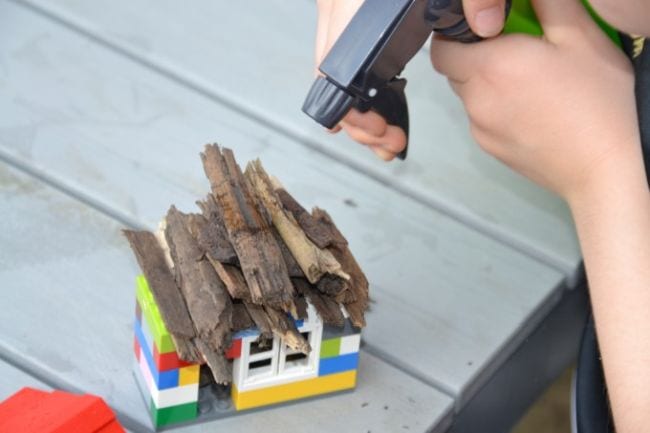
Calling all future engineers! Build a house from LEGO, then experiment to see what type of roof prevents water from leaking inside.
Learn more: Waterproof Roof at Science Sparks
25. Build a better umbrella
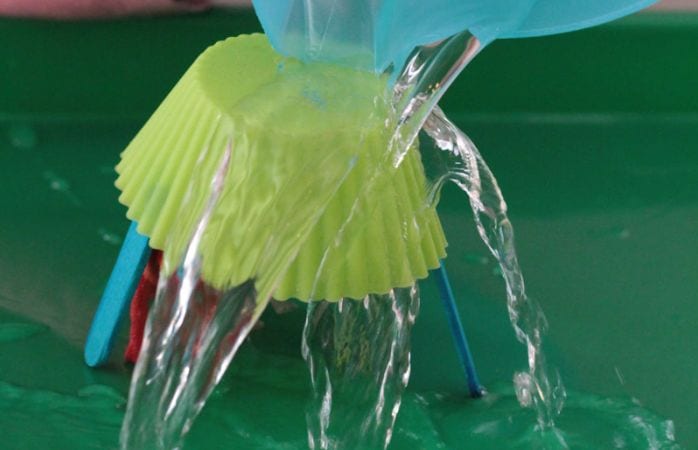
Challenge students to engineer the best possible umbrella from various household supplies. Encourage them to plan, draw blueprints, and test their creations using the scientific method.
Learn more: Better Umbrella at Raising Lifelong Learners
26. Go green with recycled paper
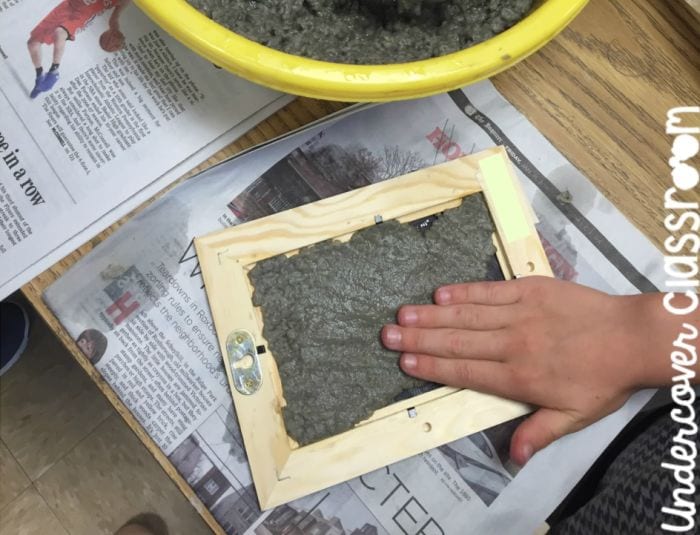
STEM Focus: Science (Ecology)
We talk a lot about recycling and sustainability these days, so show kids how it’s done! Recycle old worksheets or other papers using screen and picture frames. Then, ask kids to brainstorm ways to use the recycled paper.
Learn more: Recycled Paper at Undercover Classroom
27. Brew up your own slime
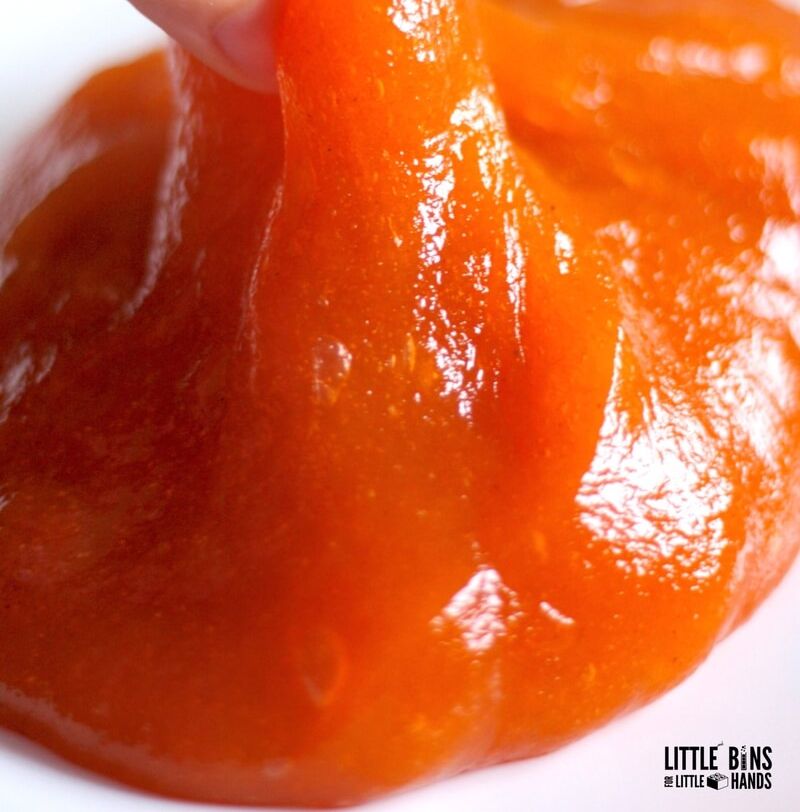
Chances are good your students already love making and playing with slime. Turn the fun into an experiment by changing the ingredients to create slime with a variety of properties—from magnetic to glow-in-the-dark!
Learn more: Slime Experiments at Little Bins for Little Hands
28. Create a taxonomy system
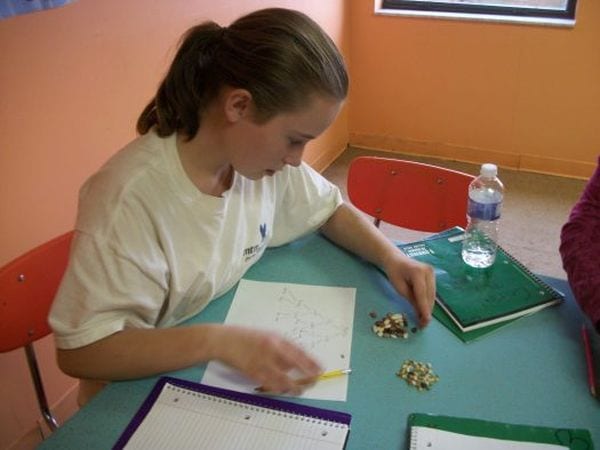
Students can step into Linnaeus’ shoes by creating their own system of taxonomy using a handful of different dried beans. This is a fun science project to do in groups, so students can see the differences between each group’s system.
Learn more: Classification Systems at Our Journey Westward
29. Find out which liquid is best for growing seeds
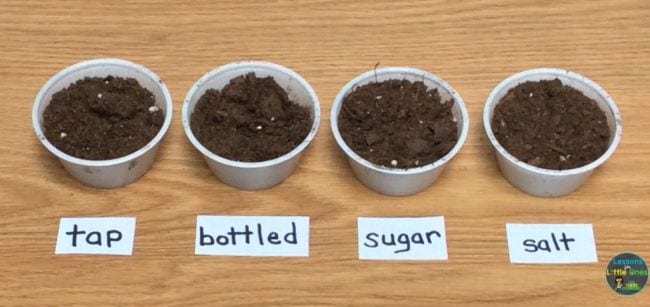
As you learn about the life cycle of plants , explore how water supports plants’ growth. Plant seeds and water them with a variety of liquids to see which sprout first and grow best.
Learn more: Plants and Liquids at Lessons for Little Ones
30. Create giant bubbles
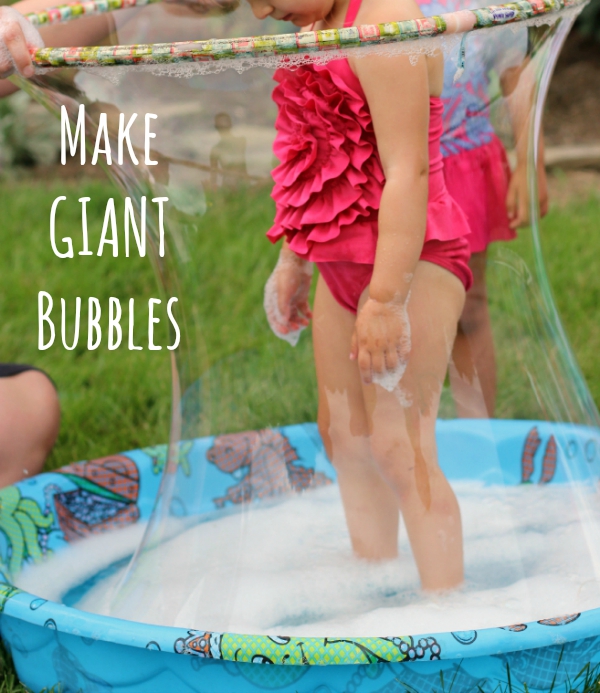
It’s easy to mix your own soap bubble solution with just a few ingredients. Let kids experiment to find the best proportion of ingredients to create giant bubbles, long-lasting bubbles, and other variations.
Learn more: Giant Soap Bubbles at Make and Takes
31. Make compost in a cup

This is an easy science activity, and you can turn it into a science fair project by experimenting with different mixtures, layering, and conditions for your compost cups.
Learn more: Compost Cups at The Happy Housewife
32. Help monarch butterflies
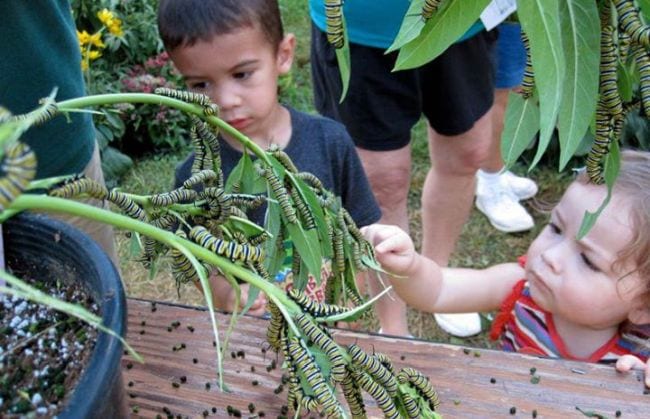
You may have heard that monarch butterflies are struggling to keep their population alive. Join the fight to save these beautiful bugs by planting your own butterfly garden, monitoring monarch populations, and more. Get all the info you need at the link.
Learn more: Monarch Education at Monarch Watch
33. See water pollution in action
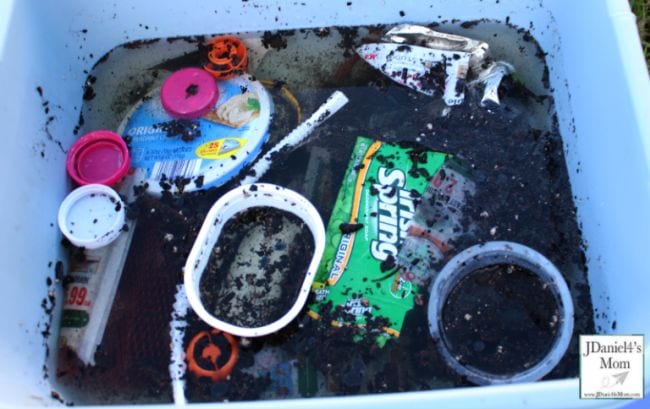
STEM Focus: Science (Environmental Science, Chemistry, Biology)
Learn about the challenges of cleaning up polluted water sources like rivers and lakes with this interesting outdoor science activity. Pair it with a visit to a local water treatment plant to expand the lesson.
Learn more: Water Pollution at JDaniel4’s Mom
34. Test your local water quality
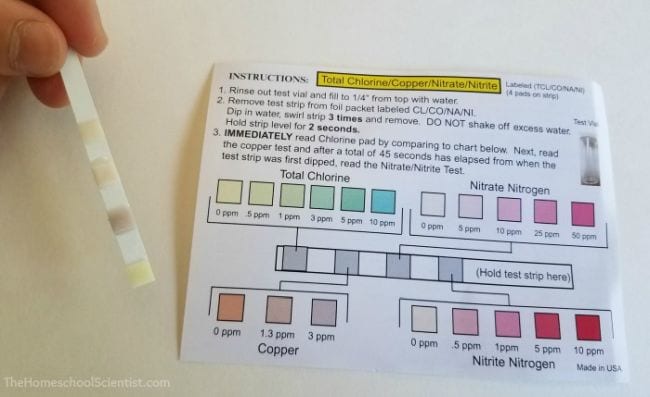
STEM Focus: Science (Chemistry, Environmental Science)
Once you’ve “cleaned up” your water, try testing it to see how clean it really is! Then head out to test other types of water. Kids will be fascinated to discover what’s in the water in their local streams, ponds, and puddles. Student water-testing kits are readily available online.
Learn more: Water Quality Experiment at The Homeschool Scientist
35. Explore with an edible Mars Rover
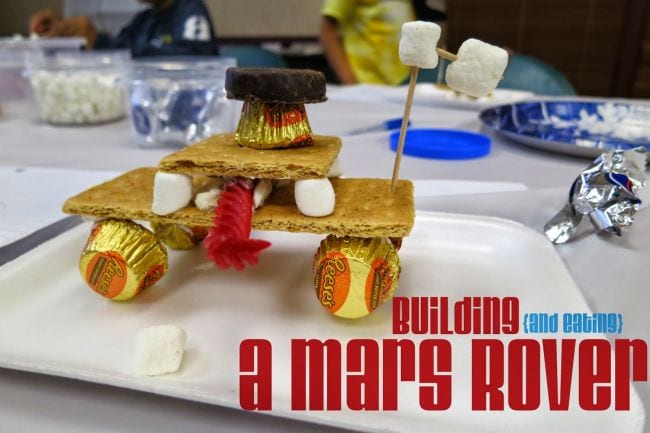
STEM Focus: Science (Space), Engineering
Learn about the conditions on Mars and the tasks the Mars Rover will need to complete. Then, give kids supplies to build their own. (Add to the challenge by making them “buy” the supplies and stick to a budget, just like NASA!)
Learn more: Edible Mars Rover at Library Makers
36. Bake the best potato
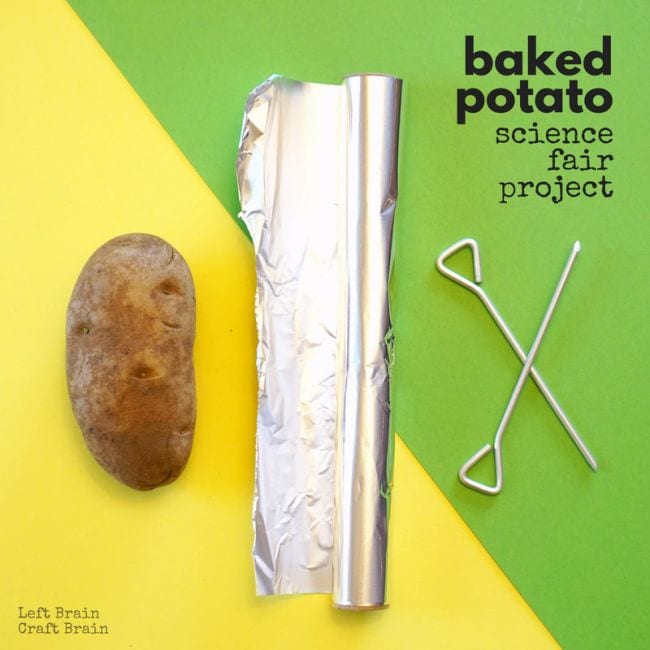
STEM Focus: Science (Physics)
This edible science project is a nutritious way to explore the scientific method in action. Experiment with a variety of methods for baking potatoes—microwaving, using a traditional oven, wrapping them in foil, using baking pins, etc.—testing hypotheses to discover which works best.
Learn more: Potato Science at Left Brain Craft Brain
37. Waterproof a boot
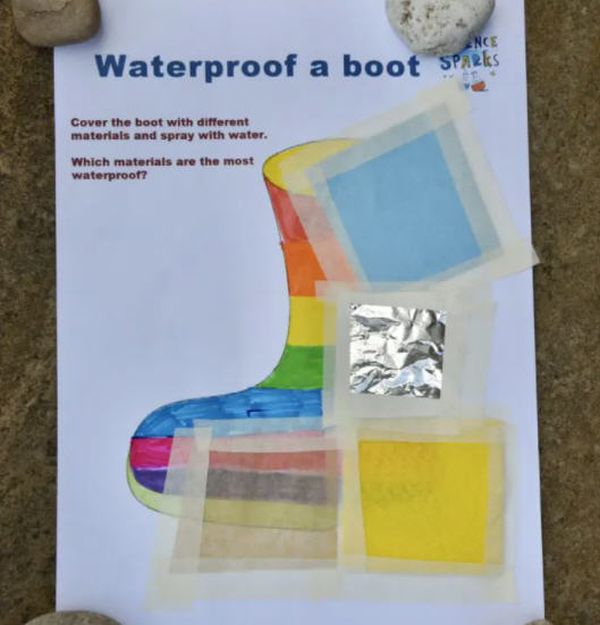
Ask kids to select various materials and tape them over the free boot printable. Then, test their hypotheses to see which ones work best.
Learn more: Waterproof a Boot at Science Sparks
38. Determine the best way to melt ice
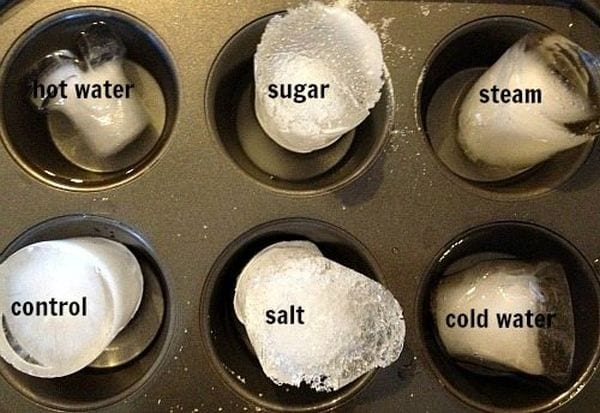
Conventional wisdom says we sprinkle salt on ice to melt it faster. But why? Is that really the best method? Try this science experiment and find out.
Learn more: Melting Ice at The Chaos and the Clutter
39. Don’t melt the ice
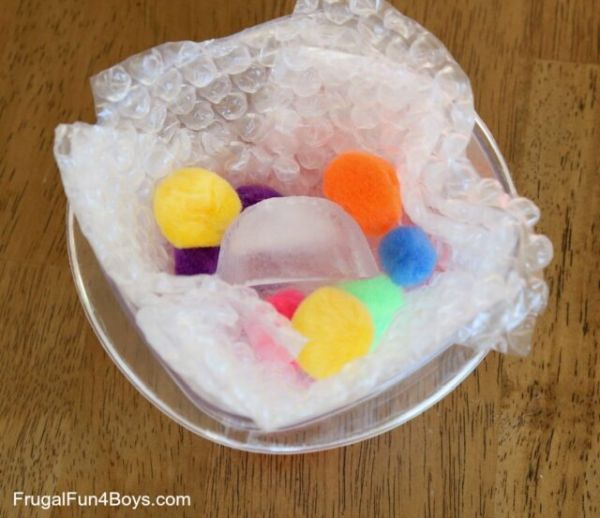
We spend a lot of time in winter trying to get rid of ice, but what about when you don’t want the ice to melt? Experiment with different forms of insulation to see which keeps ice frozen the longest.
Learn more: Ice Insulation at Frugal Fun for Boys and Girls
40. Build a straw house
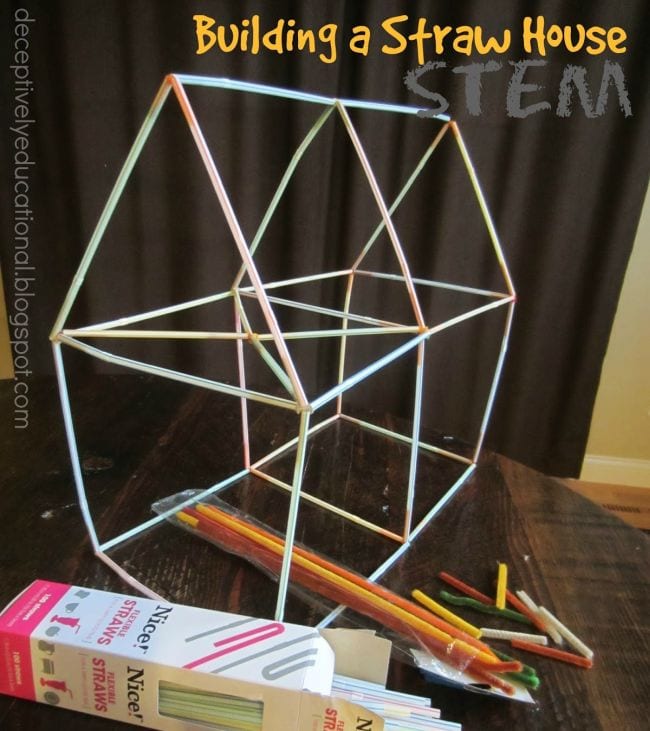
Grab a box of straws and a package of pipe cleaners. Then task kids with designing and building their dream house, using only those two items.
Learn more: Building a Straw House at Deceptively Educational
41. Design a balloon-powered car
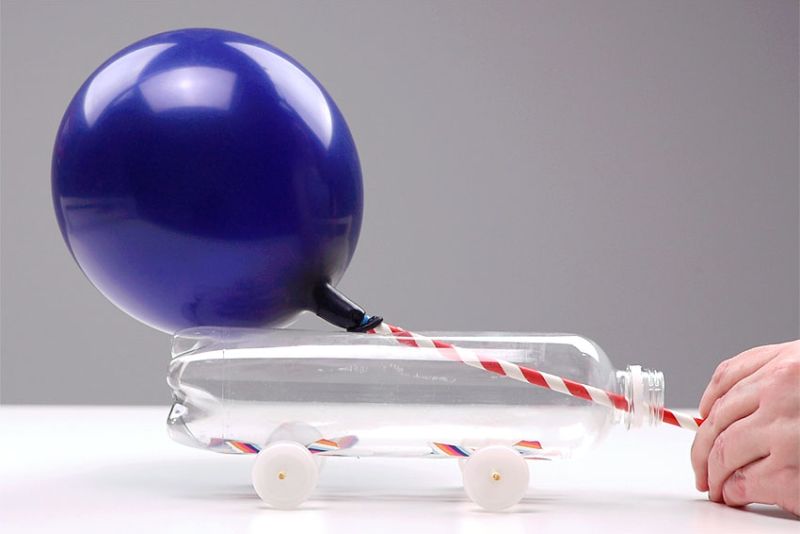
Explore the laws of motion and encourage creativity when you challenge students to design, build, and test their own balloon-powered cars. Bonus: Use only recycled materials to make this project green!
Learn more: Balloon-Powered Car at One Little Project
42. Learn map skills by designing an amusement park
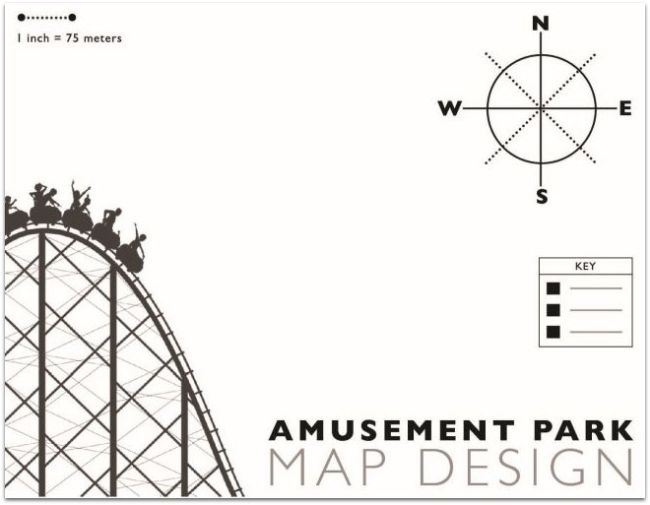
STEM Focus: Science (Physics), Technology, Engineering, Math
For this cross-curricular activity, students investigate the parts of a map by creating an amusement park. After they create their map, they do a detailed drawing and write about one of their ride designs. Then they design an all-access park pass. So many STEM activities in one! Find out more about it here.
43. Reach for the ceiling
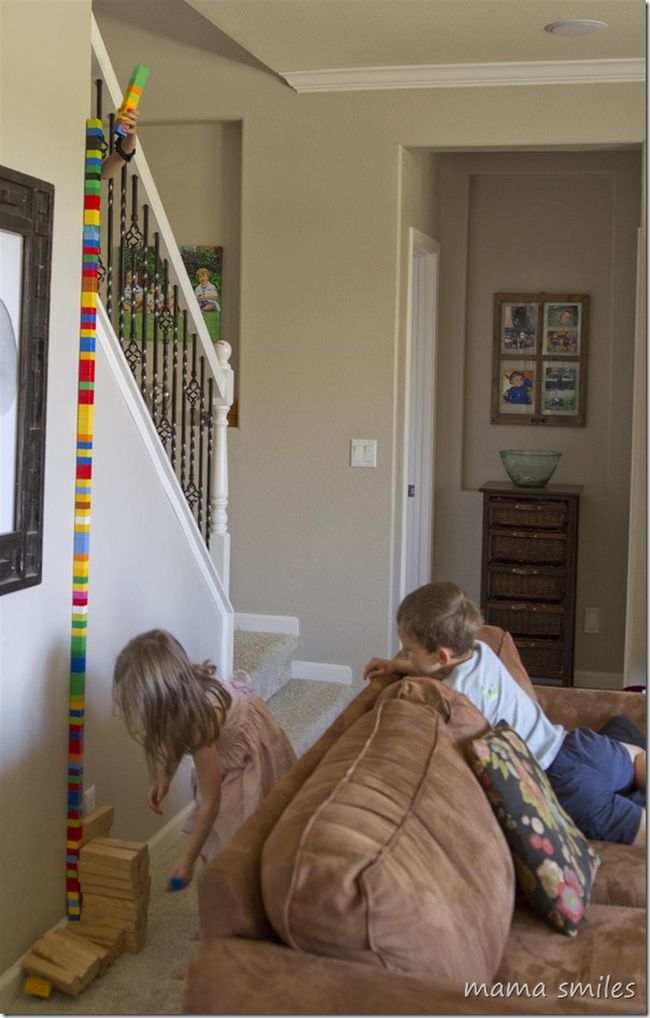
Round up all your building blocks and try this whole-class project. What will students need to do to be able to construct a tower that reaches all the way to the ceiling?
Learn more: Block Tower at Mama Smiles
44. Cast a tall shadow
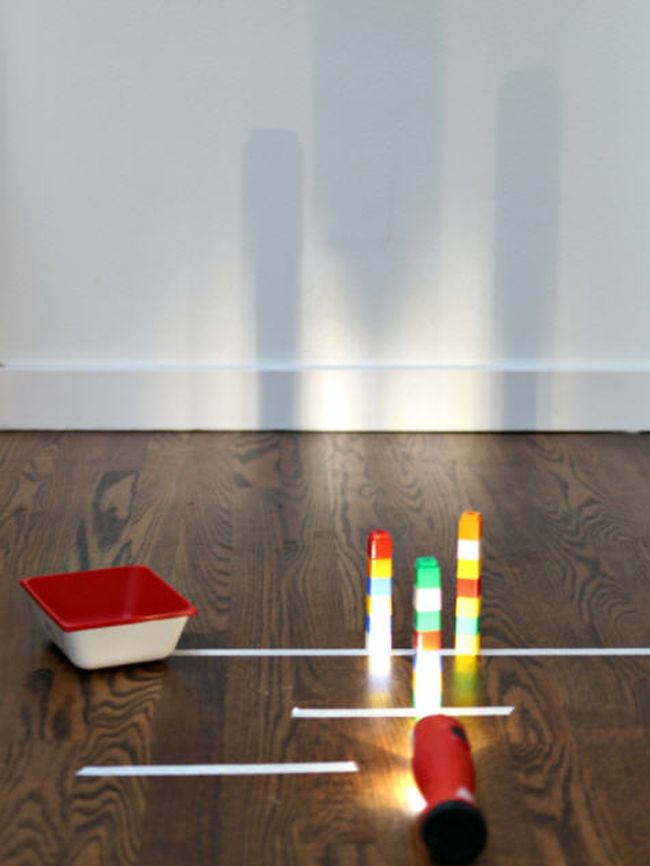
STEM Challenge: Science (Physics)
Here’s another tower-building challenge, but this one’s all about shadows! Kids will experiment with the height of their tower and the angle of their flashlight to see how tall of a shadow they’re able to cast.
Learn more: Shadow Towers at No Time for Flash Cards
45. Devise a recycled toy bot
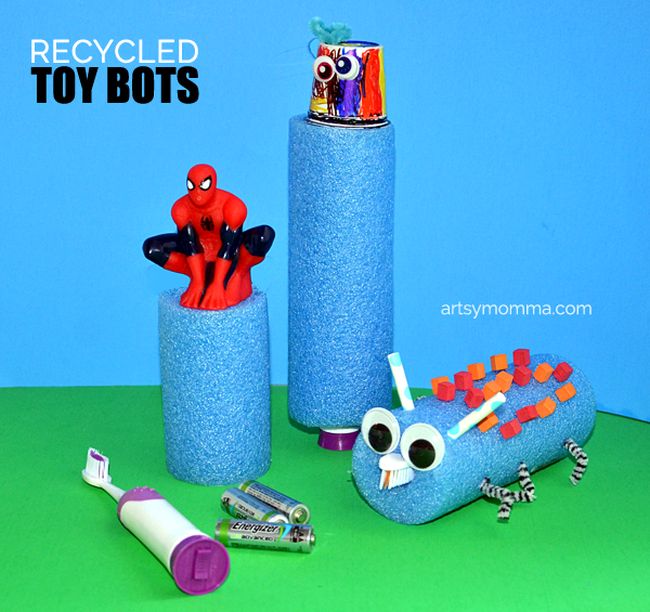
These adorable toy bots are made from pool noodles and recycled electric toothbrushes. So clever! Kids will have fun designing their own, plus they can tweak this idea to make other fun wiggling toys.
Learn more: Recycled Toy Bot at Artsy Momma
46. Link up the longest paper chain
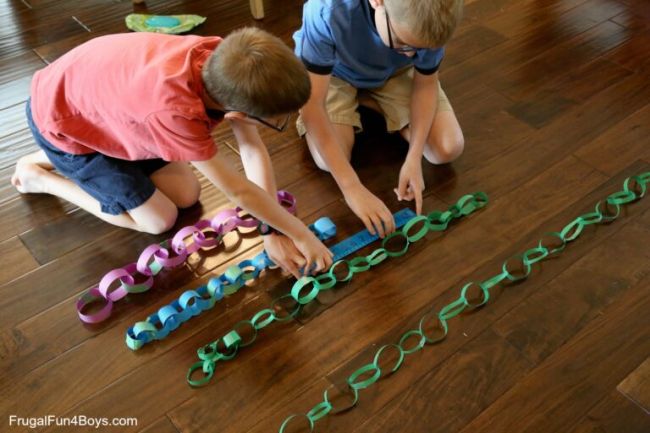
This incredibly simple STEM activity really gets kids thinking. The challenge? Create the longest-possible paper chain using a single piece of paper. So simple and so effective.
Learn more: Paper Chain Challenge at Frugal Fun for Boys and Girls
47. Find out what you can make from a plastic bag
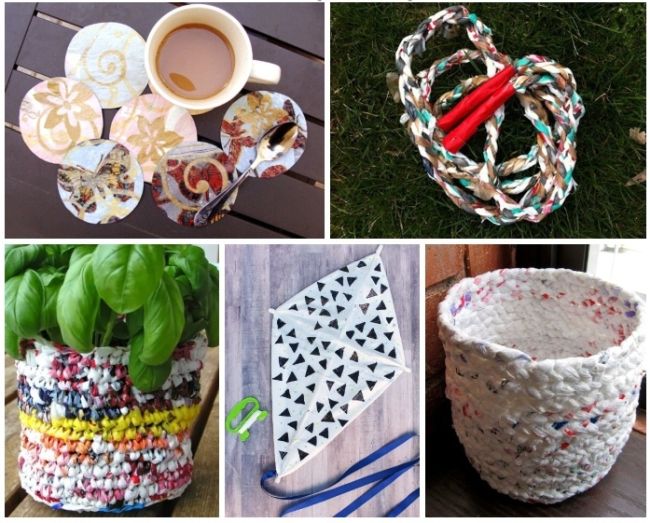
STEM Focus: Science (Environmental Science), Engineering
Plastic bags are one of the most ubiquitous items on the planet these days, and they’re difficult to recycle. Give each student a plastic bag and ask them to create something new and useful. ( These ideas from Artsy Craftsy Mom offer some inspiration. )
48. Start a school robotics team
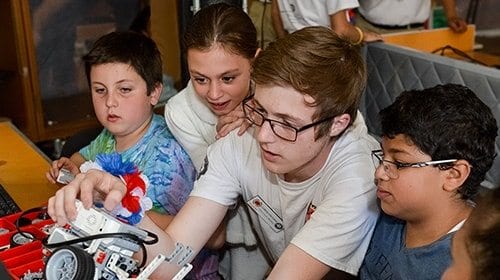
STEM Focus: Technology
Coding is one of the most valuable STEM activities you can include in your classroom plans. Set up a school robotics club and inspire kids to embrace their newfound skills! Learn how to set up your own club here.
49. Embrace the Hour of Code
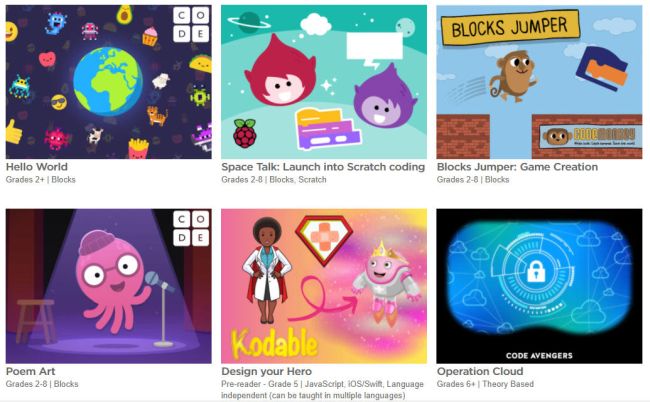
The Hour of Code program was designed as a way to get all teachers to try just one hour of teaching and learning coding with their students. Originally, the Hour of Code event was held in December, but you can organize yours any time . Then, continue to learn using the huge amount of resources on Hour of Code’s website .
50. Give kids a Maker Cart and a pile of cardboard
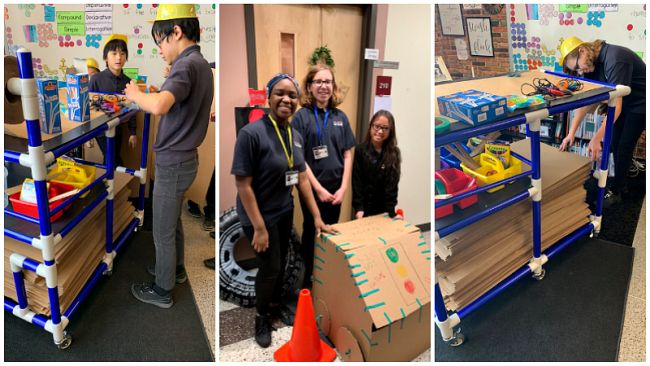
You don’t need a whole lot of fancy supplies to create a STEM Cart or makerspace. Scissors, tape, glue, wood craft sticks, straws—basic items like these combined with a stack of cardboard can inspire kids to create all sorts of amazing projects! See how these STEM activities work here.
What are your favorite STEM activities for kids? Come share in the We Are Teachers HELPLINE group on Facebook .
Plus, get 20+ free stem posters for your classroom .
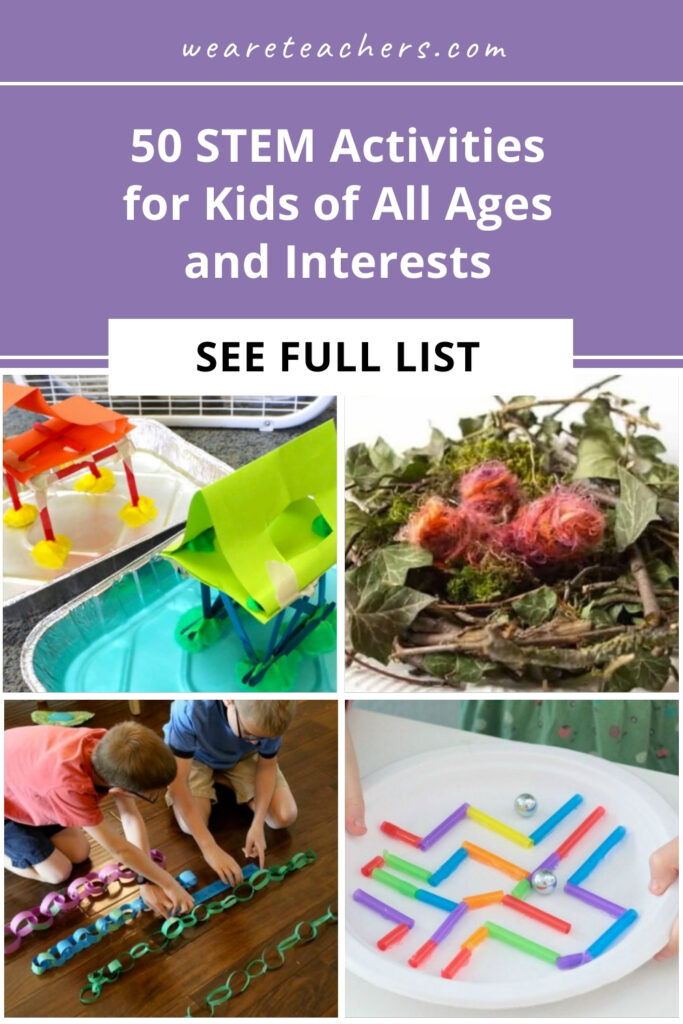
You Might Also Like
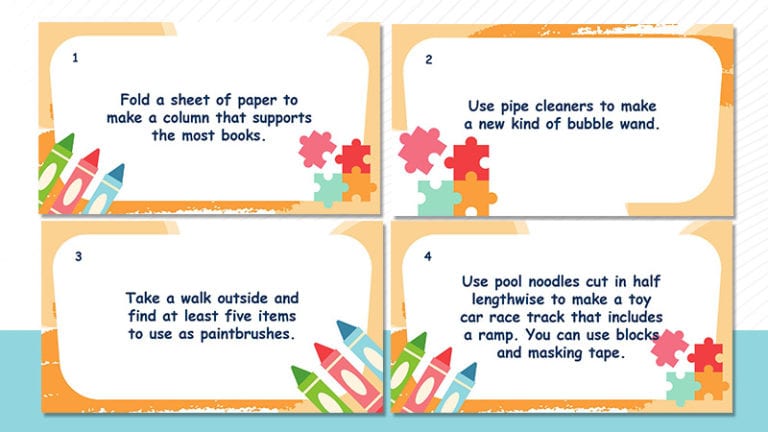
25 Kindergarten STEM Challenges That Little Ones Will Love
They're never too young to create and explore! Continue Reading
Copyright © 2024. All rights reserved. 5335 Gate Parkway, Jacksonville, FL 32256
Creative Problem Solving Activities for Kids
Lawrence koenig.

Creative thinking is a true sign of intelligence, educational research shows. Developing your students' abilities to solve problems creatively will help them advance in life and solve problems by encouraging them to think outside the box. Giving them problem solving activities helps them exercise their thinking muscles and creates a fun and challenging learning environment for your classroom.
Explore this article
- The Penny Problem
- Deductive Reasoning
- Toxic Waste
- The Great Egg Drop
1 The Penny Problem
Many Americans are in favor of banning the penny -- even congressmen. In 2006, Rep. Jim Kolbe entered a bill into Congress for eradicating the penny because they are expensive to make and too many wind up in jars at home. Have your students make up a chart that discusses the pros and cons of using the penny and creative ways to get pennies back into circulation. You can discuss using coin counting machines, how to use them as change, the value of wrapping pennies and if it is worthwhile to keep pennies in the United States exchange system. Have your students come up with creative ways they can use pennies in the community, such as collecting them for charity and school fundraising efforts.
2 Deductive Reasoning
For a quiet, solitary activity that will develop their creative thinking skills, consider introducing logic problems that will help your students come up with answers through deductive reasoning. Teaching children deductive reasoning allows them to think about the answers based not on what they are told, but what they can reason on their own and allows them to develop their own creative thinking skills. Logic problems force students to think outside of the box. There are many logic problems available online for gifted and exceptional students whose minds you will want to challenge in creative ways.
3 Toxic Waste
With today's students more environmentally conscious than ever, using an environmentally themed project that calls for creative thinking skills is ideal for your classroom. Toxic Waste is a group activity in which students move imaginary toxic waste to a neutralization container. Create a circle on the floor at least 8 feet in diameter and label this the "radiation" zone. Place a bucket full of water or balls in the center. Give your kids a selection of tools -- some useful, some not -- to help them transfer the water from the bucket to the neutralization container that is at least 30 feet away. Suggestions for tools include cane poles (or fishing poles) and bungee cords, along with smaller buckets, cups and other items that can empty the bucket. There should be a time limit of 20 minutes as students inside the "radiation zone" will be docked minutes for participation. This is a great team activity that will cause a great deal of debate and cooperation with a lot of creative thinking to solve the problem as a group.
4 The Great Egg Drop
A great cooperative activity that coincides with both Easter and the better weather that comes with spring is the Great Egg Drop. This is a cooperative activity that will get your students outdoors and working in groups with a fun theme based on physics, marketing skills and inventiveness. Challenge your kids to build a single egg package that will sustain a fall from the top of a supermarket shelf, which on average is 8 feet. Give your students as much time as you think necessary and have them work in groups of four or five. Assemble a sheet of items needed and allow them to bring to school whatever else they think will work, such as bubble wrap or peanut packaging. Students also will need to make a 30-second advertisement to sell their idea to potential investors.
- 1 Missouri Department of Education: Cooperative Problem Solving Tasks
About the Author
Lawrence Koenig has been a technical writer since 1988. His expertise includes the U.S. military, hospitality and transportation industries. Koenig holds a Bachelor of Science in literature from Oral Roberts University and he is pursuing a Master of in Education.
Related Articles

Activities to Teach Children About Going Green

The Great Pumpkin Quiz

How to Recycle Plastic Six-Pack Rings for Cans

How to Break in My Shoes That Are Too Stiff Around...

Indoor PE Activities

Carnival Booth Ideas for High School

The Effect of the Population on the Ecosystem

Urban Sprawl Pros Vs. Cons

The Advantages of Brainstorming

What Are the Benefits of Recycling Steel?

How to Recycle Plastic Drums

Teamwork Activities for Kids That Promote Collaboration

How to Make a Native American Pow Wow Drum

How to Make a Sleeping Potion

Crime Scene Classroom Activities

The Easiest Way to Recycle Styrofoam

Benefits Of Supercooling

Rainwater Harvesting Projects for Kids

Bible Science Experiments for Kids

How to Get Tarnish Off of a Gold Necklace
Regardless of how old we are, we never stop learning. Classroom is the educational resource for people of all ages. Whether you’re studying times tables or applying to college, Classroom has the answers.
- Accessibility
- Terms of Use
- Privacy Policy
- Copyright Policy
- Manage Preferences
© 2020 Leaf Group Ltd. / Leaf Group Media, All Rights Reserved. Based on the Word Net lexical database for the English Language. See disclaimer .

How to Help Your Kids Discover Their Creative Side: A Guide
N urturing creativity in children is a gift that can last a lifetime. It not only provides them with an outlet for self-expression but also enhances their problem-solving skills, boosts confidence, and fosters a love for learning. In this comprehensive guide, we’ll explore various strategies and activities to help your kids unlock their creative potential.
From providing an abundance of art supplies to encouraging outdoor adventures, we’ll delve into specific ideas that can inspire your children to embrace their creativity wholeheartedly. By the end of this guide, you’ll have a toolkit of approaches to empower your kids on their journey of artistic and imaginative discovery.
Art Supplies Galore
The foundation of any creative journey often begins with the right tools. Create a treasure trove of art supplies, from colored pencils and watercolors to clay and sketchbooks. Having an array of materials readily available not only sparks artistic exploration but also allows your children to experiment with different mediums and techniques, fostering a deeper connection to their creative side.
Their Own Sewing Equipment
Introducing your kids to the world of sewing can be a delightful and practical creative outlet. Consider providing them with their own sewing machine or a set of beginner-friendly sewing tools. There are sewing machines suitable for children that offer simplified controls and safety features to ensure a fun and secure sewing experience. Sewing not only encourages fine motor skills but also allows them to design and craft their own clothing, accessories, and home decor, nurturing their sense of individuality and style.
Musical Instruments and Lessons
Music is a universal language that ignites creativity and passion. Encourage your kids to explore their musical talents by providing access to instruments like keyboards, guitars, or even a simple set of drums. Enroll them in music lessons or classes to develop their skills and appreciation for melodies, rhythms, and the joy of creating harmonious sounds.
Cooking and Baking Together
The kitchen is a canvas for culinary creativity. Involve your children in cooking and baking adventures where they can experiment with flavors, textures, and presentations. From decorating cookies to inventing their signature dishes, cooking together not only sparks creativity but also teaches valuable life skills and fosters an appreciation for the art of gastronomy.
Encourage Storytelling and Writing
The power of words and storytelling is a profound way to nurture creativity. Encourage your kids to write stories, poems, or journals. Provide them with colorful notebooks and writing prompts to ignite their imagination. Reading together and exploring different literary genres can inspire their storytelling abilities, enhancing their language skills and imaginative thinking.
Outdoor Creative Adventures
The great outdoors is a boundless playground for creativity. Organize outdoor adventures that allow your children to connect with nature, whether it’s painting landscapes, building forts in the woods, or embarking on nature scavenger hunts. These experiences not only inspire artistic expression but also instill a deep respect for the environment and a sense of wonder about the world around them.
Celebrating Creative Achievements
Encouraging your children’s creative pursuits extends beyond providing them with the tools and opportunities to explore their talents. It’s equally important to celebrate their creative achievements, no matter how small or significant. Recognizing and applauding their efforts not only boosts their self-confidence but also reinforces the value of creativity in their lives.
Whether it’s displaying their artwork proudly on the fridge, framing a story they’ve written, or attending their recitals and performances, showing genuine appreciation for their creative endeavors fosters a sense of accomplishment and motivates them to continue exploring their imaginative side. By celebrating their creative achievements, you create an environment where creativity is not just encouraged but cherished, paving the way for a lifetime of artistic exploration and self-expression.
In the journey of helping your children discover their creative side, the possibilities are as endless as their imagination. Providing them with a rich tapestry of art supplies, their own sewing equipment, musical instruments, and culinary experiences set the stage for creative exploration. Encouraging storytelling and outdoor adventures further enrich their creative journey. As they express themselves through various mediums and experiences, they not only develop essential skills but also build a lifelong appreciation for the arts and the boundless wonders of the world.
Embrace these creative adventures together, and watch your children’s imaginations flourish as they paint the canvas of their lives with creativity and joy.
The post How to Help Your Kids Discover Their Creative Side: A Guide appeared first on Sunny Sweet Days .

THE 10 BEST Khabarovsk Rainy-Day Activities
Best activities for a rainy day in khabarovsk.
- 5.0 of 5 bubbles
- 4.0 of 5 bubbles & up
- Good for a Rainy Day
- Good for Kids
- Budget-friendly
- Good for Big Groups
- Good for Couples
- Good for Adrenaline Seekers
- Adventurous
- Hidden Gems
- Honeymoon spot
- Things to do ranked using Tripadvisor data including reviews, ratings, photos, and popularity.

1. Khabarovsk Regional Museum Named After N.I. Grodekov
2. North Park

3. Spaso-Transfiguration Cathedral
4. Platinum Arena
5. Okladnikov Archaeology Museum
6. Museum World of Talking Machines
7. Fishes of Amur River Museum

8. Khabarovsk Theater of the Young Spectator

9. Grado-Khabarovsk Cathedral of the Assumption of the Mother of God

10. Innokentiy Irkutskiy Temple
11. Museum of History of Khabarovsk

12. Khabarovsk Regional Musical Theater

13. Artservatory

14. Triada Chamber Theater

15. Puppet Theater

16. Khabarovsk Krai Drama Theater

17. Mall NK-City

18. Cathedral of the Nativity of Christ

19. Shopping-Entertainment Center Gorizont

20. Khabarovsk Regional Drama Theater

21. Far Eastern Art Museum
22. Arlequin Childrens Multicenter

23. Fedotov Art Gallery

24. TONUS CLUB

25. Khabarovsk Cinema

26. Fabrika Gryoz

27. Khabarovsk Regional Philharmonic Society

28. Komnata

29. Hollywood

30. First Khabarovsk Dive Centre
What travelers are saying.

THE 15 BEST Things to Do in Khabarovsk Krai
Things to do in khabarovsk krai, explore popular experiences, popular cities in khabarovsk krai.
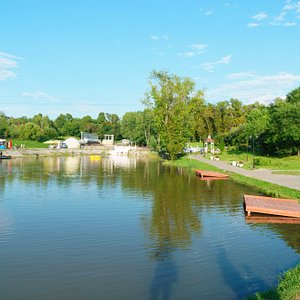
Top Attractions in Khabarovsk Krai

What travellers are saying


COMMENTS
By honing their problem-solving abilities, we're preparing kids to face the unforeseen challenges of the world outside. Enhances Cognitive Growth: Otherwise known as cognitive development. Problem-solving isn't just about finding solutions. It's about thinking critically, analyzing situations, and making decisions.
Children will have to follow the clues and solve puzzles to find the ultimate prize. This activity encourages problem-solving, critical thinking, and teamwork. 7. Scavenger Hunt. Playing Scavenger Hunt can be a fun way for our kids to put their creative problem-solving skills to good use.
Additionally, problem-solving helps children learn how to find creative solutions to challenges they may face both in and out of the classroom. These activities can also be fun and used in cohesion with school or playtime. 17 Fun Problem-Solving Activities for Kids 1. Marble Mazes. This activity was selected because it requires them to think ...
All lines of work need great problem solvers to find tomorrow's solutions, and students of any age can be honing their problem-solving skills. Check out some of these fun problem-solving activities for kids and teens below! Problem-solving activities for elementary school kids (ages 5-10) From traditional paper-and-pencil activities to online ...
For this problem solving activity for older kids or teens, you will need four 2×6 boards. Divide your group into two teams with an equal number of children on each team. Place two of the four boards end to end on the ground or floor. Set the other two parallel to the first two about two or three feet apart.
15 Best Problem Solving Activities for Kids. 1. Rolling Dice. Things you'll need: A die or dice, some flashcards and a pen. How to do: You can play tons of different games with dice. Playing with two dice encourages kids to quickly add up numbers and learn math in a fun way.
Encourage your child to plan their day or week, balancing schoolwork, chores, and leisure. This helps them develop critical time management and prioritization skills. Each of these activities, while mundane, is an opportunity for your child to think critically, make decisions, and solve problems.
6) Quirkle Board Game. If you're looking for problem solving activities for kids you can enjoy as a family, I highly recommend Quirkle! It's easy to play but definitely puts players' problem solving skills to the test, and I love that it's a game the whole family can enjoy! 7) Size of the Problem Activity Pack.
12. The Alphabet Game. This is one of the best cooperative problem-solving activities for kids that improve their problem-solving skills by stimulating their vocabulary, memory, and creativity. It also enhances their spelling and writing skills. To play this game, you will need a piece of paper, a pencil, and a timer.
15 Problem Solving Activities for Kids. There is no better way to learn than by playing. The following exercises are enjoyable and challenge youngsters to demonstrate their problem-solving abilities. Riddles. Riddles for kids are fantastic games for problem-solving. They come at various levels of difficulty.
This activity will help your child develop problem-solving skills as they learn how to balance the materials to create a stable structure. 15. Card Mix Up Games. Cards are versatile playthings that offer many opportunities for problem-solving fun. For example, you can play the classic card game Solitaire.
2. Pretend play. Roleplaying is a fun way to expose your child to new experiences or situations in a safe, low-pressure setting. Join your child in creative play and gently guide them towards scenarios that require problem solving. For instance, if you're playing school, take on the role of a student who doesn't want to do the assigned ...
Problem Solving Activities for Kids that Promote Critical Thinking. Thinking critically enhances knowledge, helps one make independent decisions, and improve creativity. To develop this core skill, you can inculcate some problem-solving activities in their daily routine that they will enjoy doing. 1. Memory game.
Get each child to pick one piece of paper, read it aloud, and come up with creative solutions on the spot to handle the situation. This fun activity will help children in problem identification and resolution, using contemplation. 16. Tic-Tac-Toe. Tic-Tac-Toe is one of the popular problem-solving activities for kids.
4 Problem-Solving Games for Kids. Below are some of the top creative problem-solving games for kids: Puzzles: From simple wooden shape puzzles for toddlers to complex 1,000-piece landscapes for preschool and pre-k aged children, puzzles are the classic problem-solving game. They help children build spatial awareness and critical thinking skills ...
Method 1: Explore and Discover New Things. Exploring and discovering new things is a great way to encourage problem-solving in your child. Let your child explore one new thing a day. This can be something as simple as a new food or flavor, or finding a new toy that they've never played with before.
STEM Focus: Engineering. This is one of those classic STEM activities every kid should try at least once. Kids can do it at any age, with different materials and heights to mix it up. Learn more: Egg Drop at Buggy and Buddy. 3. Engineer a drinking straw roller coaster. Frugal Fun for Boys and Girls.
Devise a slide for mini figures. Make a leprechaun trap. Create a jump ramp for cars. Using at least 4 supplies, build the highest tower you can. Make up your own game - make sure you remember to make rules for how to score and win. Make a device for two people to communicate to one another.
By integrating problem-solving into the fabric of education, we lay the groundwork for a generation adept at tackling obstacles with confidence and ingenuity. The journey towards becoming a problem-solving powerhouse begins early, with strategies that engage children's innate curiosity and resilience.
Creative thinking is a true sign of intelligence, educational research shows. Developing your students' abilities to solve problems creatively will help them advance in life and solve problems by encouraging them to think outside the box. Giving them problem solving activities helps them exercise their thinking ...
5 Puzzle Challenges. Puzzles and brain teasers are effective ways to sharpen creative problem-solving skills. Tailoring these challenges for children's educational programs can involve using ...
Encourage your kids to. write. stories, poems, or journals. Provide them with colorful notebooks and writing prompts to ignite their imagination. Reading together and exploring different literary ...
Khabarovsk Airlines (Хабаровские авиалинии), ☎ +7 (42135) 2-01-10. (NO) Is a public regional airline based in Nikolaevsk-on-Amur with cargo and passenger flights to Okhotsk, Chumikan and Khabarovsk, and serveral other small villages with An-2 & 24 aswell as YAK-40 aircraft. Vostok Airlines (Авиакомпания ...
Images for kids. Vyatskoye's location within Russia. Landsat7 image of Vyatskoye village and camp. See also. In Spanish: Vyatskoye (Krai de Jabárovsk) para niños. All content from Kiddle encyclopedia articles (including the article images and facts) can be freely used under Attribution-ShareAlike license, unless stated otherwise. Cite this ...
As an additional activity we were at the clay workshop, learning to work the clay with a master. Very cheap (100 RUB) activity highly recommended not only for children. Besides, the museum also arranges cultural visits in the Krai. The building itself is a beautiful example of the early 20th century brick architecture of Khabarovsk.
The most popular things to do in Khabarovsk Krai with children according to Tripadvisor travellers are: Khabarovsk Regional Museum Named After N.I. Grodekov; Khabarovsk City Ponds; Muravyov Amursky Park; Monument Muravyevu-Amurskomu; The Bridge Across the River Amur; See all kid friendly things to do in Khabarovsk Krai on Tripadvisor